![]()
ALEJANDRO ARAVENA
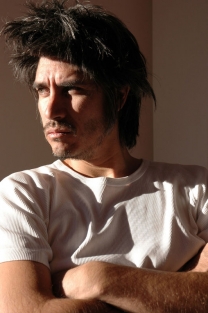
Alejandro Aravena is the principal of Alejandro Aravena Architects and the executive director of Elemental, a do-tank focusing on projects of social impact.
Alejandro Aravena (*1967), architect Universidad Católica de Chile (UC), established Alejandro Aravena Architects in 1994. He was Visiting Professor at Harvard GSD (2000-05) and is currently the Elemental-Copec Professor at UC. He is a member of the Pritzker Prize Jury and has been named an International Fellow of the Royal Institute of British Architects.
Professional work includes educational facilities, institutional, corporate and public buildings, museums, houses and housing.
Awards include the 2006 Erich Schelling Architecture Medal (Germany), the Silver Lion at the 2008 Venice Architecture Biennale, the 2009 Avonni Innovation Award, and the 2010 Marcus Prize for Architecture, among other prizes.
His Books include Los Hechos de la Arquitectura, El Lugar de la Arquitectura and Material de Arquitectura, as well as a monograph on Elemental published by Actar that will be published in 2010.
Publications on his work include the monograph Alejandro Aravena, progettare e costruire published by Electa; Kenneth Frampton’s fourth edition of Modern Architecture; a Critical History; Thames & Hudson’s 60 Innovators Shaping Our Creative Future; and books by Phaidon and Taschen. Magazines include GA (Japan); Icon, Monocle and Architectural Review (UK); Casabella, Lotus, Abitare, The Plan and Domus (Italy); Arquitectura Viva and Verb (Spain); Detail and Arch+ (Germany); Mark and Volume (Netherlands); Architectural Record, Dwell, Praxis and Perspecta (United States); and others in more than thirty other countries.
Exhibitions on his work have been held at Harvard GSD (2004), Sao Paulo Biennale (2007), Venice Architecture Biennale and Milan Triennale (2008), among other places.
Since 2006 he has been Executive Director of ELEMENTAL S.A. a for profit company with social interests that works on projects of infrastructure, transportation, public space and housing, and is partnered by the Universidad Católica de Chile and COPEC (Chilean Oil Company).
ELEMENTAL is a for profit company with social interest, whose shareholders are the Universdad Católca de Chile, COPEC (Chilean Oil Company) and the Elemental founders.
Its field of action is the city: the development of housing, public space, infrastructure and transportation projects that can perform as an effective and effiicent upgrade in the quality of life of the poor. ELEMENTAL operates in contexts of scarce resources, using the city as a source of equality, and moreover, as a shortcut to correct inequalities.
When Elemenal began in Harvard University in 2000, social housing was associated with a lack of economic and professional resources that had generated a lack of options for poor famlies. Elemental wanted to change this negative association, using professional skills to work with social housing. Elemental now defines itself as a Do Tank that seeks to upgrade people’s quality of life. Our point was to generate technical conditions that can guarantee an effective process of gaining value over time. Without changing the rules of existing polcies and conditions of the market Elemental develops and constructs strategic urban projects through the application of specific design criteria.
Three projects have been selected to reflect our work phlosophy. Elemental Iquique was the first project in Chile that exemplified the application of the design criteria and confirmed, 5 years after it construction, the strong value increase of houses and the neighborhood. The other two projects represent two faces of our new chalenge: to replicate the strategic points for confronting the housing deficit of the world poor. SCALE and SPEED will be needed to house the 2 billion impoverished urban inhabitants projected in 2030. The Prefab Prototype and Elemental Monterrey represent, respectively, the Elemental strategy to face this planetary scope.
ELEMENTAL’s first project in Iquique, back in 2001, consisted in reestablishing 93 families on the site where they had been squatting for the last 30 years with a budget of just US$7,500 per family. This opportunity allowed ELEMENTAL to test the previously developed design criteria for ensuring the value appreciation of each unit so that social housing could become a social investment instead of a social expense. Success was achieved by clearly identifying the restrictions and then working with the families themselves in participative workshops, proving feasibility on a local level. The results? People were able to double the square meters of their initial homes (36 square meters) for only US$1.000 each. 5 years later, any house in the Elemental Iquique project is now valued at over US$20.000.
In 2008 he was named one of the 20 essential young architects by Icon magazine and won the Silver Lion for “most promising architect” at the Venice Biennale. In 2009 he won the Marcus Prize for Architecture, which recognises emerging talents, and was one of 10 recipients of RIBA’s 2010 International Fellowships.
Aravena also sits on the jury for the internationally acclaimed Pritzker Architecture Prize and held visiting professorship at Harvard University from 2000 to 2005. He is the Elemental Copec Professor at the Pontifical Catholic University of Chile.
“I really appreciate having been trained in an environment of scarcity. Somehow it’s a very efficient filter against what’s not strictly necessary. There’s not enough money, not enough time, to answer with tools that are not exactly the ones you need for that question.” Alejandro Aravena
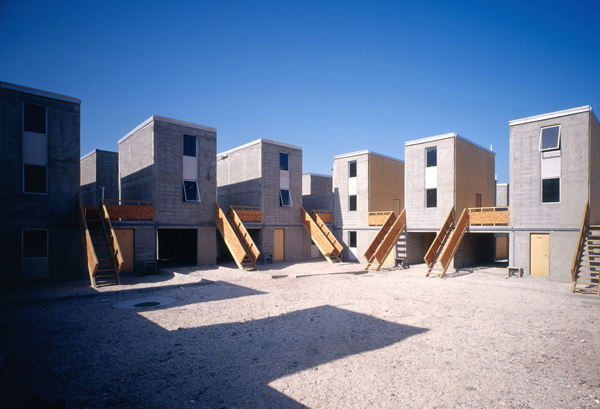 |
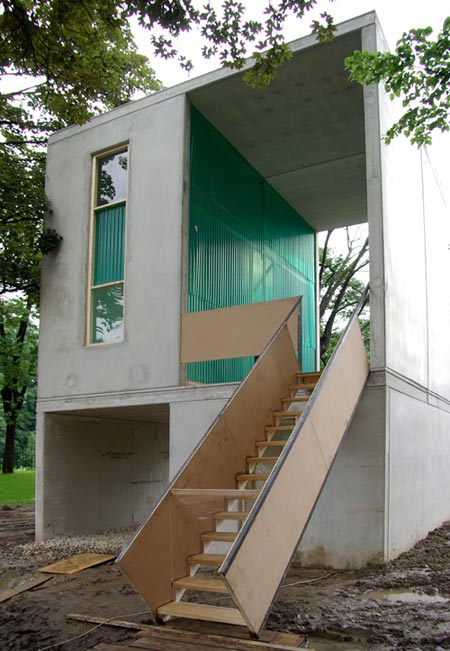 |
Quinta Monroy, Iquique, Chile. Photographer Cristobal Palma (L.)
Prototype House, Milan Triennale Garden, Italy (R.)
 |
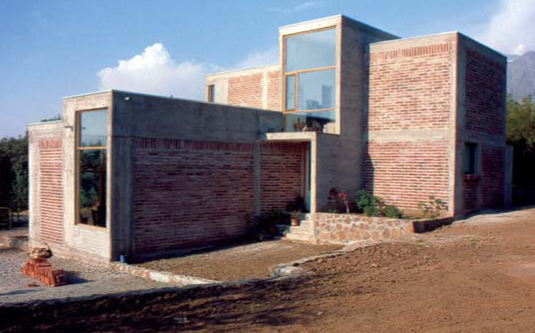 |
Pirehueico House, Pirehueico Lake, Chile (L.)
Sculptor House, Santiago, Chile (R.)
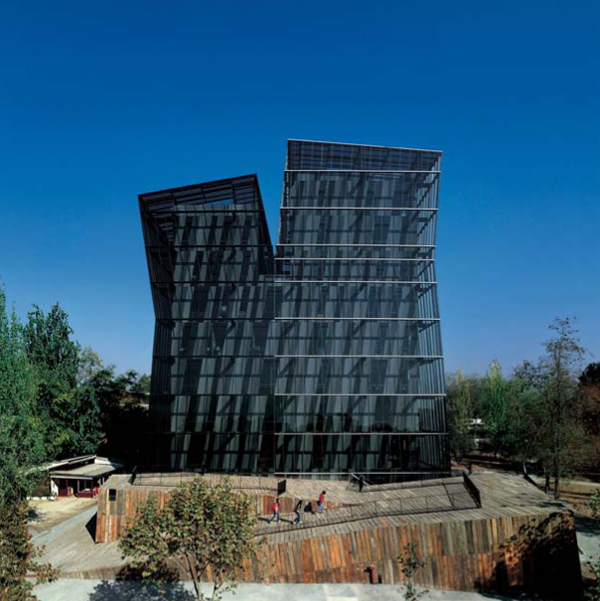 |
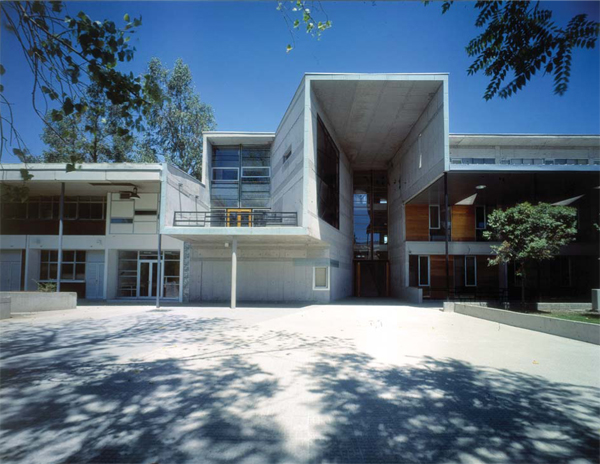 |
The Siamese Towers, Santiago, Chile (L.)
Mathematics Faculty, Santiago, Chile (R.)
Suggested:
http://abduzeedo.com/architect-day-alejandro-aravena
http://alejandroaravena.com/obras/vivienda-housing/elemental/
http://justinmcguirk.com/alejandro-aravena
RORY MacARTHUR
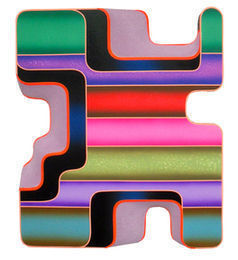
Earthling, 2013
Rory MacArthur is a British artist who was born in 1964. MacArthur lives and works in New York, recent exhibitions include ' The difficult shapes of possible images' curated by Douglas Melini, Ziehersmith gallery, NYC 2006, ‘Pantone’ curated by David Hunt, Massimo Audiello, NYC 2004, Kenny SchachterconTEMPorary, NYC 2003, Art Resources Transfer, NYC, ‘Tensionism’ curated by Kenny Schachte
Rory MacArthur’s series is an ambitious investigation into what the artist perceives as the limitless possibilities of non-representational painting. Borne of voluminous, fastidious preparatory drawings, many of which are realized as final works, these candied beauties, all pink, green and melted, exemplify a thoroughness of approach that is important to emphasize in light of their effortless appearances. From an elaborate but direct process involving the repeated carving, sanding and sealing of multiple layers of Styrofoam, the painting, applied to its labor intensive substrata with both roller and air, enamels its topographic playground like a seductive skin, undermining and underlining the inherent physicality. The artist create forms that highlights the manipulation of color in order to create abstract space through two very different methods.
Firmly in the camp of abstraction, Rory MacArthur makes sculptures and reliefs that render visually the aural experience of electronic music. For MacArthur Abstraction makes sense, it works as a vehicle for communicating phenomenological experience. The finished work begins as a sketch, either pencil on paper using sine wave templates (a purely formal choice but an amusing coincidence? when considering his original reasons for pursuing abstraction i.e sine wave = sound wave = pictorial representation of sound). The drawing is transferred into the third dimension by carving styro foam and covering in resin. This support is painted to emphasize or undermine the physicality of space creating a visual dis-orientation which relies on the illusionistic qualities of color. The intended result: a phenomenological, post-industrial mutant hybrid or something.
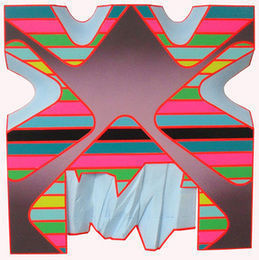 |
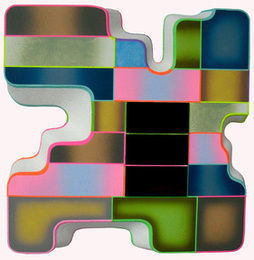 |
Oceanic, 2012 (L.)
Stromness, 2012 (R.)
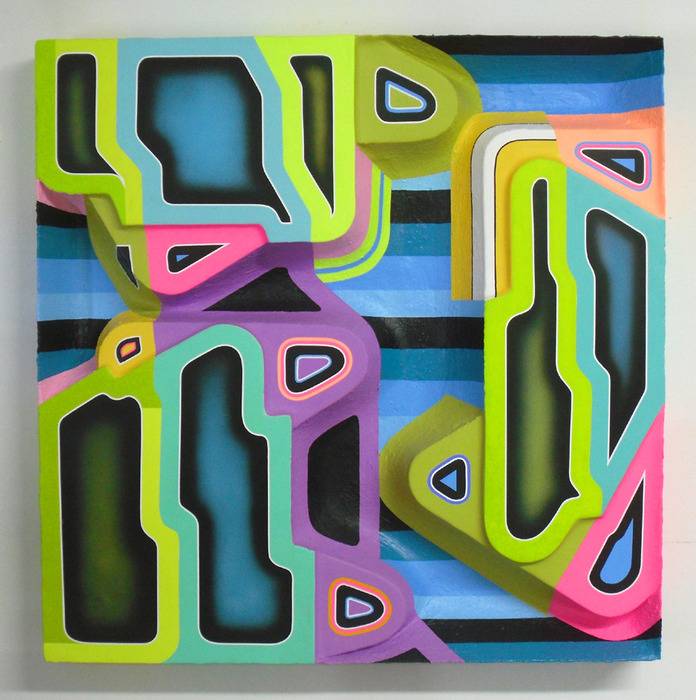
Aswan, 2010
Suggested:
https://artsy.net/artist/rory-macarthur
http://www.markelfinearts.com/artist/Rory_MacArthur/biography/
http://roveprojects.com/
SERGE ALAIN NITEGEKA
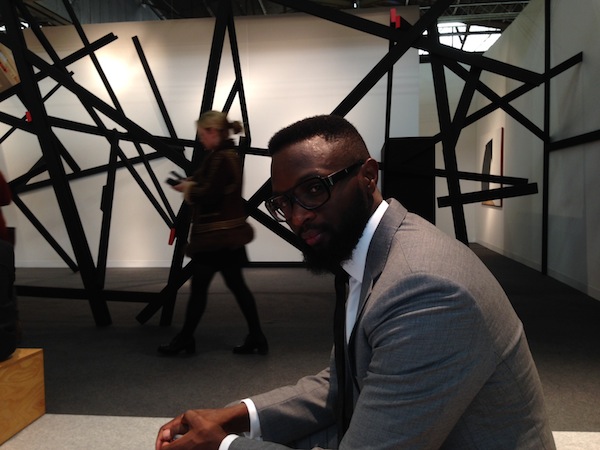
Nitegeka was born in Burundi in 1983 and lives in Johannesburg. He has been living in Johannesburg since 2003. He completed his undergraduate studies in 2009 and is currently finishing his Master’s degree at the University of the Witwatersrand. He won the Robert Hodgins Prize at Wits University in 2008, and the Tollman Award for the Visual Arts in 2010. He was selected for the Dakar Biennale in 2010 and awarded a Fondation Jean Paul Blachère prize. He was a festival artist at the National Arts Festival in Grahamstown in 2011, showing a new installation in the Gallery in the Round. Group exhibitions include Space, Ritual, Absence: Liminality in South African visual art at the FADA Gallery, University of Johannesburg (2011); Time’s Arrow at the Johannesburg Art Gallery (2010); and Beyond the Line at the Goethe-Institut in Johannesburg (2008). Serge Alain Nitegeka is included on My Joburg at La Maison Rouge, Paris (21 June – 22 September 2013), and on This House, part of Nouvelles vagues, a program of exhibitions by young curators at the Palais de Tokyo, Paris (20 June – 9 September 2013).
He won the Tollman Award for the Visual Arts, and a Fondation Jean Paul Blachère prize at the Dakar Biennale, in 2010. He has exhibited at the National Arts Festival in Grahamstown (2011), and Le Manège gallery at the French Institute in Dakar (2012). Group exhibitions include Space, Ritual, Absence: Liminality in South African visual art at the FADA Gallery, University of Johannesburg (2011); Time's Arrow at the Johannesburg Art Gallery (2010); and Beyond the Line at the Goethe-Institut, Johannesburg (2008).
Nitegeka’s initial work operated around the notion of inserting himself into the role of the forced migrant. A seminal body of work produced while he was still an undergraduate consisted of expressive, compelling large-scale self-portraits in charcoal on packaging crates. As with all his subsequent work, the approach was strongly autobiographical: he was forced to flee his native Burundi due to civil war in the early '90s.
Continuing his education in Johannesburg and becoming a legal resident as soon as he was able, he was nonetheless marked by this sense of dislocation, and of his status as a migrant, as human cargo. His evolving understanding of his situation came with a sense of the ubiquity of his experience, and although his initial works predominantly utilised his own face and body, they resonated with many in South Africa.
Since around 2009 he has been experimenting with more allusive imagery: neo-minimalist paintings from his ‘Fragile Cargo’ series saw the artist using silhouettes of himself amidst forests of structures, the looming black and grey scaffolds, ladders and sometimes amorphous volumes dwarfing and obscuring the figures.
Notes of flat, iconographic color were inserted into these otherwise monochromatic works: lines of red paint, and panels of yellow wood grain emerge to marshal one’s eye around the compositions, in a manner suggestive of diagrammatic arrows and markings. There is also a sense that these works quietly upend some of the strategies employed by Piet Mondrian in his De Stijl works, where grids of black, white and grey are punctuated with sharp, primary colours. Yet, while Mondrian’s intentions were to postulate a new aesthetic and social purity, Nitegeka’s couldn’t be further away, imaging instead the labyrinth of obstacles and metaphorical structures that impede the progress of the forced migrant.
Most recently, Nitegeka has moved into pure installation, as if the structures from the ‘Fragile Cargo’ paintings needed to come to life in three dimensions. Works such as Tunnel shown on the group show ‘This is Our Time’ and '...and walk in my shoes.' shown at the 2011 Grahamstown National Arts Festival literally enter and disrupt the viewer’s space. The figures that had appeared in Nitegeka’s paintings are replaced in these installations by the viewer’s body: ‘I have removed the rendered figure from this work, but you, the viewer, become that body. I'm giving that role to whoever is in the space for that moment.’
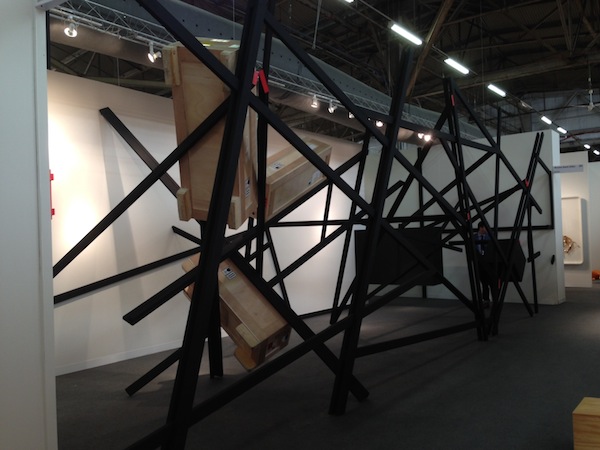
Artist’s statement
‘My work investigates the concept of liminality in the frame of forced migration. I study the in-between state and space in which some marginal individuals such as asylum seekers and refugees find themselves. I am interested in the possibilities through which the human form can be stripped down and reduced into simple lines that articulate the relationship between movement and load.
This concept is explored through site-specific installations that depend on the viewers’ participation to be complete. The installations are realized through slight/total transformation of familiar and ordinary space/s so as to command the body to behave and move in a directed way, almost as if to perform a ritual. The idea, or rather the metaphor, is to get the viewers to experience what it may be like for refugees and asylum seekers to cross borders and boundaries, to be in unfamiliar space of different cultures, or to negotiate the mazes of social-political systems and foreign diets.’

Installation view: Tunnel VIII, 2013 Paint on wood and crates The Space Between Us, IFA Galleries, Berlin

Installation view: Structural-Response 1, 2012 Paint on wood Institut Francais, Dakar

Installation view:...and walk in my shoes, 2011 Paint on wood Gallery in the Round, Grahamstown, SA
Serge Alain Nitegeka showed a new installation on The Space Between Us at ifa Galleries, Berlin, and was included on My Joburg at La Maison Rouge, Paris, and the Staatliche Kunstsammlungen Dresden, in 2013. His next solo exhibition takes place at Stevenson Johannesburg in August 2014.
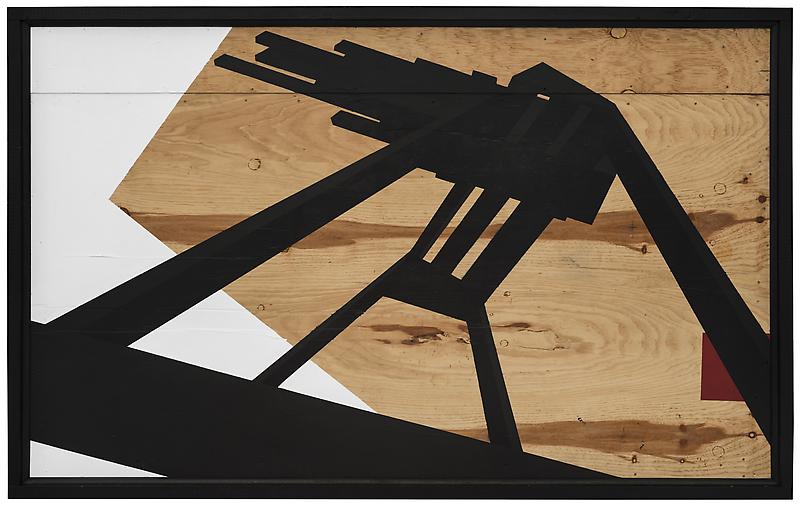
Exterior I: Studio Study I, 2013
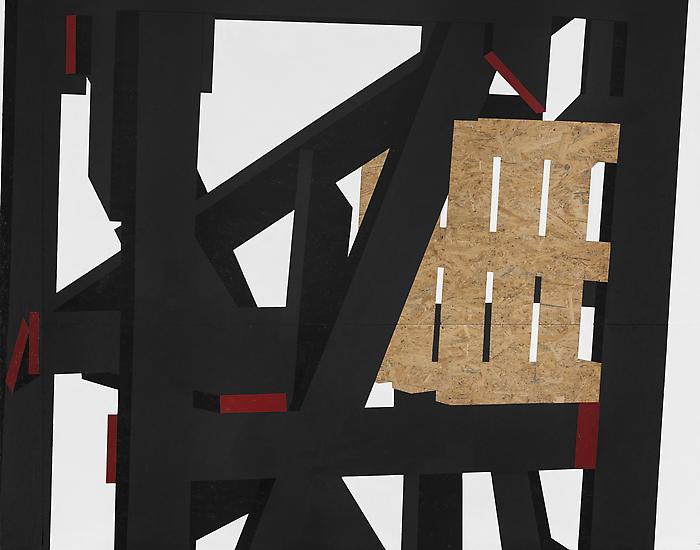
Fragile Cargo X: Studio Study I, 2013
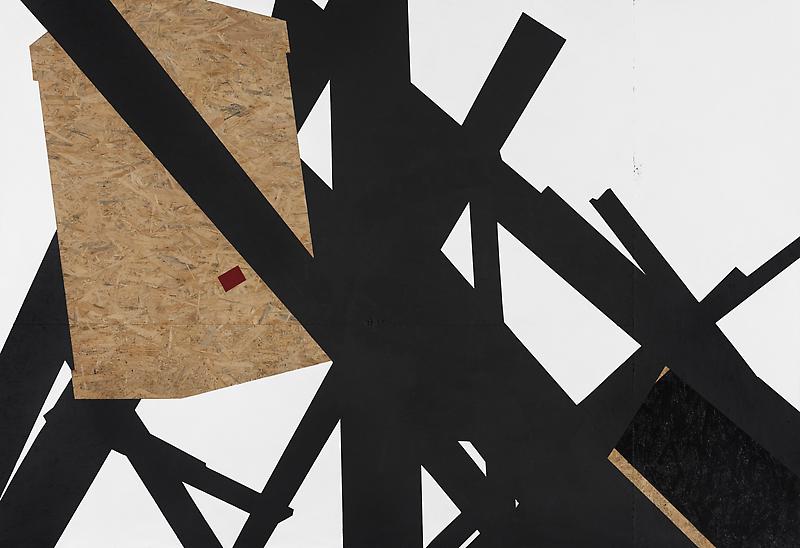
Tunnel VIII: Studio Study VI, 2013
Suggested:
http://www.marianneboeskygallery.com/artists/serge-alain-nitegeka/works
http://www.stevenson.info/artists/nitegeka.html
http://www.voanews.com/content/serge-alain-nitegeka-from-refugee-to-acclaimed-artist-141570273/181386.html
http://www.ifa.de/en/visual-arts/ifa-galleries/past-exhibitions/the-space-between-us/serge-alain-nitegeka.html
IBRAHIM MAHAMA
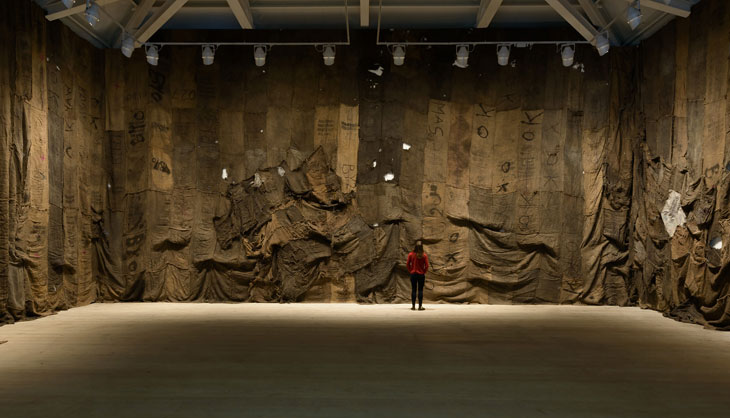
INSTALLATION SAATCHI GALLERY
Ibrahim Mahama lives and works in Tamale, Ghana. His work has been installed in various public locations in and around Kumasi and Accra, Ghana; and at KNUST Museum, Ghana.
26 year old Ibrahim Mahama is of a new generation of artists that is redefining what art can be, how it is exhibited and how it interrogates our relationships with ourselves and our surroundings. He creates out of a commonplace material. Jute sacks imported by the Ghana Cocoa Board and repurposed by charcoal sellers are again repurposed by the artist, and exhibited in the very places they are sold.
Whether kente, adinkra, or wax print, cloth has long been a semiotic, value-transferring art form in Ghana.
West African born, internationally acclaimed artists, like El Anatsui and Yinka Shonibare have carried on and reinvented this tradition by using bottle tops to take on the form of Kente or wax print to usurp Western historical and aesthetic narratives.
Ibrahim goes a step further by incorporating the provenance, narrative and context of the cloths in his work. Mahama produces the large draping surfaces by carefully assembling sacks imported by the Ghana Cocoa Board and repurposed by charcoal sellers. The sacks present patches, markings and traces of traders’ names and locations on their rough brown skin, which map out the many transits they endure as vessels of commodities. The artist occasionally decorates them with the insertion of mass-produced Chinese–African print patchwork adding yet another layer of interpretation of the global movement of goods. The fact that fabric constitutes a marker of identity as well as a sign of particular occasions in the African context turns these insertions into a kind of portraiture of the wearers.
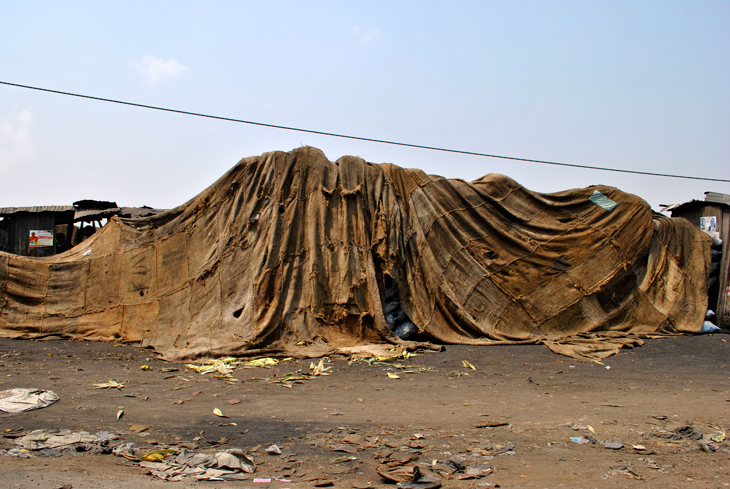
His epic installations move out onto the streets, into marketplaces, under abandoned railway bridges, rendering what is unseen - layers upon layers of rubbish, degradation normalised and neglected by inhabitants and their government - visible.
In his most ambitious work to date, Ibrahim covers the KNUST Museum, both inside and out, in jute cloth to give more obvious form to questions, such as - Is this Art? Who is the Artist? Is this the place for it? What is the relevance of the museum model? And what does it all mean anyway? It took Ibrahim about eight months to put the works together .
Ibrahim describes art as an inherent complex phenomenon and for him getting confused as a cursory onlooker is another way of contributing to the creative work 'because you are causing them to think much more deeply about things that they wouldn't have felt deeply about'.
'I think what people can come and take away is an opening of mind, of soul, and of questioning', said Nana Oforiatta-Ayim, Curator and collaborator for the exhibitor. 'Culture is the very foundation of society and without culture we're nothing, so exhibitions like this one begin to bring arts to our lives, begin to bring these questions into our lives and engender more discussion; and I think the more and more this happens, the deeper look into and awareness of ourselves as a growing society becomes'.
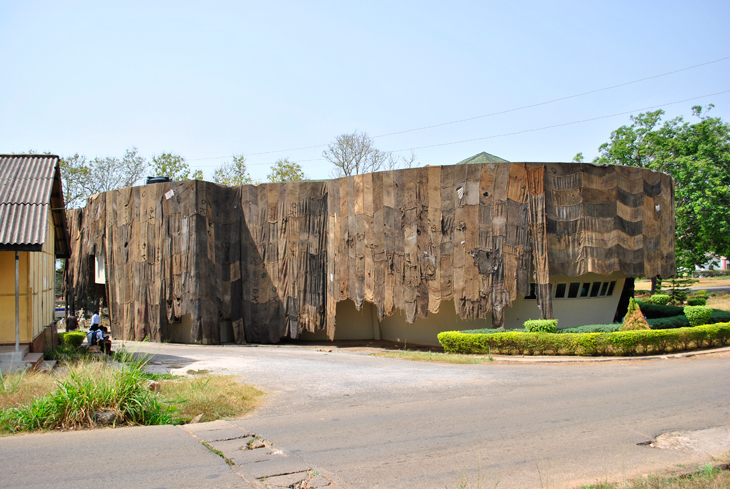
'We were living in arts many years ago, through dance, culture, tattoo and others', he observed. 'It's not something that you actually do that becomes an object that people can actually worship or becomes sacred, it's something that lives in you and translates from every movement, every sweat and every drop of your blood'.
Ibrahim Mahama creates site-specific installations using commonplace and readily-available materials, whilst questioning what the provenance and former use of these material impart on their new formation. Many of these materials have a long production history in Ghana, such as jute sacks, imported by the Ghana Cocoa Board and reused by charcoal sellers. In this particular work these new constructions are then installed back into the sections of street markets the sacks in their original form were sold in. Nana Oforiatta-Ayim describes it thus:
“His epic installations move out onto the street, into market places, under abandoned railway bridges, rendering what is unseen, - layers upon layers of rubbish, degradation normalised and neglected by inhabitants and governments, -visible. “
It is clearly important to Mahama that these works don’t exist in a bubble: the negotiations needed for the collection of the materials, the production processes themselves and the installations reception are all significant.
“…each voice within that ‘public’ but private space determines the outcome of the installations.”
(Ibrahim Mahama)
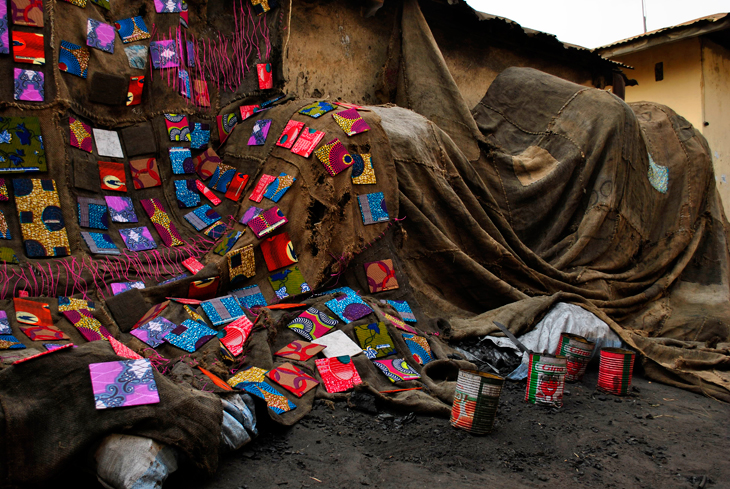
Wrapped around heaps of merchandise in the market place or embracing the contours of a museum building, the spreads of jute fibres become an oversized socio political inquiry of the origin of materials, referencing what is normally hidden for the sake of concept or form. Ibrahim Mahama denudes the transits and ownerships of jute sacks along their lives as porters of goods, rendering visible the mechanisms of trade which define the world’s economy.
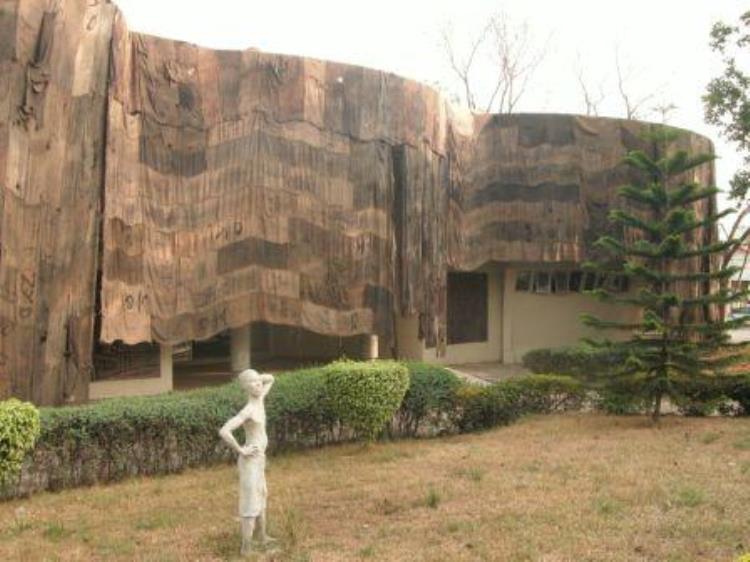
Kunst Museum
Suggested
http://www.saatchigallery.com/artists/ibrahim_mahama.htm?section_name=pangaea
http://ellisking.net/artist/ibrahim-mahama/
OSCAR MURILLO
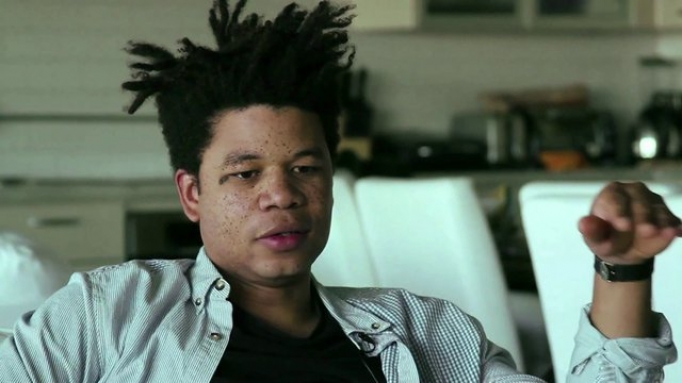
Oscar Murillo’s large-scale paintings imply action, performance, and chaos, but are in fact methodically composed of rough-hewn, stitched canvases that often incorporate fragments of text as well as studio debris such as dirt and dust. His paintings, video works, and performances are tied to a notion of community stemming from the artist’s cross-cultural ties to London, where he currently lives and works, and Colombia, where he was born in 1986.
Murillo earned his B.F.A. in 2007 from the University of Westminster, London, followed by his M.F.A. in 2012 from the Royal College of Art, London. In 2013, the artist joined David Zwirner. His first gallery solo exhibition, titled A Mercantile Novel, was presented at David Zwirner, New York, on view April 24 to June 14, 2014.
Murillo has shown in both solo and group exhibitions at prominent venues worldwide, including new works on view in 2014 in Los Angeles that marked The Mistake Room's inaugural presentation. In 2013, the South London Gallery organized the artist's first major solo exhibition in the United Kingdom. In 2012, he created new paintings on site during a five-week summer residency at the Rubell Family Collection in Miami, which were shown later that year marking his first solo exhibition in the United States. Other recent venues that have exhibited his works and projects include the MAMA Showroom, Rotterdam (2013) and the Serpentine Gallery, London (2012).
In 2014, work by the artist is included in international group exhibitions, including the 1st International Biennial of Contemporary Art of Cartagena de Indias, Cartagena, Colombia; RE: Painted | 'Painting' from the collection, Stedelijk Museum voor Actuele Kunst (S.M.A.K.), Ghent; Fútbol: The Beautiful Game, Los Angeles County Museum of Art; and Don’t You Know Who I Am? Art after Identity Politics, Museum van Hedendaagse Kunst Antwerpen, Antwerp.
For his ongoing project Frequencies, created in collaboration with members of his family and political scientist Clara Dublanc, Murillo will visit schools across the globe where canvases temporarily affixed to classroom desks will register young students' creative and critical thought processes. The project aims to offer cross-cultural and social insights into youth communities around the world.
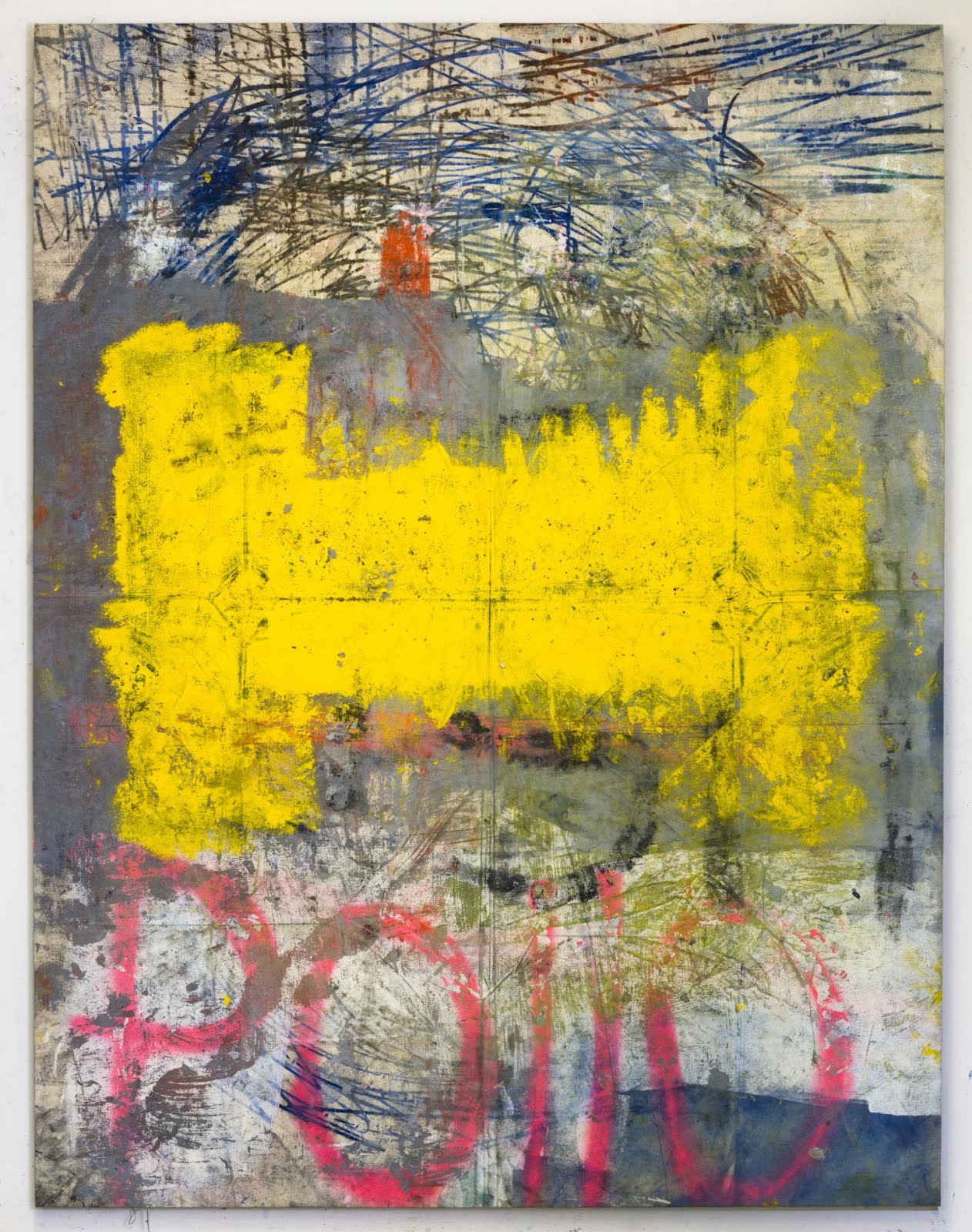
"This is an art of mutation. Materials migrate from one medium to another: a collection of biro drawings gets pulped to become the flooring of a complex installation where disparate objects convene as in an alchemist’s laboratory. Recycled materials and mediums are gestures of adjustment that Oscar Murillo seems to have acquired from his border experience: born in Colombia and emigrating to London as a child, he had to adopt language, customs and cultural codes, being inescapably transformed by the unending process of migration. "
Gabriela Salgado
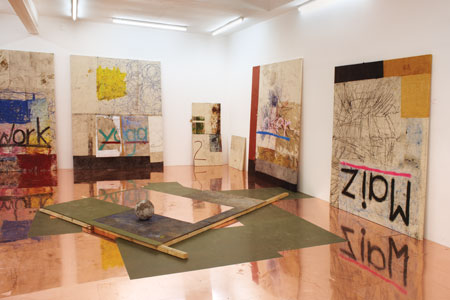
The title of Oscar Murillo’s first London solo show was a mouthful: ‘Dinner at the members club? Yes! i’ll have a black americano first pls’. The titular ‘black americano’ in this case was – by his own admission – none other than the young London-based artist himself, whose Colombian origins are often emphasized in his painterly and performance-based practice (though there were also packs of ground coffee at the gallery, which visitors were welcome to take home). ‘The members club’ was apparently a reference to the ICA committee who had invited Murillo to rustle up something nice and performative for their annual fundraising dinner. He was happy to oblige: his debut exhibition at Carlos/Ishikawa became the setting for a champagne lunch, prepared by the artist with his relatives and served on grimy tablecloths made of ornate fabrics that had been gathering dirt for the occasion.
Welcome to the members club (all works 2013) is also the title of a 42-minute video, which documents the making of lollipops at the factory that employs most people in Murillo’s hometown, La Paila, in the southeast of Colombia. (Packed into boxes on one of the two platforms in the main space, the freely available sweets inevitably recalled Félix González-Torres’s candy piles.) But the artist doesn’t consider rough-and-ready, handheld videos such as this one to be art works in their own right; rather, he uses them to set his practice in context. A similar role is assigned to the social gatherings – such as dinners, yoga sessions, games or dances – that Murillo refuses to call ‘performances’ (though others do that for him), because they strike him as a natural, spontaneous outgrowth of his work, as opposed to an exercise in relational aesthetics of the kind practiced by, say, Rirkrit Tiravanija and his peers.
When it comes to Murillo’s broader output, it’s not always easy to determine what is ‘work’ proper and what is mere support. In a sense, everything at Carlos/Ishikawa was folded into his work’s sociable sphere for the duration of the show, and most of the things on display could be bought when they were not freely given. Yet not all of the objects had the same status. For example, one of the exhibition’s most distinctive features – the reflective copper sheets laid over a low plywood structure – were not art as such, according to the artist, but rather work-in-the-making (to be shown at a later date in a different gallery). Three weeks after the opening, these had lost some of their sheen and were looking tarnished – precisely the effect Murillo strives for. Instead of presenting a finished product, the artist wanted this exhibition to reflect some of the processes that inform his studio practice.
Painting forms the backbone of Murillo’s artistic practice, though rather than a brush he often uses a broom stick and a sizeable oil paint pad, in a sort of rudimentary mono-printing technique. Roughly hewn, stitched-up canvases in two or three different sizes – mostly large – and as many varieties (he calls them ‘banners’, ‘stack paintings’ and ‘bingos’) were hung on, leaned or stacked up against all available walls. Before the mark-making process begins, these are left lying about for a month or two to wear them in and let them gather ‘information’ (what the artist has referred to as the ‘DNA of the studio’). Murillo, who sees mess as a generative force, makes it a point never to tidy up his work environment. There is an archival element to much of the artist’s production, which retains traces of former activities, whether in the shape of single, underscored words and numbers (‘work’, ‘yoga’, ‘poker’, ‘maiz’, ‘3’) that feature prominently on his canvases, or condensed into solid dirt balls made up of studio débris (pulped drawings, thread, cement dye, copper, dust) dotted around the gallery.
‘Dirt’, and sometimes ‘dirt on canvas’, is insistently listed among the artistic media in Murillo’s works. More than just a widely available material, dirt for the artist has a levelling effect: we all experience it, black and white, rich and poor alike. In his eyes, that’s what makes it ‘democratic’. It’s easy to dispute this claim. Dirt is, after all, socially stratified; it belongs to the streets, to some more than others, and grows more scarce the higher one climbs. In some quarters (the art world among them), dirt can be exotic, a rarefied commodity, the mark of originality.
Murillo evidently sees himself as a mediator between different demographics, facilitating encounters between two worlds that would not normally meet – namely the art crowd and the Latin American immigrant community – through the events that he organizes. And yet, at the rehearsal fundraising lunch at Carlos/Ishikawa, the artist’s relatives who cooked tamales for us sat at their own table. The event may well have been intended as a critical comment on the exclusivity of the artist’s dinner, but the message it ultimately put across was as confusing as the exhibition’s title.
Agnieszka Gratza, Frieze Magazine
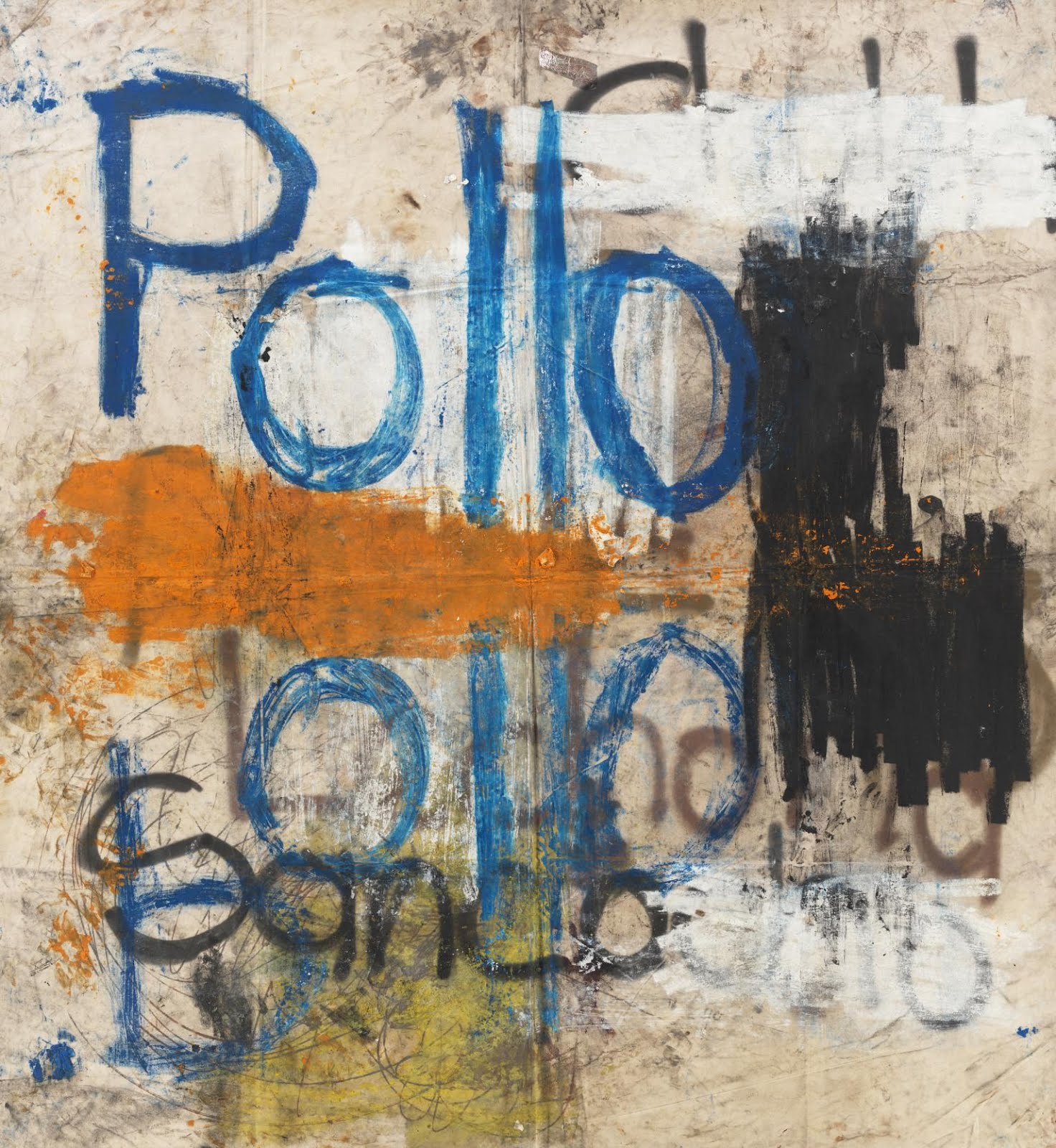
All Images Courtesy D.Zwirner Gallery , New York
Suggested
http://www.culturedmag.com/2014/04/mistake-room/
http://www.davidzwirner.com/artists/oscar-murillo/biography/
http://www.nytimes.com/2014/03/16/arts/design/oscar-murillo-keeps-his-eyes-on-the-canvas.html?_r=0
http://www.frieze.com/issue/review/oscar-murillo/
LAURENT MONTARON
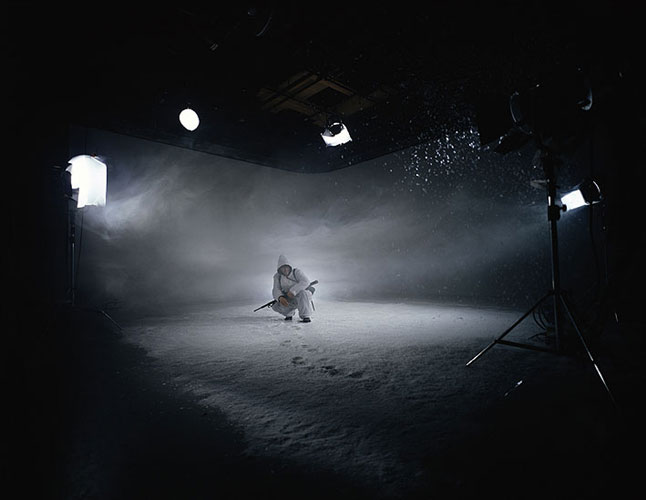
Laurent Montaron is a french artist, based in Paris. He is represented by the Schleicher + Lange gallery. Born in 1972 , Laurent Montaron processes the image (photographic, filmic) and its codes of representation, to explore the possible relationship of the image with narrative and with time. He questions for instance the conjunctions of the image and sound or the image and language. How the artist relates to the cinema is conveyed notably through his interest in the recording process, or yet through a search for spatialisation or reverberation of it, and through a subtle setting in motion of the image, however still it may be. Thus, the attention given to the notion of the itinerary and to the view of layouts is central to Laurent Montaron’s work. In his works, Laurent Montaron probes our experience of time and memory, through images of the psyche, and projection or prediction phenomena. The evocation of the individual’s extrasensory abilities, questions to do with destiny or possible “clairvoyance”, lend Laurent Montaron’s research the power of the art of suggestion. In the manner of Lacan’s Borromean knot, Laurent Montaron’s work crystallises the intersection of the real, the symbolic and the imaginar
Laurent Montaron's work homes in on the paradoxes attendant on our awareness of modernity, and simultaneously on the tools that shape our representations, revealing the sometimes irrational element of belief involved.
These works subtly remind us that while technology has provided us with new means of perceiving and representing reality it has not necessarily brought us closer from 'the truth' for it has also given rise to new ways for questioning reality.

Laurent Montaron’s work is characterized by isolation, allusion, and concealment. Youth and its existential searching, sleep and dream, the transition from conciousness to unconciousness, from omnipotence to impotence: within these border situations all meaning is squandered. The artist also shows interest in the melancholic and poetic aspects of reproduction technologies, of recording and playback of sound and picture.
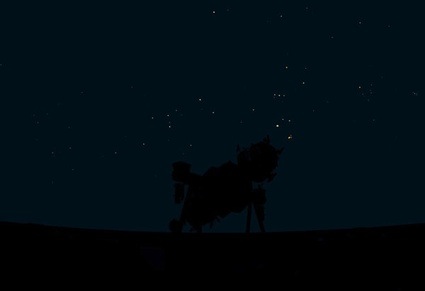
Minolta Planetarium MS-15, a large-format photograph taken inside the planetarium in Memphis, in the United States. All one can see at first is a starry sky. After a while, the eye wanders and realizes that, in the foreground, there is the dark silhouette of the machine that projects the images of the stars inside the Planetarium.
Laurent Montaron artistic practice is interdisciplinary (films, installations, photography, acoustic equipment) and is concerned with the relationship between reality and the perception of time and space the public has through recording and reproduction devices. He also subverts cinema’s narrative conventions, thereby disrupting the reading of the work and underlining the interpretation process the spectator has to go through.
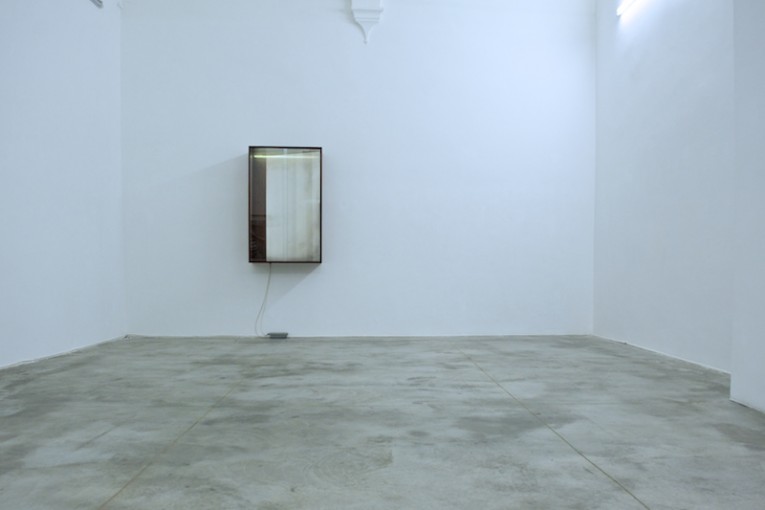
Suggested
http://www.schleicherlange.com/montaronnews.aspx
http://www.annualartmagazine.com/conversation/laurent-montaron/
http://www.re-title.com/artists/Laurent-Montaron2.asp
LARS ENGLUND
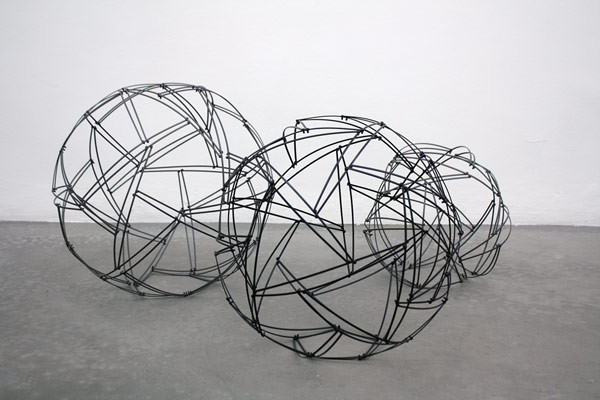
Born 1933 in Stockholm, Sweden , Lives and works in Stockholm and Jonstorp, Sweden.
Lars Englund is like a true avant-gardist hard to categorize. It’s in between fixed categories such as minimalism, constructivism and abstraction that he finds the space to create his unique artistic language. Englund’s art revolves around some of art’s eternal questions like surface and volume, stillness and movement.
Lars Englund creates intricate meetings between the actual work and the surrounding space in which the relation between work and the space is as important as the work itself. A subtle interplay between the inner and outer spatiality arises. The sculptures have such an inherent power that, despite their delicate appearance they fill every void. With no clear beginning or definite end Englund’s sculptures defines and shapes the surrounding room.
Lars Englund like the American 1960s minimalists was inspired by the new industrial materials. When his organic forms met rubber, plastics, carbon fiber and concrete he created works that still seem hyper-modern. The materials have always been allowed a life of their own in Englund’s art, from the early swelling rubber volumes to the sensual experiments in plastic and spring steel.
The apparently strict symmetry is broken constantly by inconsistencies that skews the proportions and allows the dynamics to flow. The repetition of the form is subject to countless variations. When Lars Englund leaves his spatial exploration to investigate the most abstract another phase of his art arises. Through wind-driven, wing-like sculptures Englund explores the most intangible- air and sound.
The constant connection between the work and natures own architecture assures that the work never loses the human touch and that you always feel welcome when facing a work by Lars Englund.
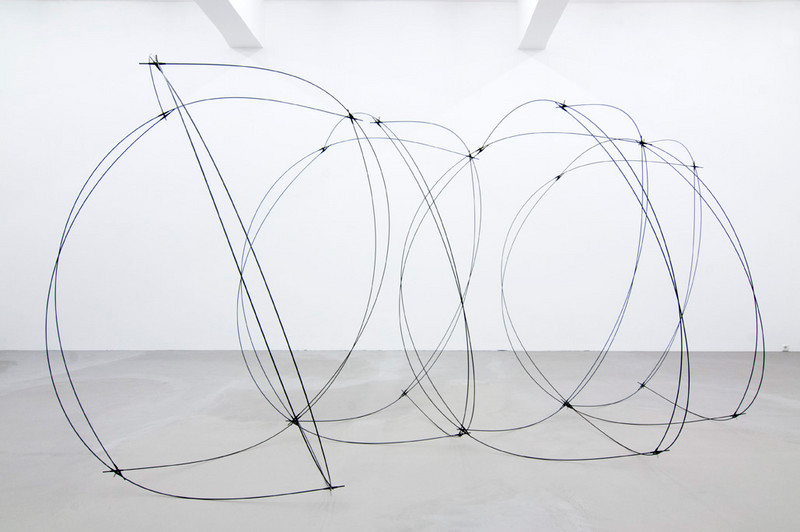
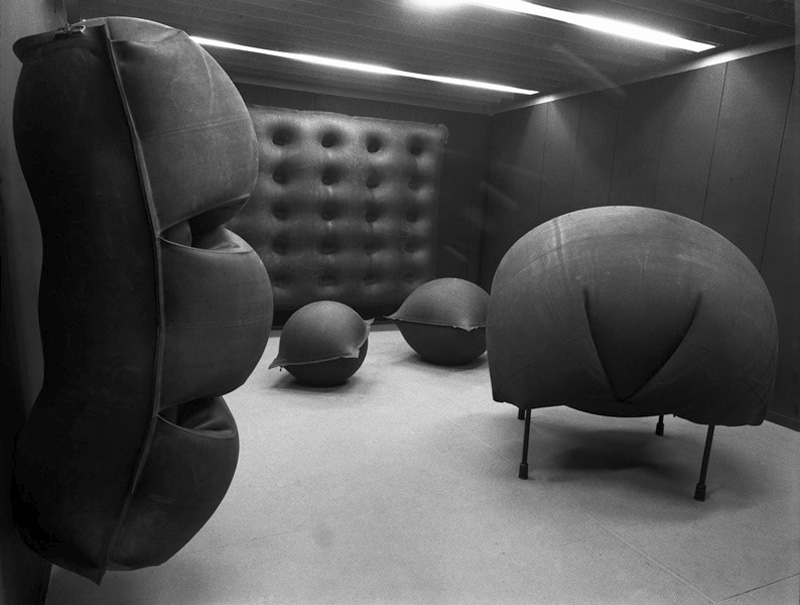
Suggested
http://www.larsbohmangallery.com/artists/lars-englund/bibliography
https://artsy.net/artist/lars-englund-1
CLAUDIA COMTE
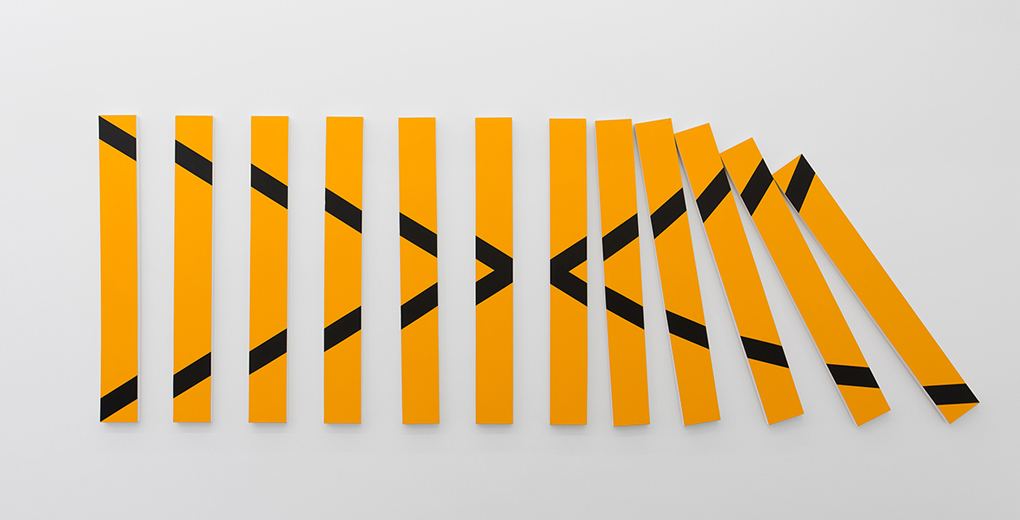
Comte was born in Grancy, Switzerland, and now lives and works in Berlin. She has been the subject of solo exhibitions at Centre d'art de Fribourg, Fribourg, Switzerland; Centre Culturel Suisse, Paris, France; and the Swiss Institute of Rome, Italy. She has also been included in notable group exhibitions at: Kunsthaus Glarus, Glarus, Switzerlandl Aargauer Kunsthaus, Aarau, Switzerland; La Salle de Bains, Lyon, France; and the Musée Cantonal des Beaux-Arts, Lausanne, Switzerland.
The work of artist Claudia Comte is characterized by her use of a simple language of forms and her engagement with different media, such as sculpture, printmaking, installation and painting, which she presents in a spatial manner. In so doing, this artist from Western Switzerland revives traditional artisanal methods and explores the relationships between the visual languages of art history and popular culture.
Comte finds the inspiration for her site-specific works in her environment: in nature, architecture and culture. Her latest series of paintings shows elliptical canvases, on which black and white circles can be seen, which are reminiscent of comic charac-ters' eyes. The convergent eyes, inspired by Warner Bros. "Road Runner", satirize the visual language of the Swiss Concretists. The three stylized pairs of eyes impudently stare into the space of the museum café. With a mixture of humor and homage, the artist subjects the modernist heritage to a jovial rejuvenation. In so doing, she combines concrete visual elements from art with the comic.
Claudia Comte graduated from École Cantonale d'Art de Lausanne (ECAL), where she was influenced by the works of John M. Armleder and Philippe Decrauzat, as well as by these two artists' interest in neo-geo and the abstraction of hardline painting. In 2012, Claudia Comte received the Kiefer Hablitzel Prize, Bern; the Prix Mo-bilière, Basel; and the UBS Culture Foundation Prize for Visual Arts, Zurich. She has taken part in various group exhibitions, including Harum Scarum at Galerie Blancpain Art Contemporain in Geneva (2013); Under 30 VII – Young Swiss Art at Kunsthaus Glarus (2012); Rock the Casbah at Istituto Svizzero di Roma in Rome (2011); and Minipic at Pauline's in New York (2010). She has presented solo exhibitions at Centre Pasquart in Biel (2013); at BolteLang in Zurich (Trouble Rainbow II, 2012) and at Galerie Lucy Mackintosh in Lausanne (Welcome to Colorful, 2010).
Drawing on myriad sources, from architecture and design to nature and popular culture, Comte creates paintings and sculptural works that playfully explore the relationship between material, space, and form. Comte began painting at an early age, producing her first formal series in 2001. Titled, “Our Most Wonderful Years,” the paintings are photorealistic portraits of her childhood, depicting family vacations, birthday parties, and other memorable moments from her youth. Comte has since developed a formal style that tends towards abstraction, bringing together geometric forms, amorphous shapes, and figurative elements, to create a diverse body of work that incorporates multiple media. Often creating site-specific works, Comte investigates the way artwork can transform a space, combining surprising materials, textures, and colors to turn a static room into a dynamic environment.
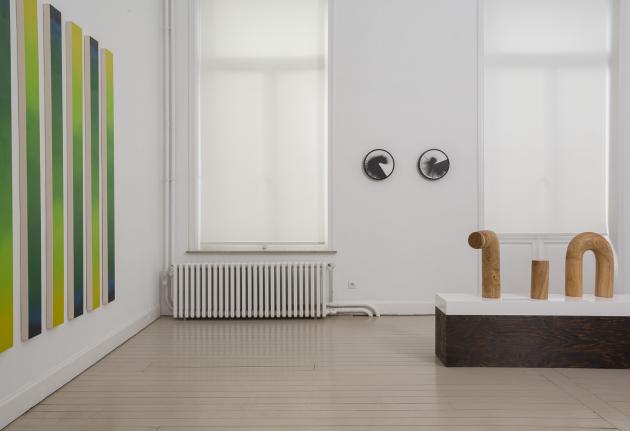
An exhibition at Barbra Gladstone Gallery comprises three series of works, which are installed in a collage-like manner, nearly covering the walls and filling the floor space to create an immersive environment for visitors. The first series, a collection of ten wooden sculptures carved from the trunk of an eighty year-old cherry tree, represents a continuation of Comte’s ongoing work with wood. Comte manipulates the wood with a chainsaw, typically in the place in the woods in which it was found, creating a sculpture that develops a type of personage or character as she works on it. For this most recent series, which is mounted on pedestals that are half glossy and half burned, the tubular sculptures have a letter-like quality, and, taken together read as an abstracted alphabet.
The second series, a collection of “Cocktail Paintings," are inspired by Comte’s favorite bar in Berlin, a place known for its extremely precise drink recipes. Composed of eight brightly painted canvases, the “Cocktail Paintings” represent a melding of painting and sculpture. Comte paints the eight individual canvases as though they were one work, then separates and reassembles them, creating a modular work that can take on a new form each time it is installed. Finally, the exhibition includes a collection of “Circle” paintings, composed on a white circular canvas and painted with black acrylic. Each work consists of one gesture, which appears simple, yet hints at a larger meaning. Inspired by the cartoons of her childhood, in which a single black line could convey numerous movements, the works explore the way in which a simple brush stroke can express complexity.
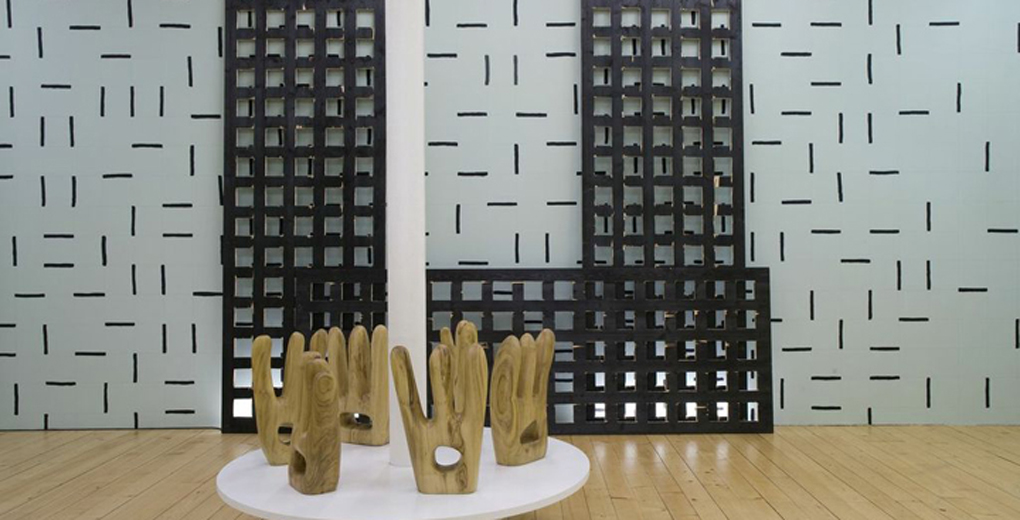
With her fresh attitude towards well-known abstract forms, genuine explosive energy and humorous research, Comte has recently occupied a central place in the Swiss art scene and seems to be everywhere at the moment. Her advantage: she can produce fast and has a lot of ideas ready, simply waiting to find the perfect matching place in which to be realised. From shaped canvases, to zigzag wall paintings, optical patterns or monochrome surfaces, monolithic blocks or organic shapes, her vocabulary doesn’t leave any field of abstraction unexplored. And the combination of all these is there to see in her exhibitions, which can be perceived as very well calibrated installations. But more importantly she’s breaking with a tradition and succeeding in breaking a formal taboo: as a female artist she’s successfully intruding into the traditionally masculine domain of abstract art. No wonder that her favourite tool with which to shape sculptures is the chainsaw.
Suggested
http://www.gladstonegallery.com/exhibition/7192/presshttp://www.boltelang.com/artists/claudia-comte/claudia-comte-biography/
http://artreview.com/features/2014_futuregreats_claudia_comte/
http://thisistomorrow.info/articles/claudia-comte-sharp-sharp
ALEX FROST
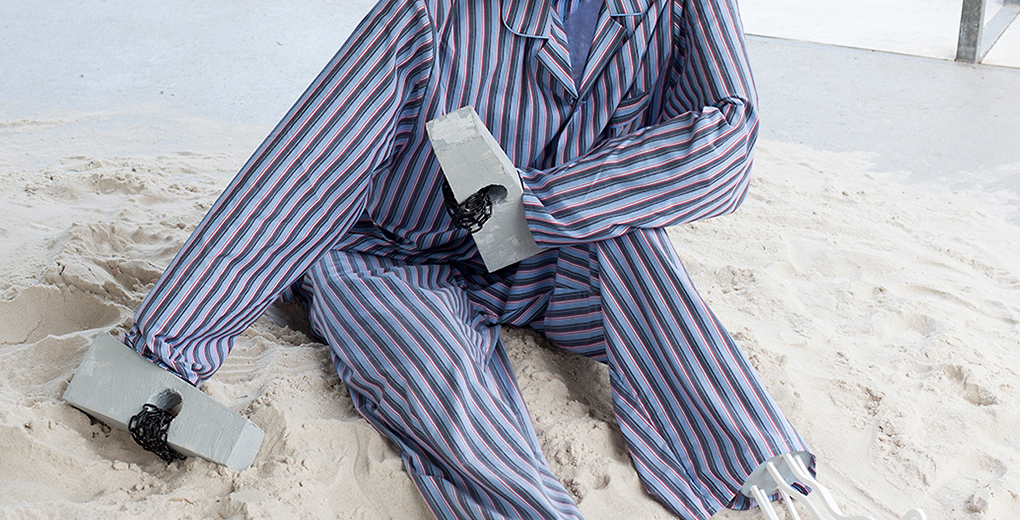
Frost grew up in North London and studied Fine Art at Staffordshire University before coming to Glasgow. He wasn't particularly interested in art at school, though he did take part in community art projects, some involving mosaic murals. "That might have been the start of it all," he says, unconvincingly. "My mum was quite a craft-y person, she would always join local community centres and make things, a lot came from her."
Frost (b. London 1973) lives and works in Glasgow. He graduated from the MFA at Glasgow School of Art in 1998 and has completed residencies at Spike Island, Bristol (2002), Royston Road, Glasgow (2001) and Grizedale, Cumbria (2000). Recent exhibitions include a solo shows at The Changing Room, Stirling - Alex Frost 1973, Alex Frost at Sorcha Dallas, Glasgow, both in 2004, and 'The Connoisseurs', at Dundee Contemporary Arts in 2010
Alex Frost's recent practice has investigated the tension between the Minimalist tradition of modular repetition and the gestural quality of the hand-made, in a continuation of his interest in an 'impure or inbred' Minimalism. Earlier series of works include prototype Buckminster Fuller domes (1998), Gaudi-esque tiled sculptures (2000) and a series of works from 2002 made after the Minimalist sculptor Robert Morris' 'Untitled (L-Beams)', 1965-7. The works and writings of Morris in the 1970s provide Frost with a 'metaphorical plinth' to explore the sculptural tradition - from the miniature to the monumental, the decorative to the architectural , developing a practice described as 'a kind of monument to rationalism usurped by the very blobbiness of its construction'
Alex Frost’s work is concerned with the tension that exists between illusionism and literalism, and exposes how close together the two can sometimes be. His work has encompassed many styles, linked by his intensive, systematic working method and by his interest in a kind of compromised Minimalism. Frost’s cycles of work include prototype Buckminster Fuller domes (1998), Gaudí-esque tiled sculptures (2000) and a series of works from 2002 made after Robert Morris’ Untitled (L-Beams) (1965-7). His work, in Claes Oldenburg’s phrase from ‘I Am for an Art ... ’ (1961), is something square which becomes blobby.
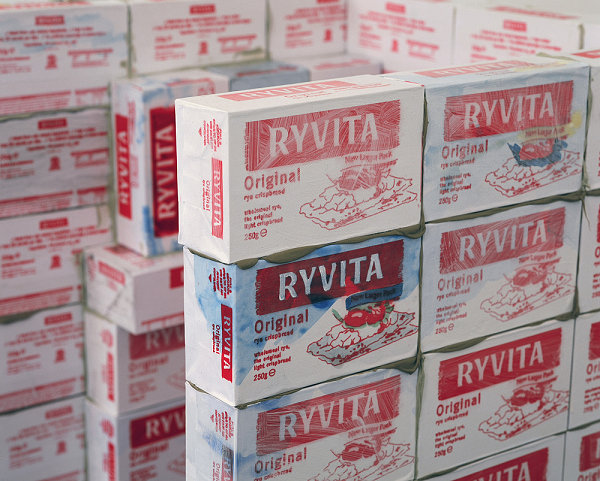
For as solo exhibition at his new gallery Frost exhibited two works that draw on these characteristic interests. Untitled (Ear and Coat) (2004) is one of a series of pencil drawings of himself and friends completed over the last year. These graph paper portraits emerge out of a complex system of pixelated squares, circles and dashes. Frost’s system is derived from two sources: a computer programme that pixelates photographic images and the method of denotation commonly found in knitting patterns. The pixel is a rational form - but not always. In Michael Crichton’s Westworld (1973) the point of view of the murdering android played by Yul Brynner is shown in Pixelvision. Frost’s other source, knitting patterns, would also usually be viewed as rational, or conventionally ‘safe’. Yet Sigmund Freud wrote in his Studies on Hysteria (1893-5) that needlework and similar occupations render women especially prone to dispositional hypnoid states. The hours of meditative drawing, folding and fixing that characterize Frost’s practice have given him an understanding of how systems affect the body, and of how bodies affect systems.
Frost uses the pixel as a way of humanizing the Modernist trope of the grid. There is a link between these works and the work of the German artist Reinhard Voigt, who has been making pixelated representational paintings and drawings since the late 1960s. Voigt has said that his motifs influence the grid, thereby disproving Rosalind Krauss’ theory of the grid as mediating against development, leading the artist into an exploration of repetition. However, what Voigt and other ‘impure’ Minimalists such as Eva Hesse did with the grid is something else - they deliberately imbued the form with traces of the body. An obvious example of this would be Hesse’s Accession II (1965), the cube with an interior bristling with fibreglass fronds. The erotic expressionism and sense of interiority found in that work can also be traced in this exhibition.
Ideas relating to rationalization and the body also inform the second work in the show, a sculptural piece entitled Everyday (2004). The work comprises numerous sloppy copies of Ryvita boxes, rendered in offset lithograph, ink, paint and varnish on paper and red pine, which have been messily soldered into a formation somewhat like a barbecue using grab-and-fill adhesive. There is a crucial distinction to be made between this work and Warhol’s Brillo boxes of 1964. Frost has printed the basic pattern of the Ryvita packet but then painted and drawn each in a different and self-consciously expressionistic style. As with his pixelated portraits, the slight smudging on the surface of the paper announces his hand again and again, the imperfection of ‘free’ expression.
Frost’s choice of Ryvita, the cardboard-tasting snack beloved of dieters, gestures again to the tension in his work between a masculine Minimalist tradition of modular repetition and a more ‘impure’ corporeality. Feminist theorist Susan Bordo has suggested that disidentification from the maternal body (wide hips, rounded stomach, large breasts) may symbolize, as it did in the 1890s and 1920s, freedom from reproductive destiny and a constricted ‘feminine’ social role. In this sense, calorie counting could be seen as a rather twisted route to autonomy. And like the act of following a knitting pattern, adhering to a systematized diet plan brings a weird contained freedom. In working on these ideas Frost deliberately destabilizes our sense of what is contingent and what is given. His work can be seen as a kind of monument to rationalism usurped by the very blobbiness of its construction.
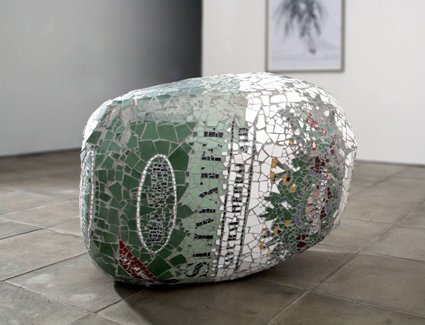
In Frost's work, for every action, there is a subversion: for every laborious act of making, a reference to the digital age; for every piece of realism, a twist which takes it away from that; for every traditional-looking sculpture, the sense that the core is polystyrene.
Suggested
http://www.frieze.com/issue/review/alex_frost/
http://www.scotsman.com/news/interview-alex-frost-artist-1-794245
http://glasgowinternational.org/artists/alex-frost/
MEIRO KOIZUMI
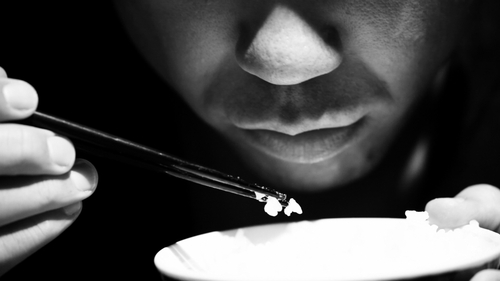
Meiro Koizumi. Defect in Vision. 2011. Two-channel HD video installation, 12 min. © 2012 Meiro Koizumi. Courtesy Annet Gelink Gallery, Amsterdam
Meiro Koizumi investigates the boundaries between the private and the public, a domain of specific importance to his native Japanese culture. His videos are often based on performances and constructed scenarios where he places characters in awkward situations to focus and enlarge the moment when a situation gets out of control, becomes embarrassing or breaks social rule.
Meiro Koizumi (b. 1976, Gunma, Japan) investigates the boundaries between the private and the public, a domain of specific importance to his native Japanese culture. His videos are often based on performances and constructed scenarios. He places characters, played by himself or others, in awkward situations. Often starting harmoniously he gradually heightens the tension manipulating the situation from humorous to painful. His performances focus and enlarge the moment when a situation gets out of control, becomes embarrassing or breaks social rules. His works also include drawings and collages.
Koizumi is an artist based in Yokohama working in video and performance. He studied at Chelsea College of Art and Design, London (1999–2002) and was awarded the Beck’s Futures 2, Student Film and Video Award (2001). Recent and other solo exhibitions include the Museum of Modern Art, New York (2013), Art Space, Sydney (2011) and the Mori Museum, Tokyo (2009). He has participated in numerous group shows such as Future Generation Art Prize, Pinchuk Art Center, Kiev (2012), Hara Museum, Tokyo (2011), Liverpool Biennial (2010), Media City Seoul (2010), and Aichi Triennale, Japan (2010).
Koizumi won the Grand Prize at the 15th Asian Art Biennale in 2012 for his two screen video installation, Theatre Dreams of a Beautiful Afternoon. The video installation begins with passengers in a relaxed mood on a train in Tokyo, someone starts crying, and their sobs get louder and louder until the fellow passengers finally react.
Working in video and performance, Meiro Koizumi has built a compelling body of work that deals with power dynamics on scales from the familial to the national, and examines questions of political and psychological control. Implicating himself, his performers, and the viewer through choreographed emotional manipulations, Koizumi creates works that straddle the uncomfortable and indefinable line between cruelty and comedy. His first solo museum presentation in the United States, Projects 99 includes a selection of earlier projects, as well as Defect in Vision (2011), Meiro’s most ambitious and accomplished project to date. Probing the idea of blindness—both philosophical and physical—the piece is projected on two sides of a single screen, preventing the viewer from taking in both views at once. The action follows two performers who repeatedly enact a domestic scene set during World War II. While staged in the historical past, the scene’s portent of impending catastrophe has taken on a new relevance following the Fukushima nuclear disaster, in a work that is incisive, thought-provoking, and visually lush.
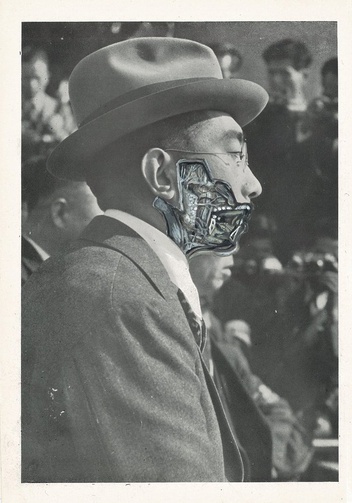
Sunday at Hirohito's, 2012
The name "Sunday at Hirohito's" is taken from the series of photos taken in December 1945 and published by the American Life Magazine in February 1946 called, "Sunday at Hirohito's- Emperor poses for first informal pictures". It was the first time the Japanese public saw him in daily settings. American's purpose was to provide an image of the emperor as an ordinary person instead of a divine figure. In 1946, on January 1st, as part of a New year's statement, he made the Humanity Declaration (Renounciation of Divinity) under American's request. Meiro Koizumi painted anatomical images over his figure to push the concept further.
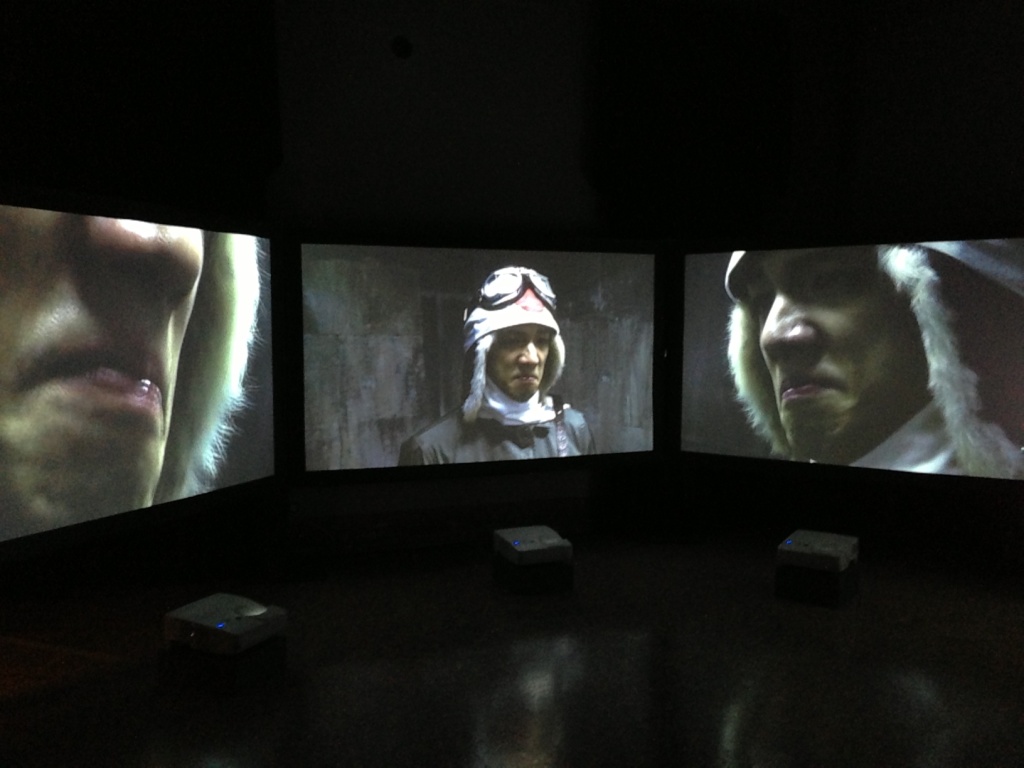
For BMW Tate Live, Meiro Koizumi adapted his video It’s a Comedy 2012, which straddles a line between comedy and cruelty, for a live online audience. In this work a performer read from the trial judgement of Justice Radhabinod Pal, the only member of the international military tribunal for Japanese war crimes to find all defendants not guilty. During the reading of this chilling text, other performers attempted to distract the reader’s delivery using hand gestures, flowers, food and paper.
Suggested
http://www.moma.org/visit/calendar/exhibitions/1341
http://www.annetgelink.com/artists/22-Meiro-Koizumi/works/
http://www.opensatellite.org/exhibition-2009-11-MeiroKoizumi
ZINA SARO-WIWA
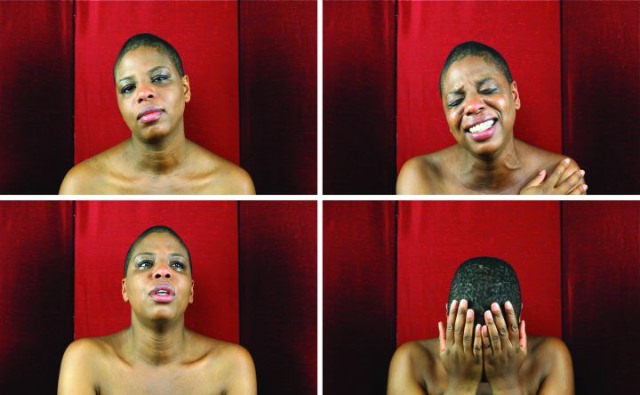
Zina Saro-Wiwa Stills from Sarogua Mourning, 2011 Courtesy of the artist Image: © Zina Saro-Wiwa . 1976, Port Harcourt, Nigeria
Zina Saro-Wiwa was born in Nigeria and grew up in the United Kingdom, graduating from the University of Bristol.Z. She was raised in Surrey and Sussex spending summers in Nigeria. Zina began her career in the media at the age of 16 when she wrote her first article for The Sunday Times newspaper. She has since spent the majority of her career working as a freelance researcher, producer and presenter on BBC TV and radio. She has been involved in journalism and media since her teen years, working for BBC television and radio and writing for the Sunday Times and other publications. Saro-Wiwa now works primarily as a filmmaker and video artist, directing experimental video pieces, shorts, and documentaries, including a short documentary commissioned by the New York Times and the award-winning 2008 documentary This Is My Africa, which premiered on HBO in 2010.
Between 2004 and 2008 Zina was a TV presenter for the BBC's arts programme The Culture Show. On the show she reported on a wide variety of topics and interviewed, amongst others: the late Robert Altman, Jude Law, John Grisham, Kate Winslet, Rowan Atkinson, Cameron Mackintosh, Banksy, Dawn French, Russell Brand, The Pet Shop Boys, Gwen Stefani, John Barry, celebrated tenor Juan Diego Florez, concert pianist Lang Lang, as well as all the editors of the UK's broadsheet newspapers.
Beyond the BBC, Zina has always been involved in the arts. She has had two short stories published, has written a major essay about Nollywood for artist and photographer Pieter Hugo's monograph on Nollywood, has acted as an advisor for the British Council and a judge for the Africa In Motion Film Festival short film competition. Zina is a music-lover and a singer songwriter (in her own right and in her spare time).
As a video artist, Saro-Wiwa’s interest lies in investigating the idea of emotional landscapes. She often explores highly personal experiences, mapping their emotional facets and exploring the connection between documentary film and performance-based video. Her work seeks to make tangible the space between internal experience and outward performance and brings cross-cultural considerations to bear on these articulations. More recently, Saro-Wiwa has begun to work with food as a medium, engaging the cultural and ritualistic aspects of feasting.
Saro-Wiwa co-curated the multi-artist exhibition Sharon Stone of Abuja, Location One Gallery, New York (2010), which explored the visual and narrative conventions of the Nollywood film industry. She was the founder of the multimedia company AfricaLab, an organization dedicated to re-imagining African identity through film and art projects. Her AfricaLab documentary This Is My Africa launched the Forex series at Stevenson, Cape Town (2009); and has been screened at the Newark Museum, NJ (2010); Brooklyn Museum, NY (2009); and October Gallery, London (2008). Other video works have been exhibited at the New Museum of Contemporary Art, New York (2011); and Stevenson (2011); and she has been a guest artist at Third Streaming, New York (2012). Her films have been shown at film festivals worldwide, including the Toronto International Film Festival (2012); Film Africa, London (2011); and the Africa in Motion Festival, Edinburgh (2010).
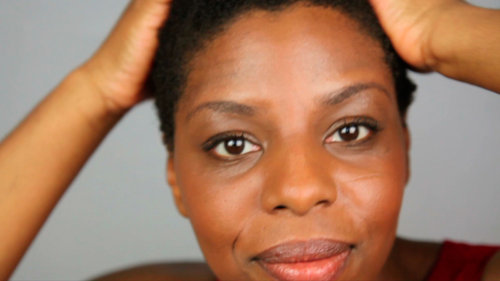
http://www.nytimes.com/video/opinion/100000001579773/transition.html
In April of 2012, The New York Times commissioned Zina Saro-Wiwa to make a short film for their Op-Docs series. The subject in question was the most recent popularity surge and articulation of the Natural Hair Movement among black women. The resulting film, Transition, published on 31st May 2012, quickly went viral and was one of the most viewed online films published that week by The New York Times to-date. Transition has been acquired by the Houston Museum of African American Culture.
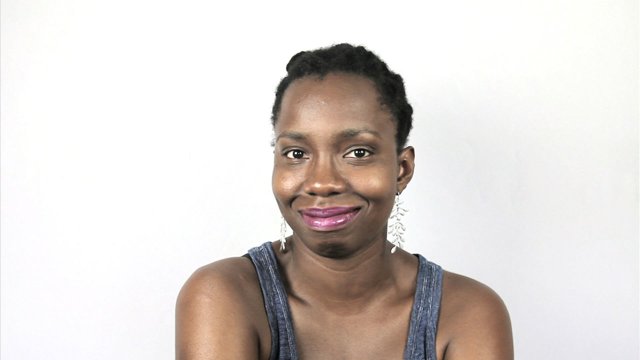
Eaten By the Heart is a compelling video installation and documentary project which explores the cultural specificity of the performance of love. The first sequence, “Eaten By the Heart I” is perhaps the most popular and poses the question “How do Africans kiss?” While the first sequence follows standard documentary format, the second and third installments favour a more evocative tone through experimental integration of these personal expressions of intimacy and heartbreak. As Saro-Wiwa states,
“So many of us cite with confidence that Love Is Universal. But the performance of love is, it seems, cultural. I wonder how the impact of how we choreograph and culturally organize the performance of love impacts what we feel inside and who we become.”
In Part III of the work, , through a “breathing orchestra” Saro-Wiwa collates the voices and faces of different bodies throughout the African diaspora while they share their personal experiences of love, intimacy, and family. Phrases such as “I am not alone, but I am lonely” and “When I think of black love, I don’t think of butterflies in an open field” blend with the sounds of breathing bodies and individual histories of how love has come to mean through culturally-specific ways of knowing and feeling. It does no justice to the installation to explain or catalog the different components with words, so take a look at the visually astounding
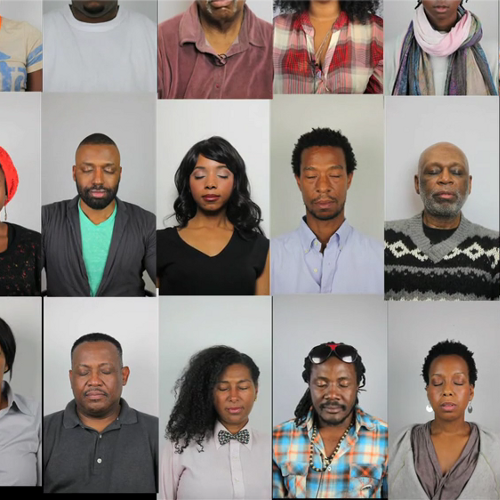
Suggested
http://www.delux-mag.com/the-progress-of-love/
http://www.stevenson.info/exhibitions/love/zina-mourning.html
CAKES DA KILLA
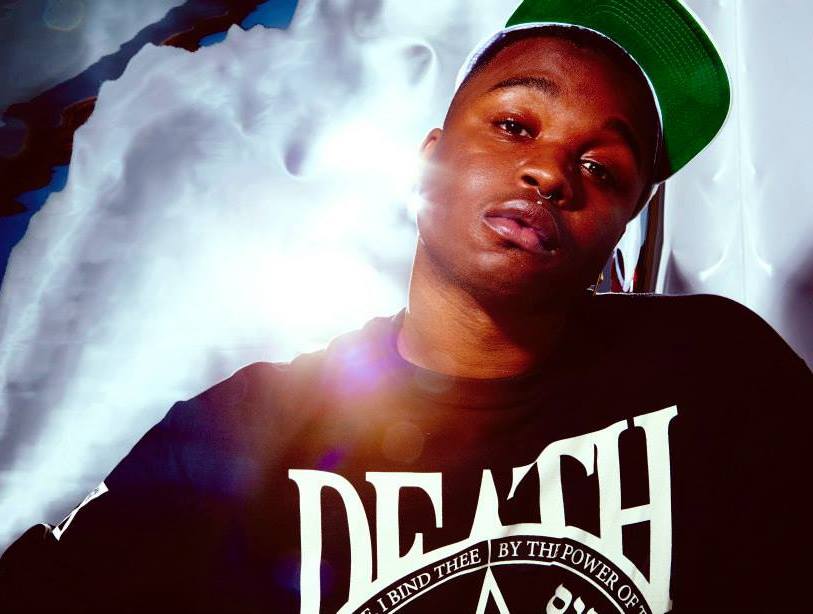
Mishka Records recording artist Cakes Da Killa, also known as Rashard Bradshaw, is a 22-year-old rapper and performer from Englewood, New Jersey with two EPs under his belt. Bradshaw's latest mixtape, Hunger Pangs, was released on June 18, 2014
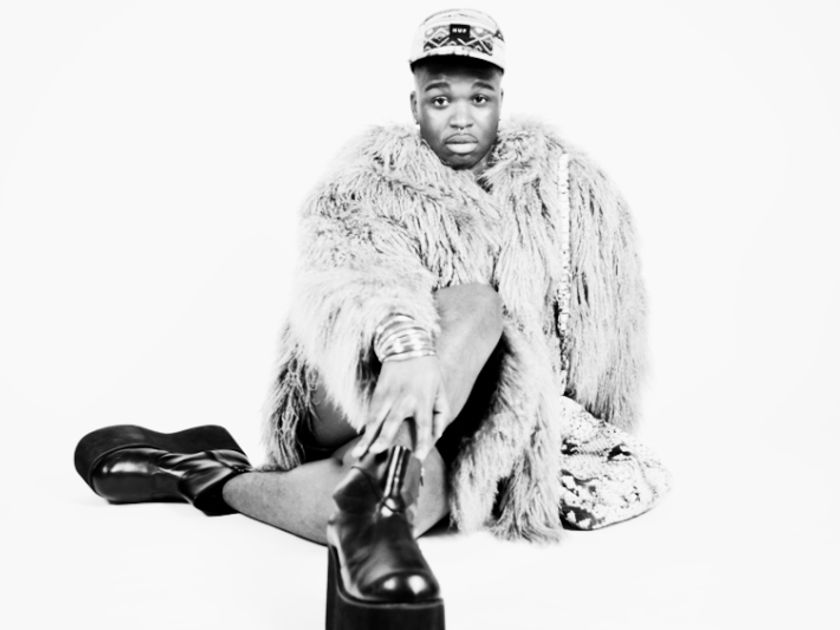
Bradshaw started rapping in high school for fun before considering it as a career. He first began writing tracks to instrumentals he found on the internet and posting them to Facebook. In 2011, his homemade demos came to the attention of a producer named Stixx, who invited Cakes to appear on the mixtape Downtown Mayhem Vol. 1 alongside Rip The Ruler. Bradshaw then went on to release his debut mixtape Easy Bake Oven, Vol. 1 through Stixx' Downtown Mayhem label.
As an emerging artist in the LGBT hip hop genre -- along with fellow artists such as Le1f, Mykki Blanco and House of Ladosha-- Bradshaw gained popularity through media interest in LGBT figures and themes in hip hop. Bradshaw cites Remy Ma, Lil' Kim, Foxy Brown, and Cam'ron as influence.
Released for free on Mishka NYC's website, Bradshaw's second mixtape The Eulogy was released to overwhelming popularity when it was reviewed positively by Pitchfork and The Needle Drop Anthony Fantano of The Needle Drop praised Bradshaw on both his lyrical content and flow, while Miles Raymer of Pitchfork compared his raunchy style to Lil Kim and praised the production of the mixtape. According to an interview in Paper Magazine, the mixtape's title originally referred to Bradshaw's plan to end his musical career after its release, but he's since changed his mind.
In May 2013, Bradshaw completed his Bachelor's degree in fashion studies at Montclair State University.
In September 2013, Bradshaw released a remix EP for his hit single "I Run This Club", which samples M.I.A.'s song by the same name from her 2010 mixtape Vicki Leekx.
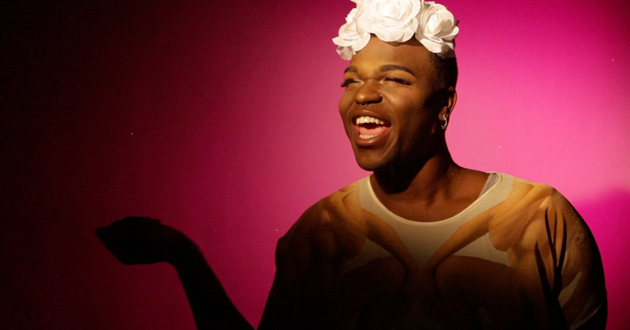
http://noisey.vice.com/blog/premiere-cakes-da-killa-i-run-this-club-official-video
>
Suggested
FRANCES STARK
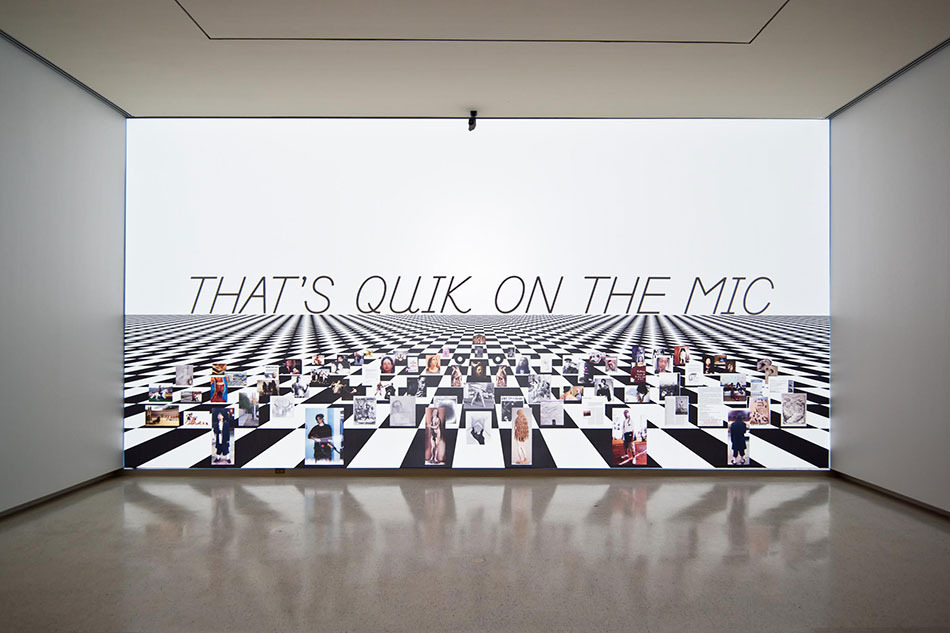
Frances Stark, installation view of Bobby Jesus’s Alma Mater b/w Reading the Book of David and/or Paying Attention Is Free, 2013, inkjet print on paper and multichannel projection with sound; 4:20 min. Courtesy of the artist; Galerie Daniel Buchholz, Cologne and Berlin; Gavin Brown’s enterprise, New York; Marc Foxx, Los Angeles; and Greengrassi, London © Carnegie Museum of Art
The artist’s video installation, Bobby Jesus’s Alma Mater b/w Reading the Book of David and/or Paying Attention Is Free (2013), makes its debut at the 2013 Carnegie International.
Frances Stark creates artwork that is deeply rooted in language, poetry, and the ways we make sense of the experiences of everyday life. Commingling text and image, her practice often blurs the line between her work and personal life and takes inspiration from a range of sources including literature, art history, and pop music. She holds an MFA from the Art Center College of Design in Pasadena, California, and studied at San Francisco State University; she is currently assistant professor of painting and drawing at the University of Southern California. Her videos, drawings, performances, and other works have been the subject of solo exhibitions at MoMA PS1 (New York, 2011), Performa 11 (New York, 2011), Hammer Museum (Los Angeles, 2011), and the Center for Contemporary Art (Glasgow, 2010).
Stark, discovered the Polaroid in the late '80s, just as she was learning about Cindy Sherman's multiplicitous self-portraits and artists like Sherrie Levine, who rephotographed other people's images. What her grandmother did struck her as an authentic, unschooled sort of conceptualism. "It was so beautiful. It was about her looking at herself, thinking about photographs, and thinking about other people looking at her. It was mind-blowing. It made me get into art, actually."
Stark is compact and intense, relentlessly cerebral but quick to laugh. What captivated her encounter with her grandmother's self-labeled photograph remains evident throughout the exhibition, in her fascination with the acts of looking and creating, self-reflexivity and autobiography, in the way she integrates the visual and verbal, and teases out connections between her physical body and body of work.
"Me Edith" became the title of Stark's first exhibition, as an undergraduate at San Francisco State University. (She earned her MFA at Art Center College of Design.) She recounted the origin story in late October, on opening day of her most extensive U.S. show, a 20-year survey of collages, drawings, videos and sculptures at MIT's List Visual Arts Center "Frances Stark: This could become a gimick [sic] or an honest articulation of the workings of the mind,"
Until recently, Stark’s works most often took the form of collages, drawings, magazine spreads, and posters that reflect on the creative process as an act of translation, as well as the gender associations of domestic and professional spaces such as the artist’s studio. More recently, she has started to produce videos, slideshows, and audio pieces that are startling in their bold engagement with the outside world. Her breakout work in this vein, My Best Thing (2011, acquired by Carnegie Museum of Art in 2012), animates a series of Stark’s flirtatious chat-room encounters, which put “dirty” talk on the same level as philosophical discussions and political engagement.
Continuing her “brazen pursuit of unlikely alliances,” the work centers on a text projection based on conversations with Bobby, a self-described resident of “planet ’hood” who has become her studio apprentice and friend.
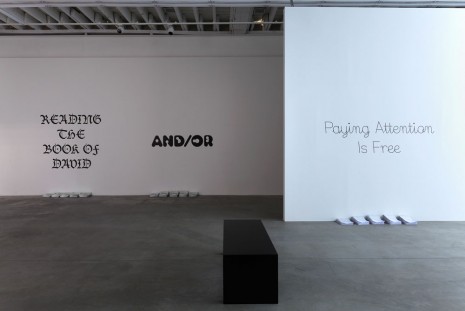
My Best Thing
A conversation between two online avatars on a dating website, which develops into a masturbatory love affair between a woman and a younger man, is the subject of Frances Stark’s My Best Thing, an animated single-channel video.
Through the medium of animation, Stark raises questions about the difference between therapeutic confession and performance. In the midst of a creative crisis, the woman flirts with the idea of an artistic collaboration with Marcello, an Italian filmmaker she has become acquainted in a video chat room. Marcello then drops out of sight. However, the woman then encounters another man whom she mistakes for Marcello and who turns out to be a spiritually bored son of an auteur director.The episodic film, which debuted at the 2011 Venice Biennale is ostensibly based on the artist’s virtual relations with two Italian men she met through anonymous chat rooms. But in her interactions with them, sex is frequently foregone for more cerebral pleasures, as she and her online partners spend their digital trysts discussing literature, philosophy, film, and more.
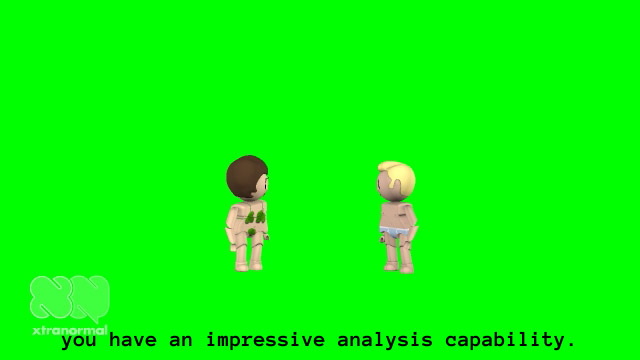
http://vimeo.com/38244867#
Suggested
http://www.francesstark.com/wp/
http://ci13.cmoa.org/artists/frances-stark
http://artforum.com/words/id=21484
http://www.oregonlive.com/art/index.ssf/2013/09/review_frances_starks_my_best.html
http://www.marcfoxx.com/artists/2909
http://www.artinamericamagazine.com/news-features/magazine/frances-stark/
PASCAL MARTHINE TAYOU
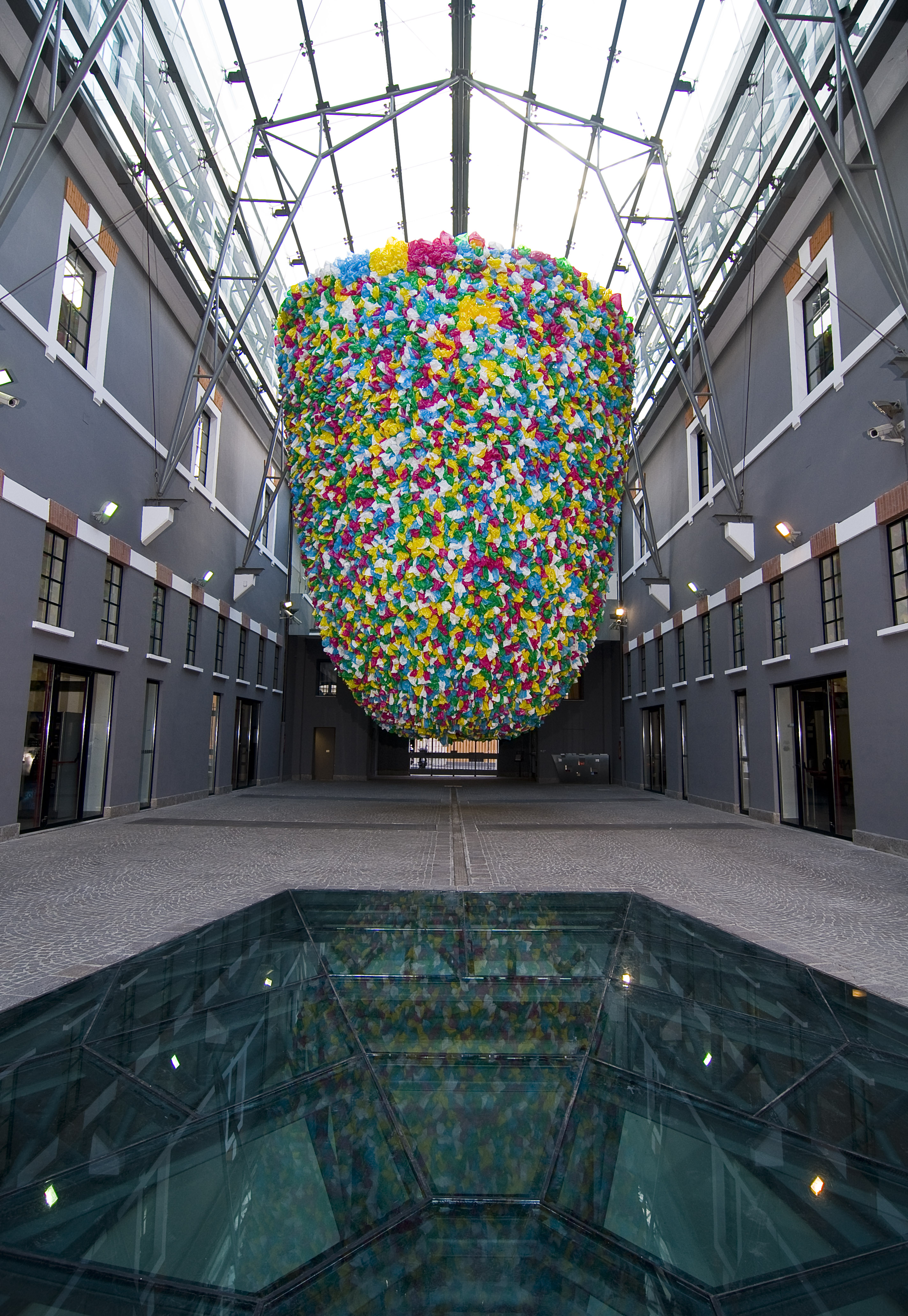
Born in 1967 in Cameroon
,works and lives in Yaoundé, Cameroon and Brussels, Belgium.
Pascale Marthine Tayou is difficult to categorize. He gave himself two first names Pascale and Marthine that he feminized. He studied law, hoping it would lead to a kind of purity, but fled the profession when he realized that the system was corrupt. He then turned to art, despite his suspicision that “it didn’t exist”. Tayou’s work is based on the premise that art cannot be separated from life. His site-specific installations recycle every kind of material, object, and image to testify to the continuous circulation of people throughout the world, their personal history and their culture. He refers to these projects as “collective works,” the result of that which he notices, of what happens to him in everyday life, a sum total of journeys, encounters, energy, chance and spontaneity. Tayou has commented, “I leave to others the possibility of saying it all. For me, art is just a simple vector of communication.” In the mid 1990s, much of Tayou’s work was based on drawing. In 1995 he created an extended series
of sketches, beginning with a sequence based on Das Kapital. Using chalks, coloured felt tip pens, ink and ballpoint pens on the back of recycled posters, Tayou executed these works very rapidly, in freehand, almost mechanically. Without ever stopping, thinking, or looking back, Tayou could only see the whole once he had finished. Even though they seem formless and out of control, viewed together they are like a series of interconnected dynamic networks that have been infiltrated by a form of energy which seeks to dismantle them. As Tayou has stated, “When I was young, I wrote and I drew. It was my way of rebelling.” More recently he has used a similar method to create site-specific works and video installations. The words and the rhythm of his texts, the recycled objects that he literally nails on to frames and strews around exhibition spaces, the incidental and purposeful footage picked up by his video camera, regard with equal intensity both the evil and grace of the world we share.
Pascale Marthine Tayou is widely known and has taken part in the Lyon biennales in 2005 and 2010 and the Venice biennale in 2009. Pascale Marthine Tayou was born in 1967 in Yaoundé (Cameroon). He lives and works in Gand (Belgium).
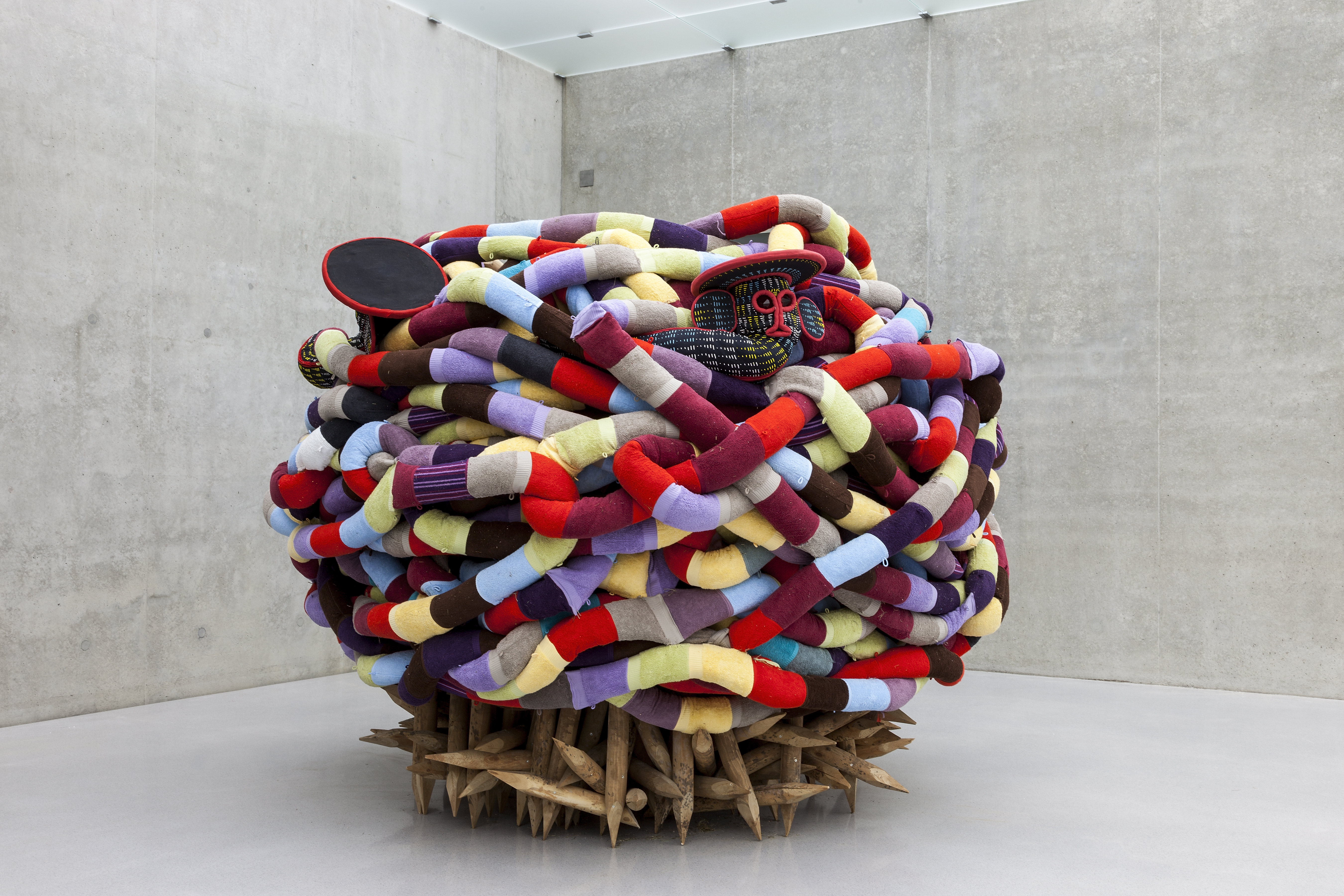
The artist combines African and European symbols with humour and poetry in order to redefine the postcolonial heritage and the issues linked to globalisation. Structures, collages, photos, sculptures, videos, reworked objects… His work knows no boundaries and is often a result of recycling, the daily object becoming the vehicle of a story, of a culture, of an identity. Pascale Marthine Tayou’s installations are places where imagination, history, economics and spirituality co-exist, in his words creating “a bridge between thinking and dreaming.”
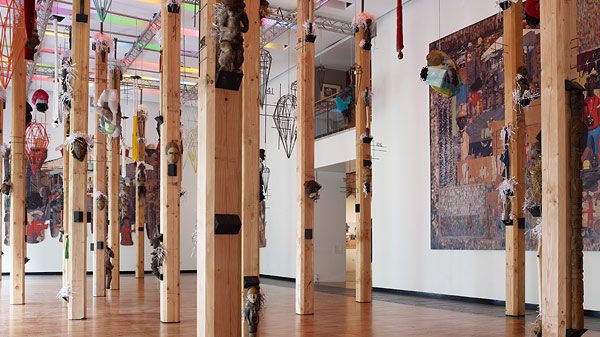
The World Falls Apart,
The World Falls Apart, Tayou’s new work created for this exhibition and shown at the Whitworth, is an interior forest that spills out into the neighbouring park. Taking inspiration from one of the most widely-read novels in African literature, Things Fall Apart by Chinua Achibe, Tayou’s installation is a “cultural traffic jam”2. African sculptures made for the tourist market peer down from wooden poles, steel diamonds hang from chains and translucent forms stuffed with discarded food packaging and crowned with wigs are suspended overhead. The distinction between trade goods and sacred objects is blurred, the diamonds look like objects of veneration as much as symbols of Africa’s plundered material wealth. Cultural definitions are indistinct and impossible, the trees are squared and unnatural, and the forest is haunted by numbers and chains.
Pascale Marthine Tayou’s drawings, sculptures, installations, videos and performances address issues of cultural and national identity and borders in an age of global tourism, drawing on his own experiences of frequent travel. Tayou often works with found materials, objects and images emblematic of people’s itinerancy and circulation around the world, such as train and bus tickets, flags and postcards.
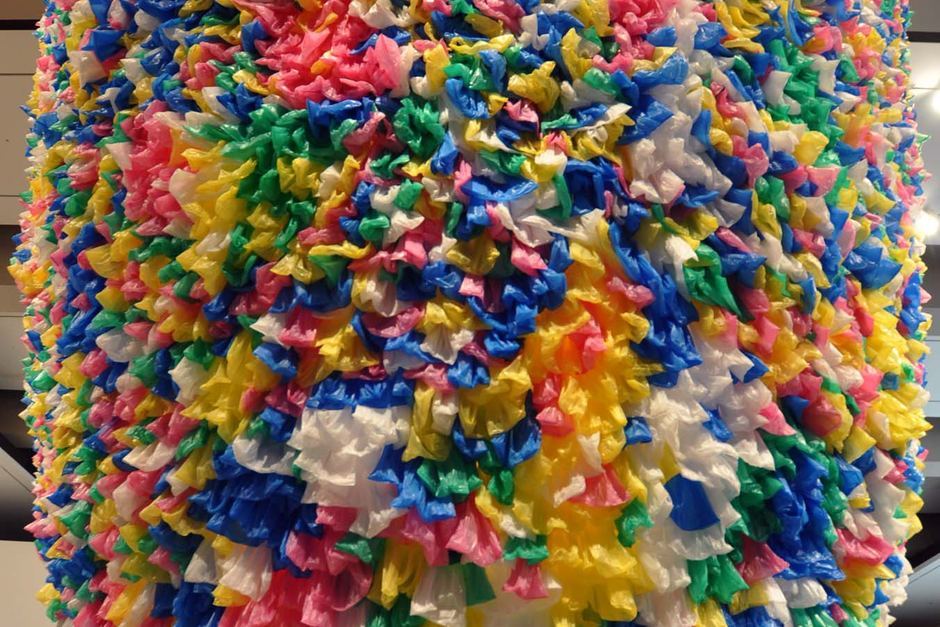
Made from thousands of plastic shopping bags, Tayou’s monolithic assemblage Plastic bags 2001–08 is an ominous spectacle of consumerism that hangs from the ceiling, as if threatening to spill its junk on the gallery floor. Tayou has compared the plastic bags to people, describing them as both ‘useful and dangerous’, emphasising the underlying contradictions of a world saturated with commodities
Suggested
http://www.wefaceforward.org/artists/pascale-marthine-tayou
http://www.lesrivesdesaone-grandlyon.com/designers-and-artists/pascale-marthine-tayou/
http://www.artinamericamagazine.com/news-features/magazine/pascale-marthine-tayou/
WARAIRE BOSWELL

WARAIRE BOSWELL, a Los Angeles based designer, established a loyal following by placing quality and functionality as the number one priority in every piece he produces over the last 12 years. Standing tall at 6’7”, Boswell developed his namesake brand out of necessity.
Waraire “WB” Boswell is a California native who developed his namesake collection out of necessity. Standing at 6'7.5" inspired his interest in providing bespoke fashion for gentlemen of all builds. Although he never went to traditional fashion school, he initially began designing for himself while working at Fox Sports-Football and it was from his own need dress to the professional standards of the industry that he began getting custom clothing made for himself. These garments quickly attracted the attention of professional athletes, TV executives and actors that frequented the Fox Lot in Century City, California and hence his line was born.
Boswell began his career working for United Talent Agency and William Morris Agency, two of the most prestigious talent agencies in the industry. It was here that the agents took notice of Boswell’s unique combinations and attention to detail. Boswell’s work became so prevalent amongst his colleagues and associates he parted ways from the agency and began making custom menswear full-time. As his popularity increased amongst the agents, word spread to their clients, mostly professional athletes that included Chris Bosh, Tyson Chandler, and LeBron James. Perhaps you too often find that mass produced clothing does not fit your unique posture. In 2013, Boswell expanded his brand and began making ready to wear piece.
With quality and functionality as the paradigm of his designs, Boswell has developed a tremendously loyal following. Providing personalized opulence with tailormade attire in unique silhouettes with specialty linings and infinite details, Boswell allows clients access to choice styles and invites the patron to be part of the artistic process. The result: fabulously personalized clothing.
What continually sets Boswell apart from his contemporaries is his uncanny ability to provide a custom look for each client while offering products that are made in the USA by artisan craftsman
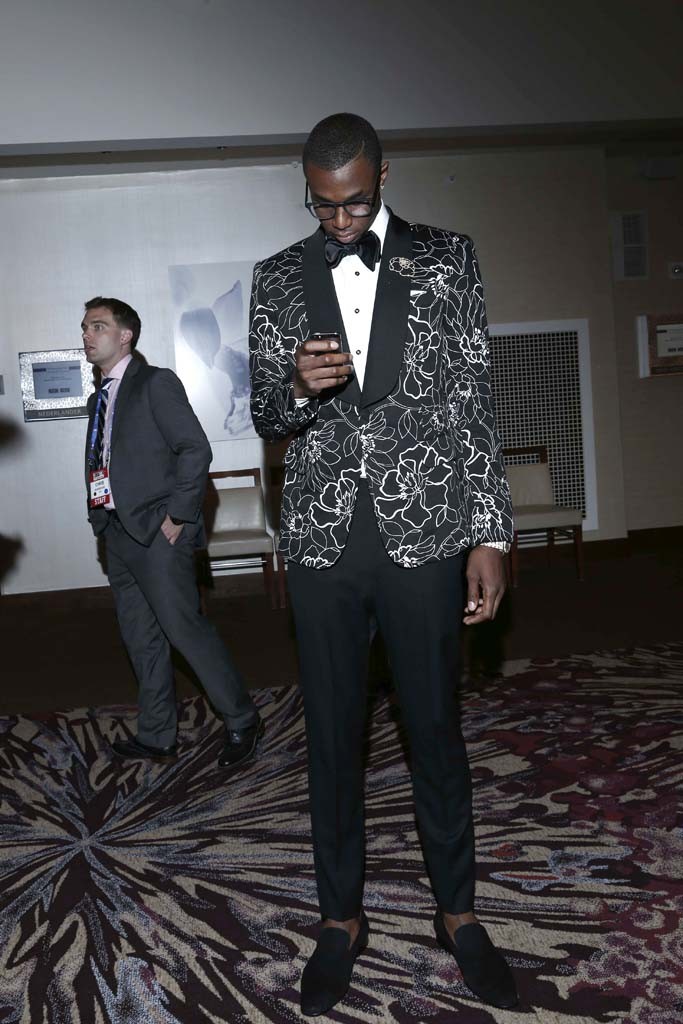
While his roots were established with athletes, Boswell has vast experience dressing A-list celebrities for The Golden Globes, The ESPYs, The Grammys and tailoring for tastemakers and industry insiders on a consistent basis. Boswell served as an independent correspondent for Minolta & BSN Publications for NY Fashion Week.
What continually sets the Waraire Boswell brand apart from its contemporaries is the designer’s uncanny ability to provide a unique look to clients of various heights and shapes. To Boswell, one’s size puts no limitations on construction. The brand has a diverse set of customers with backgrounds and professions from all over the globe. Boswell is able to create designs that can adapt to anyone’s signature style. From flamboyant celebrities to conservative businessmen alike, anyone can tailor their perfect moment in Waraire Boswell.
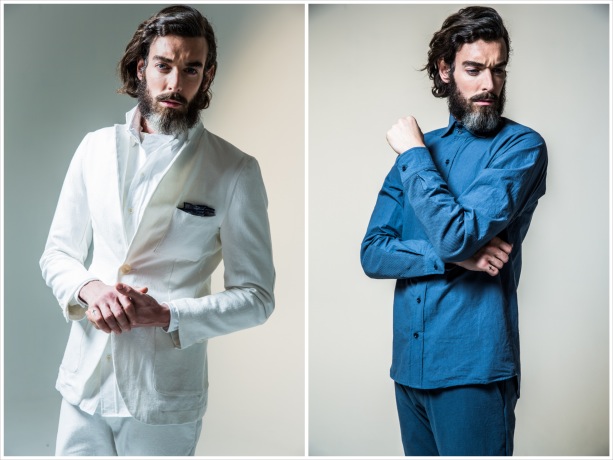
"Get out of your own way. That’s the main thing. Make sure you focus on one task at a time, and don’t take on too much at once. Don’t talk yourself out of things." WB
Suggested
http://bevelcode.com/interviews/waraire-boswell
http://www.youtube.com/watch?v=FTijy2Z4oS8
SARAH VAN SONSBECK
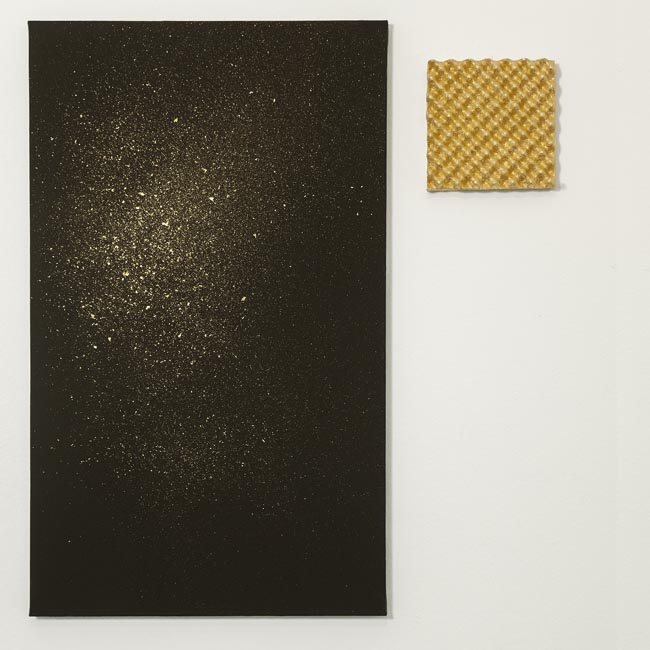
Sarah van Sonsbeeck (1976) studied architecture at TUDelft (MA) and art at the Gerrit Rietveld Academie (BA). In 2008, 2009 she had a residency at the Rijksakademie van Beeldende Kunsten (Amsterdam). Her work was amongst others on show at Museum De Paviljoens (Almere), Annet Gelink Gallery (Amsterdam), the Stedelijk Museum (Amsterdam) and Museum Abteiberg (Mönchengladbach).
SvS: I don’t usually work in a given medium (like paint or film), but each project will find its own best way to be made. Still, I love making objects. Perhaps this is some remnant from my architecture studies?
Her work, ranging across all sorts of media, is always infused with an attention for space, an heritage of her years as an architecture student. It deals with the immaterial, but also with chance. If silence is a place of intimacy, free from the incursions of the outside environment, the accidents that break it are meaningful, enigmatic, chaotic events storming their way into our world. Sound - or lack thereof - is then only one of the dimensions of her installations, consisting primarily in a fragile and intimate experience to cherish and keep to ourselves. In the shape of minimal container cubes, silk-screened vinyl discs, wooden structures or documentary photography, her works almost always imply an interaction with the viewers.
.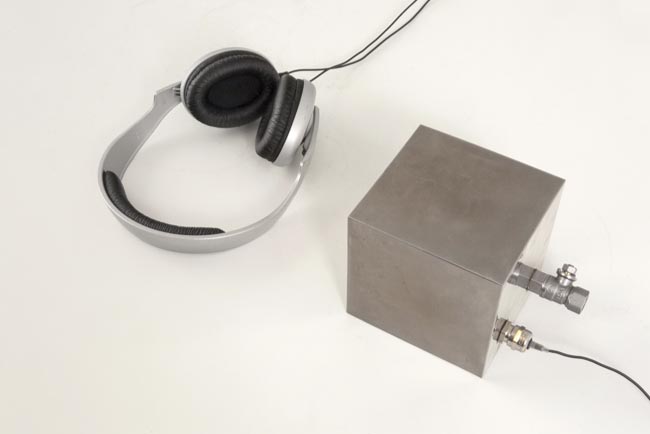
Sarah van Sonsbeeck's work is two-sided: on the one hand, she tries to define, defend and extend private space; on the other, she simultaneously reveals the impossibility and perhaps even undesirability of being completely shut off from the world. A case in point is when she tried to contain one cubic meter of silence on the as yet undeveloped plot of land around Museum De Paviljoens in the rapidly developing new town of Almere. One night the reinforced glass cube was smashed with a stone by local youths. She embraced this vandalising act and renamed the work One Cubic Meter of Broken Silence (2009). Instead of preserving the increasingly rare silence - which, strictly speaking, because of the rustling reeds and chirping insects, was no silence at all - the focus of the work shifted to communication (however violent) and interaction.
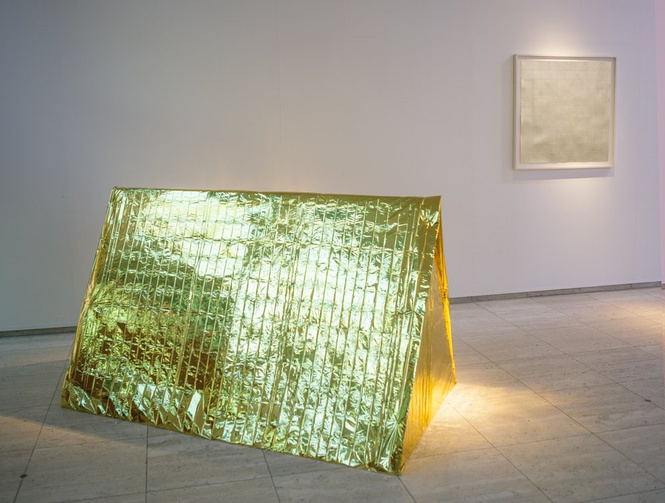
Working on what she calls the 'right to silence', she made a tent out of Faraday Fabric that shields the person inside from all electromagnetic signals, and thus not only from visible, but also from all invisible and inaudible noise. The tent becomes a portable personal space that you can take with you wherever you go, but, since it only consists of a very thin cloth, it definitely does not keep audible noise out. It may be a shelter, but only to a certain extent.
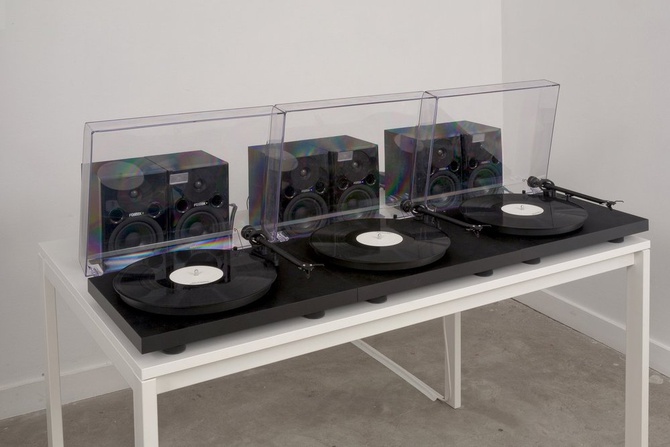
Her work focuses on the thin permeable line between interior and exterior - without concern for the façade. This detour brings her to an investigation of a more immaterial side of architecture, in which she scrutinizes all the small elements that determine how we live in our homes, the things the architects cannot control. She amplifies these elements and devises shields against them, but also welcomes the unpredictable and reveals the minute but intimate relationships between people who don't necessarily know each other. Sarah van Sonsbeeck practises architecture after all, of the immaterial - though no less fundamental - kind.'
What emerges from Sonsbeeck’s work is the duplicitous nature of silence: both threatening and threatened it can stand for sanctuary and preservation on the one hand and stagnancy, censorship or lack on the other. Sonsbeeck’s 2009 work One cubic metre of broken silence illustrates this perfectly. Intended to represent a silence that once existed in a soon to be developed brown field site outside Almere, the cubic metre glass case was placed on site at counter to the environment it was, to some extent, preserving. Vandals soon damaged the work, but this was by no means an end for the piece. Sonsbeeck explains, “when I heard the news of the work being broken I was devastated, but when I saw it I instantly knew it was a better work because of it […] somehow now it truly showed silence as something very fleeting”.

Municipality of Silence
Municipality of Silence by van Sonsbeeck, who turns the Netherlands consulate garden into a stage hosting her monument to silence for the participator to experience.
The artist places a bench, an exact replica of the bench she found at the most silent point of Holland, to one of the quietest corners of the Beyoğlu district: the garden of the Consulate General of the Netherlands. With referral to a Dutch governmental map tracing silence in Holland and by manually measuring silence with a decibel meter, Sarah recreates the atmosphere witnessed at the most silent spot of Holland in the garden of the consulate.
A concept that evolved from her very first project as an artist, Letter To My Neighbors, 2006, van Sonsbeeck wrote a letter as a response to her loud neighbors in Amsterdam, requesting them to pay 80% of her rent, claiming they occupied the equivalent of this sum with their noise. With this incident, the artist, a former architect, realized the shortcomings of architectural practice that neglects the effects of immaterial factors like sound, and decided to commit her artistic career to explore, measure, map and design silence.
In a particularly noisy neighborhood of Istanbul, van Sonsbeeck removes territorial boundaries to enable access to an otherwise exclusive environment devoid of excess sound. Paradoxically, the restricted nature of this specific location is the very reason for it’s calm, which in turn brings forth the inverse relation between silence and men and how silence in dense urban areas is fast becoming a scarce commodity.
Sonsbeeck’s pursuance of silence also has to contend with a modern obstacle: technology. Sonsbeeck, while being an avid user of Twitter, Instagram and other platforms, admits feeling that “something was lost” in their use. She sees the online world as “another type of public space” and so has typically gone about arranging this space, deciding what she does and doesn’t want to hear. This gave birth to The Faraday Bag: a simple shoulder bag made from silver-plated fabric that blocks electro magnetic signals. The concept has even greater implications: Sonsbeeck is now working on the ‘antidrone tent’, a small construction of emergency blankets that blocks thermal infrared sensing, making it invisible to drones (to be shown in her solo exhibition at the Nederlandsche Bank, later this year). It seems her art is in constant dialogue with emerging technologies, trying to retain slivers of silence, as Matta Clark maintained slivers of ‘no mans land’. But while Matta Clark’s strips of tarmac are surveying offcuts and neglected fragments of blueprints, Sonsbeeck’s kernels of silence seem to be produced as preservation. However, this is not the limit of her work. By capturing and exploring sound and silence, Sonsbeeck maps the edges of our interactions and offers a refreshing evaluation of modern space. Her work is about how to position oneself in a world that is home to a variety of sounds and how, when we understand our own definitions of silence, we can hear ourselves all the better.
All Images Courtesy of Annne Gelink Gallery, Amsterdam
Suggested
http://www.annetgelink.com/artists/60-Sarah-van-Sonsbeeck/works/other-works
http://www.artslant.com/ny/artists/rackroom/185151-sarah-van-sonsbeeck
http://www.aestheticamagazine.com/blog/interview-with-artist-sarah-van-sonsbeeck/
STANLEY BROUWN

Stanley brouwn’s works elude a stylistic definition. developed directly from experiences of everyday life, they have the aim of creating a consciousness of mouvement in the world (in a narrower and wider sense). Stanley Brouwn began practicing in the 1960s during a period heavily influenced by the Fluxus movement. The subjective, arbitrary nature of measurements intrigued Brouwn and became the subject of his explorations within a conceptual art framework. Amongst his most famous works are early pieces in which he asked passers-by to draw directions to a particular point. He would then stamp the drawings with 'this way brouwn'. Stanley Brouwn, one of the most important representatives of the Fluxus movement and Conceptual Art, is, in the truest sense of the word, one of the most forceful and inaccessible artist personalities. He does not want his art written about, neither does he want any photographs taken of himself. What is known about him is that he was born in 1935 in Surinam, has lived in Amsterdam since 1957, and for many years taught as a professor at the Kunstakademie Hamburg.
Stanley Brouwn began working with distance and direction in the early 1960s. During this period he made work by asking random pedestrians to describe a route to another point in town. The resulting sketch or unmarked piece of paper if the description were entirely verbal, would then be stamped This way brouwn. In the early 70s, brouwn began to make books. In one of his first publications, 100 this-way-brouwn problems for computer IBM 360 model 95, brouwn lists this way brouwn questions to be posed to a computer beginning with: "show brouwn the way in all cities, villages, etc. on earth from point x to all other points in that cities, villages etc." Too complex for even a computer to solve, this list of questions is designed to reveal the infinitely complex possibilities implicit in the idea of a this way brouwn. In his book Steps, published by the Stedelijk Museum, Amsterdam in 1971, brouwn first makes use of what would become a full-time focus for his work, his own footsteps: "from march 18 until April 19, 1971, I defined my total number of footsteps each day by means of a handcounter. During this period I visited a number of countries where I had never been before. Consequently, my footsteps there were my first in those countries." By 1976, brouwn has created his own unit of measure, the brouwnstep which he makes use of in such publications as his 1976, 1m 1 step which consists of two printed lines, one measuring 1 meter, the other 1 brouwn step. In recent publications brouwn has expanded upon his interest in the use of the body as a means of measurement, often making the basis of the work antiquated or ancient forms of body measurements such as the ell, the foot and the Egyptian royal cubit.
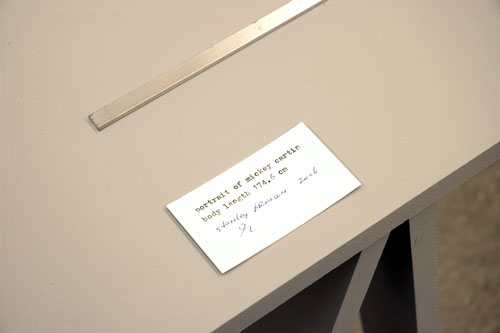
Brouwn’s often overlooked work, with its origins in 1960s Conceptualism, but also to reflect on the legacy of that tradition in an age that seems less concerned with that period’s major preoccupations. Among these could be cited: the dematerialization of the work; the impersonality of creative processes, or the disappearance of the author; and, like the experimental literary group Oulipo, an interest in contingent rules and the permutations of a simple pattern. All of these things also appear in contemporary work, but today the focus seems to be on the personal life and self-exhibition, a desire to be immersed in experience without mediation, and the flaunting of rules, systems and codes.
Brouwn’s habitual obsessions are with geography, distance and direction, scale, measure and dimension. He is a meticulous recorder, giving every indication of keeping his counter and measuring stick close at hand. Between 1960 and 1964 he produced the seminal series ‘This Way Brouwn’, asking passers-by to sketch for him on paper the way from A to B, then appropriating their drawing by adding his stamp ‘This Way Brouwn’. Whether the artist is dealing with his own meanderings, comparing different units of measurement –1 royal cubit: old egyptian measuring unit of length 2500 b.c. (1998) and division of 1m and 1 wari (kenya) according to the golden section (1994) – proposing short walks in the direction of world cities – walk 4m in the direction of havana distance: 7396584.7166m (2005), measured from the very spot where you standing in the museum – or detailing in exact terms what lies behind a square metre section of the museum wall – ‘a 28mm cushion of air separates brick from sand-lime brick’ (1x1m wall exhibition space van abbemuseum eindhoven, 1979-2005) – a cool passion for precision seems to reign.
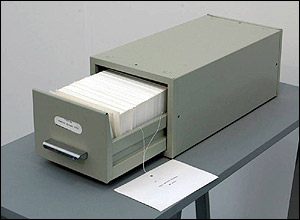
As a creative strategy it seems oddly akin to that of a neurotic bureaucrat. The first room of the exhibition, with its rows of grey metal filing cabinets stuffed with index cards and its precise records of steps taken in various cities, appears to illustrate perfectly the ‘aesthetic of administration’ commonly associated with Conceptual art. Instead of a Ministry of Silly Walks, we have a kind of Silly Ministry of Walks – a phrase I mean not as flippant insult but as a way of trying to capture the very dry humour that pervades Brouwn’s idiosyncratic archives. And if we accept humour as the flipside of bureaucratic coldness, perhaps ecstasy constitutes the unlikely reverse of Conceptual detachment: there is in his work an invitation to lose oneself in the peculiar ecstasy of measurement, in the same way that the man Brouwn evaporates into the many leagues he has trekked. To paraphrase the artist: ‘I am become a distance….’ And to amble through the Brouwn exhibition is in a sense already to participate in this work, since each room is designated ‘Portrait of a Place, the surface of the floor on which you stand at this moment’, with the relevant dimensions, of course, carefully noted.
I found it particularly fitting that a few floors above the Brouwn exhibition, the alternating male and female voices of On Kawara’s One Million Years (Past & Future) (1970– ongoing), were solemnly counting down a seemingly endless succession of years. In a happy coincidence, between Brouwn and Kawara we are confronted with those two fundaments of the universe: space and time. On this occasion what struck me most was the parallel attempts of the two artists to render these pure conceptions of experience, as philosophers would say,as concrete, handy objects; namely, books. What to make of these supremely anti-literary monuments 10 Kilometres (1975) or ‘One Million Years’ (in its incarnation as a series of books).
His conceptual works deal with distances, measurements, or spaces between two points, persons, and places, but also, in line with his most well known artist’s book This Way Brouwn, with paths. For his layout sketches, he asked passers-by he accidentally met on the street to make a sketch of from memory of certain distances they had covered. Indeed, for Stanley Brouwn, motion, dealing with distances in space and time are the primary material for his artistic activity. He examines this fundamental human activity in ever new contexts and measures distances according to his own units of measure, such as the Brouwn cubit, the Brouwn foot, or the Brouwn step. In 1976 he published his artist’s book 1m 1step, which consists of two lines—one the length of a (his) step, the other one meter long. Thus his own, subjective unit of measurement (the sb foot, the sb cubit, the sb step) is in opposition to a generally acknowledged, universal metric system or an—outdated—local unit of measurement.
Using various units of measurement, he creates portraits of people, buildings, spaces, walls, floors, etc., such as, for example, in his artist’s book Door from 1989, in which the door of the building Reguliersgracht 27 in Amsterdam is measured and depicted. Stanley Brouwn’s works are situated in the field of tension between the abstract and the generally valid and could be summed up under the postulate: people walking on the planet Earth
Since 1960, his work has been shown at nearly all of the important exhibitions, e.g., documenta 5 in 1972, documenta 6 in 1977, documenta 7 in 1982, and most recently at documenta 11 in 2002, at the MACBA in Barcelona in 2005, and at the Centre Pompidou in Paris in 2006. Since the seventies, an integral part of Stanley Brouwn’s artistic work has been the publication of books
Suggested
http://www.frieze.com/issue/review/stanley_brouwn/
http://www.cartincollection.com/subject/brouwn.html
http://www.smak.be/tentoonstelling.php?la=en&id=45
RUBY SKY STILER
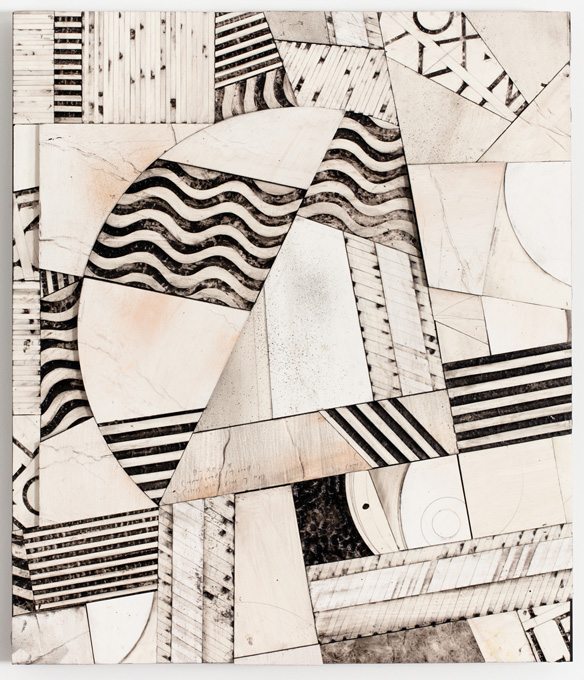
Born in 1979, Ruby Sky Stiler lives and works in Brooklyn, NY. She received her BFA from The Rhode Island School of Design and her MFA from Yale University in 2006. Stiler's solo debut in New York at Nicelle Beauchene Gallery was in May 2009. She has exhibited her work internationally, including Sandroni Rey, Los Angeles; Kantor/Feuer Window, New York; DUMBO Arts Center, Brooklyn; Annarumma, Naples, Italy; Guild & Greyshkul, New York; Sunday Gallery, New York; China Art Objects, Los Angeles; and Allston Skirt Gallery, Boston. Ruby is represented by Nicelle Beauchene Gallery, nicellebeauchene.com
The reference to classical iconography popped up in my work a few years ago. I was in Naples for a brief visit with friends, and we visited Pompeii, the formerly ash-buried Roman town–cum–tourist attraction. A controversy involving the colors of the frescoes captured our attention during our time there. Apparently “Pompeii Red,” which is synonymous with our collective sense of this historical time and place––and a standard paint-chip color––may have been an archaeological mistake. Reports stated that the original color could have been oxidized through the heat of the fire and mutated to appear red. Meanwhile, the entire site has been restored with this color in mind, which is nuts. I love this subject, which exists primarily through the lens of contemporary historians and is therefore a constantly evolving and engaging fiction. The sculptures play with authenticity and with how that quality is perceived, creates value, and can prompt an atmosphere of authority surrounding the object.
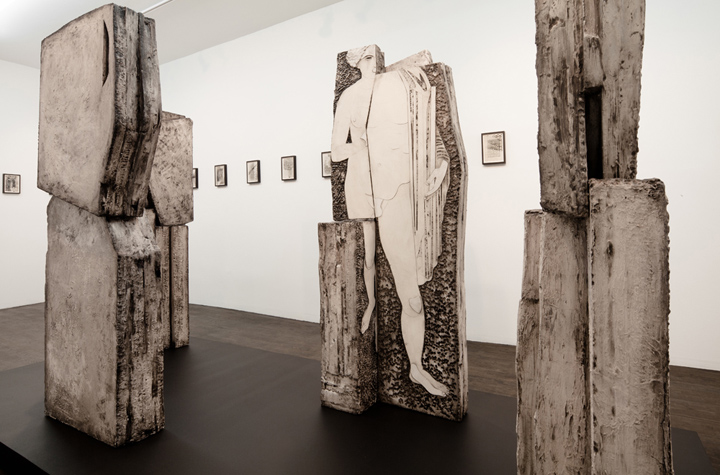
My basic process for this work is to jam together disparate parts to make a whole. I think of this as a hopeful, loving gesture: finding solutions (or a suitable repair) that will bring the figure to life out of crumbling, incomplete appendages. The sculptures are made to be viewed in the round: From one side, a classical figure is seen, while the opposite section gives off an abstract modernist vibe. The resulting sensation is that these works are referencing both ancient art history and sculpture of the twentieth century. My incorporation of shifting perspectives, varied art-historical references, gender combinations, and juxtapositions in scale encourages a sense of striving to make something work, even when one doesn’t have all the appropriate resources at one’s disposal. This activity feels like a metaphor for daily life.
The shifting line between common kitsch and singular originality is an element that interests me. On first glance, these ancient-seeming figures appear to be chiseled from marble. Looking closer, it’s clear that they are constructed from contemporary art supplies and conflate iconography that spans different centuries and societies. On the one hand, elements of these works copy from recognized ideals of art history, and in this sense, they are tacky imitations. On the other hand, however, I aim to make the sculptures’ presence feel elegant, convincing, and originally expressive.
Stiler’s sculptural forms reference and reconstruct classical iconography from artist-constructed “rubble.” The ancient-seeming silhouettes are, at first glance, authoritative in their connection to this canon of history. However, closer inspection of their mash-up elements – which conflate imagery and objects that span centuries and societies – reveal the works to be peculiar interpretations of historical reality. Stiler’s distorted quotation of the familiar and banal classical nude exposes the absence of a single, eternal “truth.”
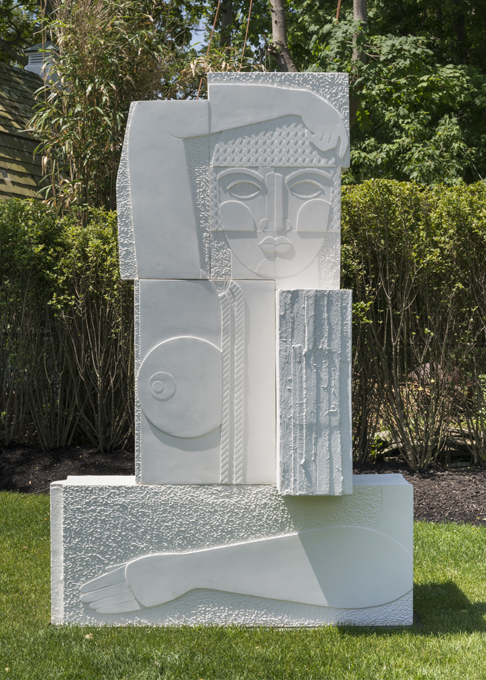
All Images Courtesy of Nicelle Beauchene Gallery, New York
Suggested
http://artforum.com/words/id=26312
http://www.huffingtonpost.com/timothy-hull/qq3-with-ruby-sky-stiler_b_823242.html
http://www.rereveal.com/id56.html
ROBERT MACPHERSON
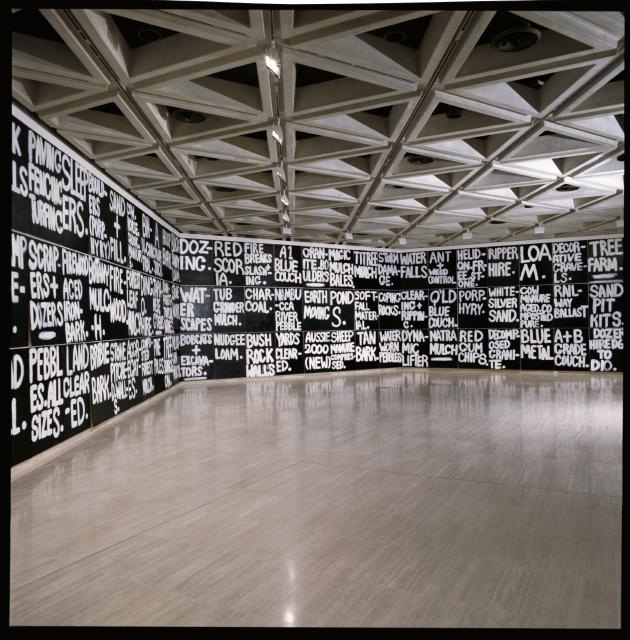
Robert MacPherson was born in 1937 in Brisbane. Macpherson has exhibited regularly, throughout Australia, since 1970. He has been included in a number of important group exhibitions and Biennales from Sharjah to Serbia to San Paolo. In 2001 his influence was celebrated through a retrospective at the Art Gallery of Western Australia, Perth and the Museum of Contemporary Art, Sydney. He began his artistic career in the late 1950s by experimenting with colour field paintings, inspired by the American abstract expressionists. This was followed in the 1970s by a series of abstract works in black and white. After this point MacPherson began to incorporate found objects, creating artworks from everyday items and materials found at a hardware shop. Many of these later works incorporate text, as the artist links words and phrases, cataloguing and classifying.
Much of MacPherson’s work draws from Australian suburbia, utalising a vocabulary of slang, colloquialism, roadside placards and shop signage. The artist will draw on things lost from cultural memory, rescuing them from obsolescence and elevating them to art.
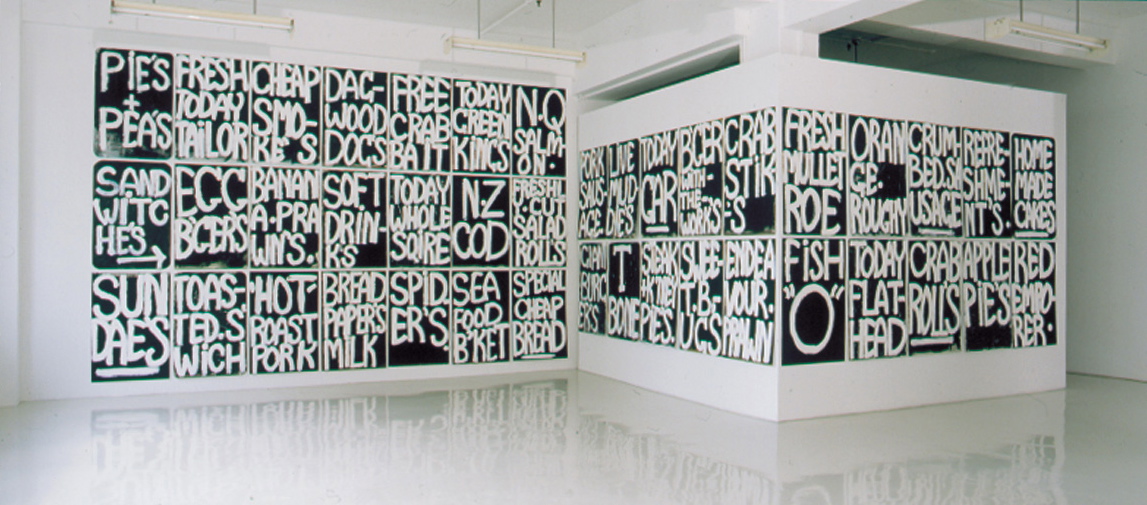
MacPherson’s earliest pieces dealt directly with the physical relationship between a person and the work of art. The dimensions of his ‘Scale From The Tool’ paintings (1976-77) relate directly to the space required by a commercial paintbrush to apply paint in a single gesture. Importantly, MacPherson used tools and materials more common to tradespeople than artists - the politics and humanism of his work were present from the start. His best known works are his massive installations which include serialised standard-sized sheets of Masonite painted with commercial paint. Chitters: A Wheelbarrow for Richard, 156 Paintings, 156 Signs, (1999-2000), for example, comprises 156 panels which are installed in three rows around the gallery wall, to create an all-enveloping landscape.
MacPherson’s work is not representational in a conventional sense. Chitters ... consists of panels which are, in a sense, facsimiles of the hand-painted signs propped at the side of the road which advertise local products in the sub-tropical environment of Queensland on Australia’s north-east coast. This mighty installation effectively describes the landscape by suggestion, but it’s still powerful. The panels include the words ‘plantation bark’, ‘sand’, ‘pebbles all sizes’, ‘palms cleaned and removed’, ‘ponds’, ‘mossy bush rocks’; the wording soft-returned to fit the dimensions of the Masonite sheets. MacPherson also ‘recreates’ roadside advertisements for roast chickens, bananas, fishing bait, strawberries and avocados. These works draw upon the drive-past narrative accumulation that is instantly recognizable to visitors and residents of regional Australia. Commentators on the artist’s work have emphasized his concern with specific languages - he has made works, for example, that refer to the language codes employed by indigenous Australians and cattle drovers, and made drawings attempting to ‘channel’ the imagination of a young country boy intent on visually describing particular types of clouds, cars and lesser-known figures in local history.
MacPherson’s work is highly coded, revealing and exploring the constructions of myriad languages such as weather-flags and fauna classification systems as much as local terms for food. However the serial nature of his work refers less to mass reproducibility than to the fact, for instance, that there are 500 species of tree frogs in the world (signalled by MacPherson as 500 boats folded from newspaper).
One of MacPherson’s central concerns is environmentalism. The unique nature of the continent of Australia is palpable and the materials he employs are sensual, but not romantic in an Arte Povera sense. His sets of flags, bird-houses, road-signs, paint-charts, socks, blankets, tablecloths and beehive-boxes conjure a systematic description of the world that is entirely legible and evocative of nature, which works because it is filtered through his concern with vernacular languages and conceptual systems.
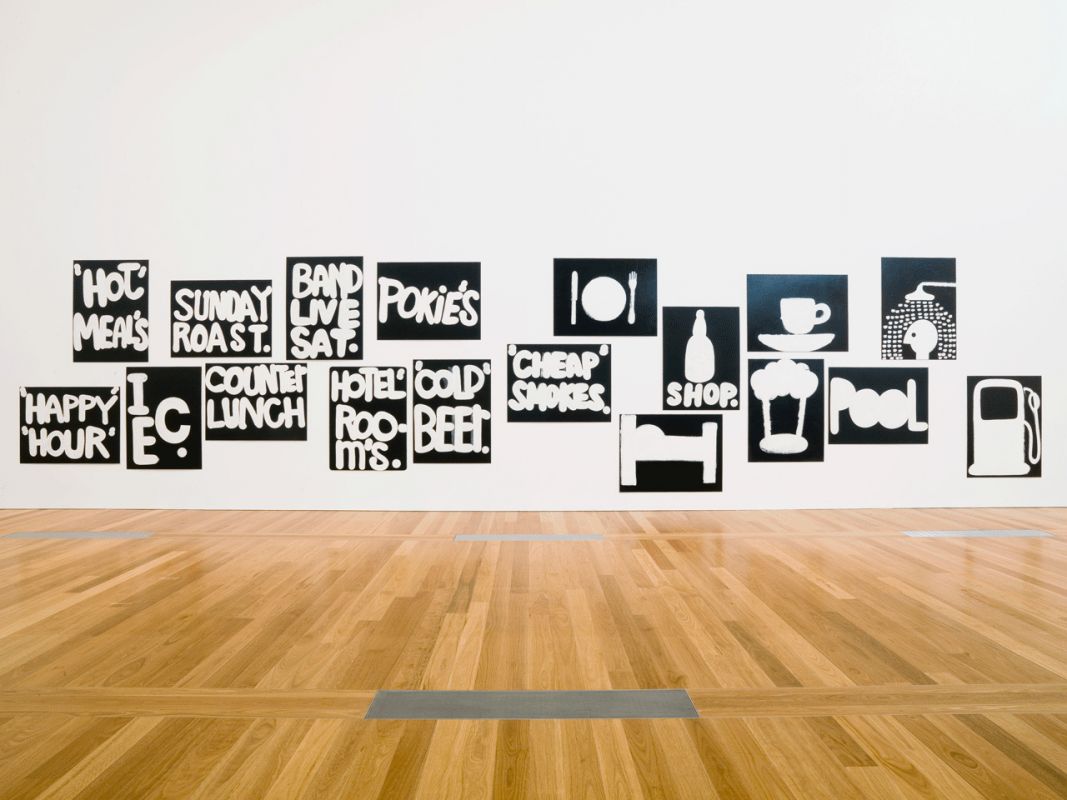
Suggested
http://www.sharjahart.org/people/people-by-alphabet/m/macpherson-robert
http://www.artgallery.nsw.gov.au/collection/works/?artist_id=macpherson-robert
DAVID MALJKOVIC
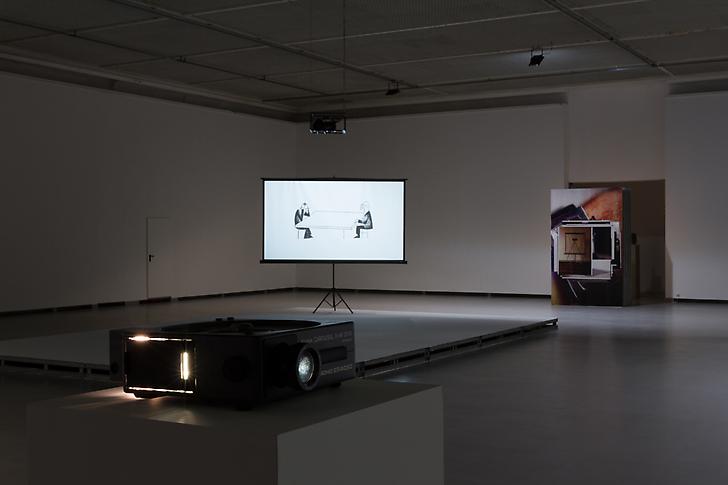
"New Reproductions," installation view, 2013. CAC Contemporary Arts Center, Vilnius
Born in 1973 in Rijeka, Croatia, David Maljkovic is known for his elegant film installations, sculptures, drawings, and photomontages, which draw on former Yugoslavia’s rich modernist legacy. After studying at the Academy of Fine Arts in Zagreb and the Cite Internationale des Arts in Paris, David Maljkovic participated in the artists' residency program of the Rijksakademie in Amsterdam. Recent solo exhibitions were, amongst others, at Kunstmuseum St. Gallen (St Gallen, CH), CAC - Contemporary Art Center (Vilnius, LT), GAMeC (Bergamo, IT), Baltic Art Centre for Contemporary Art (Gateshead, UK), Van Abbemuseum (Eindhoven, NL), Wiener Secession (Vienna, AU) and Sculpture Center (New York, US). With his work David Maljkvovic participated in a large number of group exhibitions, amongst which 'Cinema Remake' at EYE Filmmuseum (Amsterdam, NL), 'In the Cut' at ACCA Australian Centre for Contemporary Art (Melbourne, AUS), 'The Sea is My Land' at MAXXI Museum Rome (Rome, IT), 'Last Year ar Marienbad' at EFA Project Space (New York, US), 'East Side Stories, Videos Contemporaines Croates' at Palais de Tokyo (Paris, FR). David Maljkovic received the International Contemporary Art Prize Diputacio de Castello, Spain
His exhibitions include the Secession Vienna and SculptureCenter New York, the Zagreb-based artist’s past one-person exhibitions include: “Out of Projection,” Art Unlimited, Basel (2010); Museo Nacional Centro de Arte Reina Sofía, Madrid (2009-2010); Kunstverein Nürnberg, Nuremberg, Germany (2008); “Almost Here,” Kunstverein Hamburg (2007); MoMA PS1 (2007); “Scene for New Heritage Trilogy,” Whitechapel Art Gallery, London (2007); “Days Below Memory,” CAPC, Musee D’art Contemporain, Bordeaux (2007); and “Scene for New Heritage,” Van Abbemuseum, Eindhoven, Netherlands (2005). Maljkovic has participated in group shows such as: “New Festival,” Centre Georges Pompidou, Paris (2011);“Rearview Mirror,” Power Plant, Toronto (2011); “Che cosa sono le nuvole? Artworks from the Enea Righi Collection,” MUSEION Museum of Modern and Contemporary Art, Bolzano, Italy (2010); “Rehabilitation,” WIELS Contemporary Art Centre, Brussels (2010); “Mondernologies: Contemporary Artists Researching Modernity and Modernism,” MACBA Museu d’Art Contemporani, Barcelona; and “When Things Cast No Shadow,” 5th Berlin Biennial for Contemporary Art, Berlin.
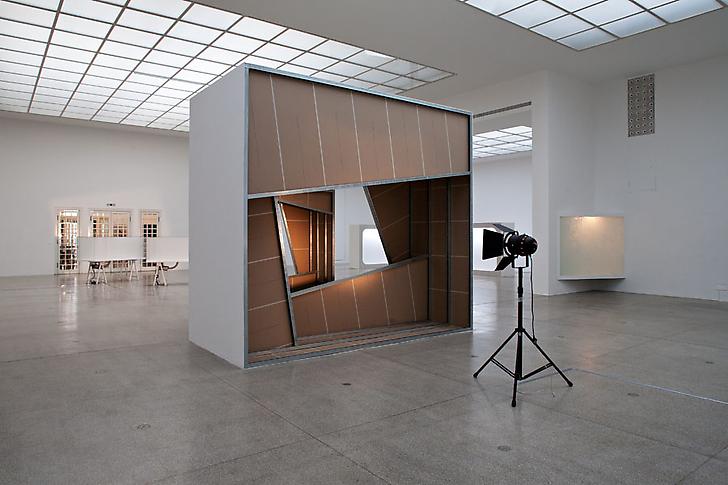
David Maljkovic art examines collective memory and amnesia in contemporary Croatia. Maljkovic's work consists of collages, installations, videos and drawings. His work incorporates images of dilapidated modernist landmarks, monuments and buildings commenting on the country's idealistic discontinuity. Erected during the communist era and left empty or deprived from its original use, these rundown monuments mark the gap between utopian heritage and disillusioned presence.
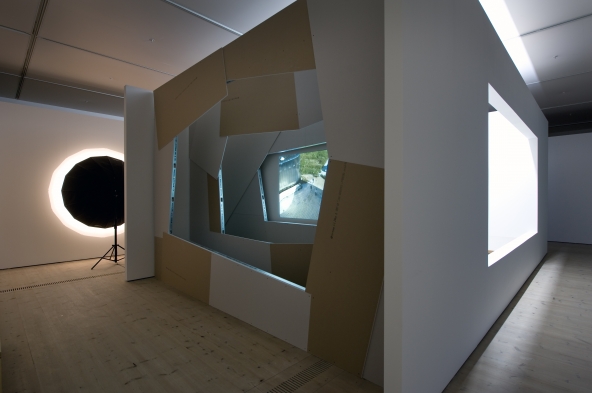
David Maljković has emerged in recent years as one of the most significant artists on the international arena, thanks to a body of works with which he investigates the cultural, social and political heritage of his country through an ongoing comparison of past, present and future, interpreted as hypothetical and interconnected dimensions of reality.
Maljković freely rearranges this material to highlight the tension between the avant-garde utopias of Yugoslavia under Tito and the potential for renewal ignored by recent national history, suspended between a collective “state” identity and a future with an uncertain cultural memory. As much as these cultural roots constitute the heart of Maljković’s research, the artist’s practice is distinguished by the freedom of the language with which he conducts a universal reflection on the mechanisms of collective memory, and by the detailed attention, he pays to the strategies and exhibitional mechanisms.
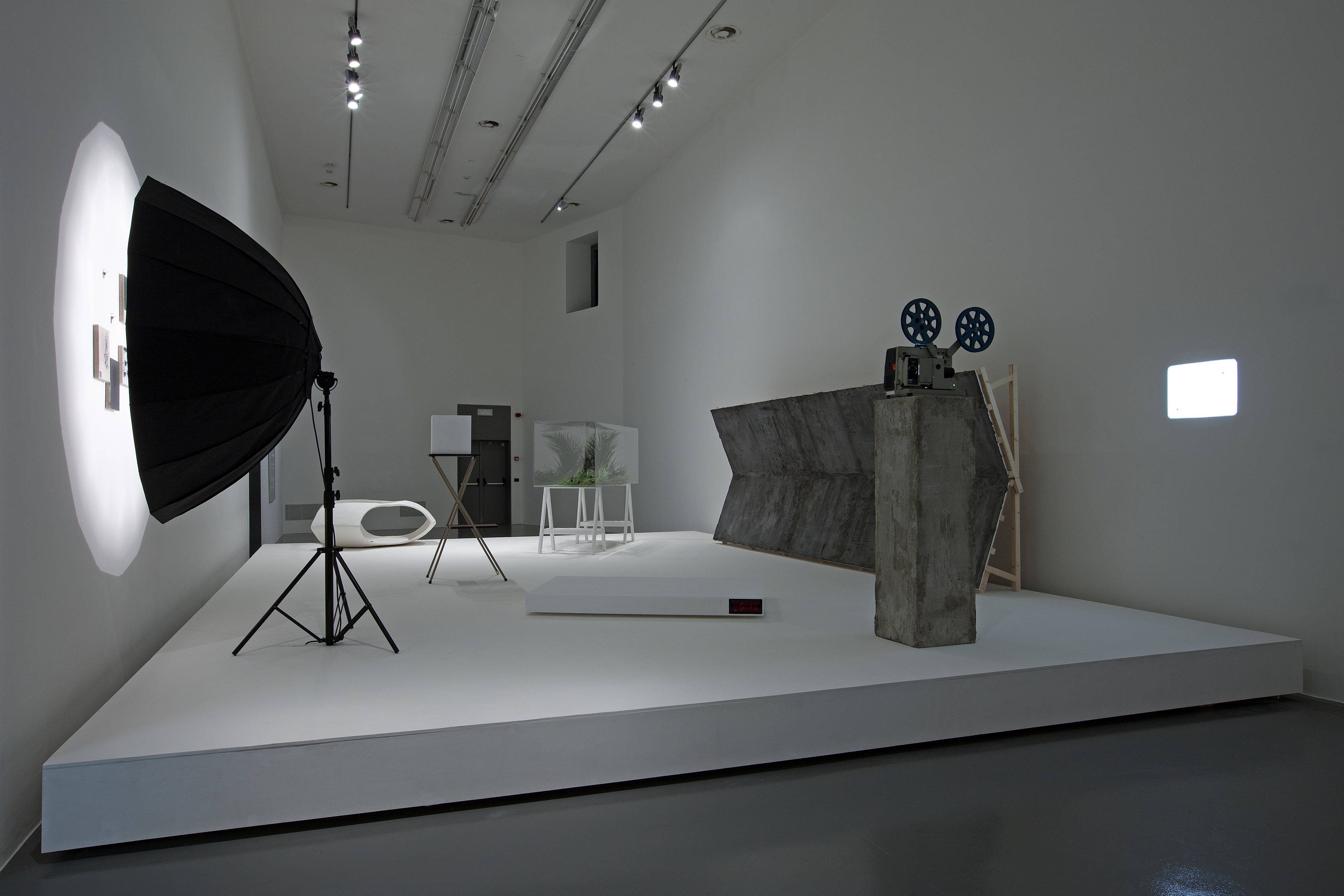
David Malijovic at GAMeC
Alongside works, such as Monochromes (2013), Lost Pavillion (2008) and the Temporary Projections series (2011), the retrospective aspect of his solo exhibition at GAMeC will be embodied by a series of photographic collages that the artist created for the exhibition in Bergamo, in which pictures of works executed by Maljković throughout his career are superimposed and almost condensed in order to construct a visual and conceptual mapping of his artistic practice. Thus, the idea of a “travelling exhibition” is critically re- examined. The works are not merely transported from one place to the next: instead, they become devices that can react to both space and time. The artist’s capacity to reflect on the mechanisms of vision, reproduction and the transmission of images overturns the concept of “retrospective” and its allegedly rigid structure.
The theme of collective amnesia often present in Maljković’s production (which includes videos, photographs and installations) is developed in the Temporary Projections series and in Monochromes. Here, the instruments used to record, reproduce and preserve memory – like film projectors and slides, photographic equipment and archival materials – are presented as silent tools, often used “against themselves” in contradiction with their functions.
For the GAMeC exhibition, Maljković has conceived an installation for presenting the works that, by dominating the rooms of the Spazio Zero, alters their perception: a stage and a series of structures will constitute a set through which visitors can interpret the retrospective path of the exhibition, understood as a dynamic mise-en-scène.
Suggested
http://www.theguardian.com/artanddesign/2010/nov/17/david-maljkovic-best-shot
http://www.annetgelink.com/artists/9-David-Maljkovic/biography/
http://www.contemporaryartdaily.com/2013/12/david-maljkovic-at-gamec/
https://www.google.com/?gws_rd=ssl#q=david+maljkovic+artist
PELAGIE GBAGUIDI

Pélagie Gbaguidi was born in Dakar, 1965, of Benin origin. She graduated from ‘l'École des Beaux Arts’ Liège, Belgium in 1995. . Pélagie Gbaguidi lives and works in Belgium. She has also had recent exhibitions in Arnhem Museum of African Art & Museum of Contemporary Art . IFA, Gallery Berlin & Stuttgart , Panafrican Festival in Algiers, Show Off Paris, Ixelles Museum Belgium, Galerie Imane Farès Paris.
Currently, she manipulates the misuse of history, the deconstruction of stereotypes, myths as open spaces and the new landscapes of a global world.
In 2008, she was invited in the program IFAA, thinking about the subject ART MIGRATION IDENTITY , she proposed this reflexion on her art:
- My Work in Progress is an utopia who question the world in which we lived. Is still and always this kind to question the human in what he is. Maybe to try to answer to this question : « with what theme do you work ? With no theme, is life a theme ? « I reflect on the mistakes of the past, to try to understand what we have fallen into ».

"As a painter, I have included matter as a dimension into the manner to perceive the real. I am at an intersection between the material and in the immaterial. It has to do with the order of breath and the unseen. Working in such a space helps me to see a different reality and to decipher my outlook, as if I was turning transparent and that, at that very moment I could merge with my surroundings… -
Recently the body of my work has evolved into frescos, in order to contemplate the signs which came to me like visions... Today, it is necessary to look upon history through different angles. My artistic engagement leads me to face the history of my origins, the history of black people through time, to better understand the cultural, social and economical issues of the world which I am part of. "

Pélagie Gbaguidi's work can be seen as an ensemble – an anthropologic frieze; using working material as painting, photo, writing, drawings, installation, as reflections of individual and collective memory.
Her stance as a "griot" is an engagement towards the collective. Her definition of "griot" is one, who through the spoken word can operate in different artistic fields, creating a link between the contemporary and traditional. Her approach to her heritage takes on a critical and innovative form. In a poetic sense, the "griot" has the power to trigger in each of us the need for introspection. He absorbs the words of the ancestors to shape them with notions of his times into a "ball of grease" that he leaves in the belly of the passer-by. In a practical sense, he breaks the commonplace rhythm, by inserting subtle incidents, integrating his part of eternity.

Boomerang", 2007, Installation© Gbaguidi
Her work is an initiatory trip into living memory and ancestral worship. Belief is extremely rooted in Africa through rituals, which place favour on the notion of the sacred, of life, and of death. It is perhaps urgent to settle this question at the striking hour of globalisation. This philosophical and spiritual concept finds a universal echo today.
Suggested
http://www.imanefares.com/lartistebio_en.php?IDartiste=8
http://www.themojogallery.com/asitis/artist-pelagie.php
ROBERT MITCHELL & RANDOLPH MATTHEWS
Pianist Robert Mitchell lines up with vocalist and beatboxer Randolph Matthews for a new partnership focusing on combined improv. Mitchell has eight albums to his name and most recently created the Leftitude festival, which celebrates left hand-only piano, while Matthews is known for his jazz, soul and ethnic beatboxing skills. Pianist Robert Mitchell has released eight albums, toured internationally and is a Steinway Artist. He is also a creator of piano festivals – at his latest, Leftitude, pianists gather to perform left hand only. He often performs with his band Panacea, and is currently also working with Jhelisa, HKB FiNN, Carina Anderson and Tom Harrison. Randolph Matthews' blend of jazz, soul and ethnic beatbox, mixing in live looping and a sharp wit, has been described as 'beautiful, unhurried, splendidly languorous and unashamedly spiritual.
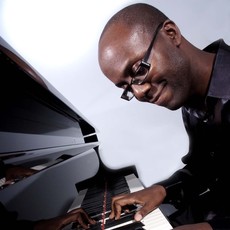
Born in Illforsd , Essex , Robert Mitchell has forged a formidable reputation as a gifted pianist and composer. As part of the F-ire Collective, Robert won the Jazz on 3 Innovation Award at the 2004 BBC Jazz Awards; he has also been nominated twice: for Rising Star in 2002, and Best New Work in 2003. He has played/recorded with musicians such as Norman Winstone, Steve Coleman, greg Osby, Courtney Pine, Steve Williamson, Iain Ballamy, Mark Wingfield, Jeremy Stacey, David Lyttle, Ty, 2 Banks of 4, and IG Culture, in addition to leading the 4/6-piece Panacea, his trio (with Richard Spaven and Tom Mason), performing in duo with Omar Puente (Bridges), and performing as a solo pianist.
Mitchell studied at City University and the Guildhall School of Music and Drama. Early band memberships included Tomorrow's Warriors and Gary Crosby's Nu Troop, plus award-winning bands Quite Sane and J-Life.
Panacea first performed in 2000, and have performed in the London Jazz Festival, Manchester Jazz Festival, Cheltenham Jazz Festival (Pillar Room), and the North Sea Jazz Festival(2006), and Vienne Jazz Festival (2008) and in such venues as the Pizza Express, Jazz Cafe, The Wardrobe, The Spin, The Spitz, Le Tavernier and Cargo. It released its debut album Voyager on the Dune label in 2001. Its second album, Trust, was released on F-IRE in 2005. In March 2006, the band recorded a session for BBC Radio 1's Gilles Peterson Worldwide show. The band was subsequently nominated for Session Of The Year at the 2006 Gilles Peterson Worldwide Awards.
The duo with Cuban violinist Omar Puente began in 2003. The performance of this duo in the Havana International Jazz Festival (2004) resulted in a TV programme being made about the pair for Cuban TV (A TODO JAZZ 2005). The debut album Bridges was released in 2006 on F-IRE. They have also performed to great acclaim in Morocco and Belgium, as well as the UK.
Mitchell's solo album, Equinox, was originally a BBC Radio 3/Jerwood commission, and was released in 2007. It was nominated for Best Work at the BBC Jazz Awards (2003). It was launched at Lifting The Lid, a three-day celebration of modern solo jazz piano instigated, organised and curated by Mitchell. He has performed solo in Sweden, Belgium, Latvia and across the UK. He opened for Wayne Shorter in Brighton in 2003 (at the Dome), and Branford Marsalis in the same year (at the Barbican, London).
Robert Mitchell 3io grew out of the long-running band Panacea. It features Tom Mason (on bass) and Richard Spaven (on drums). After starting in around 2003/04, it released its debut album The Greater Good in late 2008 (33Rec/Jazz Services). The trio also tour the UK during the same period.
In September 2011 the album Embrace was released. Reviewing the album for the BBC, Kevin Le Gendre wrote: "Mitchell’s command of avant-garde and mainstream piano vocabulary is impeccable."
Mitchell is working with singer Jhelisa Anderson (cousin of Carleen), Dan Stern (saxophonist, clarinettist and composer), and Yolanda Charles (bassist and singer), among others.
Since 2003, Mitchell has been a visiting composer at the Royal Academy of Music Jazz Department. His education work has also included projects at WAC, City University, Middlesex University, and as solo, ensemble teacher and examiner on the jazz course at The Royal Academy Of Music.
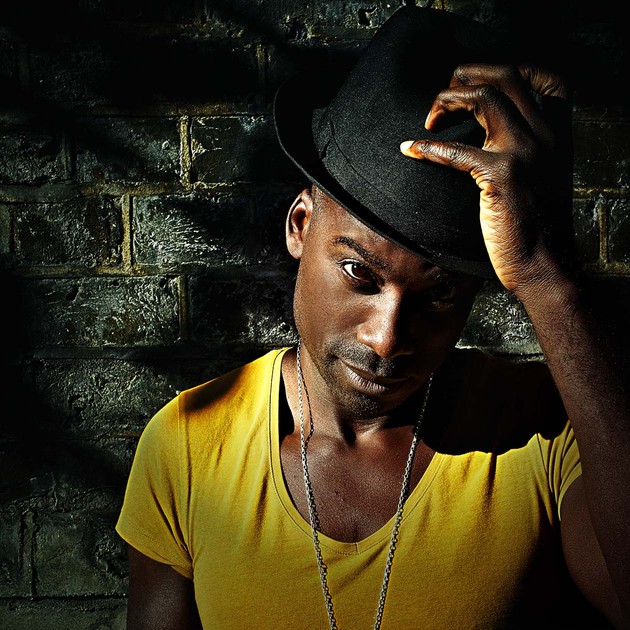
RANDOLPH MATTHEWS describes his music as an evolving journey, rooted in purity and unshackled expression, drawing from the greats of Youssou n'dour, Seal and Bobby McFerrin Randolph reflects on when it started I fell in love with music when I was seven years old, with two tape recorders in my bedroom. My mum loved singing while cooking down stairs, so I learnt to layer up voices and beats upstairs which, over time, got a bit lost during my teens. At 21, I left work as a telecommunication engineer to follow my heart and passion and pursue music as a career, re-kindling the layering voices I had learnt as a kid”
This early music schooling evolved in to Randolph soaking up London’s burgeoning late-‘80s soul-jazz scene, including regular trips to Norman Jay’s feted sessions at Hoxton’s Bass Clef. A career in music soon followed. He started out as a percussionist before finding his true vocation as a talented live vocalist, performer and lyricist. By the 1990s he was performing and leading backing vocals for the likes of US soul / boogie legend Don Blackman, recording with Arthur Baker on tracks for Brooklyn’s soul legend, Will Downing.
After and extensive period of collaboration Randolph went solo in 2006 to exercise the sounds he was still hearing he need to get out and it wasn’t long before the year saw Matthews sign his first record contract and release his debut “I Love” with Documented. An aurally delicious blend of emotive words, chants inspired by progressive beats, produced by Tony Nwachuku (CDR/NEPA) and raw melodies, it was a promising experiment, for turning vocal emotions into something tangible. “ I felt so vulnerable creating this, but it was the right type of pain that comes with singing out what you feel is real to you “It gained a loyal following, being picked up by Vocab Dance Company performing his single Canvas in there sold out Kwenda Kwenda tour and collaborations with German producers Seasons and Sygaire (Sonar Kolletiv), and release of track Open to Love by Radio 1 tastemaker Giles Peterson’s for his double boogie compilation “In Da House”
Randolph took his time to listen to inspirational soloist such Keith Jarrett, Pat Methney and Bobby Mcferrin before his next release in 2011 of co produced world beat album Precious. Tracks reflect intimate and expansive delivery that oozes through the songs layers with unique twists and turns of ethnic beat box. Combinations of unusual arrangements in 3 Peckham Lane, hypnotic hang drum playing in Rise and sensitive production touches throughout come courtesy of dub /electronica producer Seb Taylor (Kaya project interchill records).
Randolph’s unique blend of Jazz, soul and ethnic beatbox has him following his love for interactive performance around the globe with a string of established artist in the last few years such as Plan B, Grace Jones, Shlomo (Edinburgh fringe tour) and world music artist Seun Kuti plus regular performance for the London Jazz festival and Ronnie Scotts Jazz audiences. His recent collaboration with Young voices choir took Randolph with 6,000 children up and down England from Manchester arena to the Royal Albert Hall performing to more than 500,000 people over two years alongside Alexandra burke, Beverley Knight and Irish folk singers The High Kings.” I love performing and use it as an opportunity to reject the predictable boundaries of vocal expression and get to the heart of what moves us in a performance space its just mind-blowing!
Last year Randolph ‘Voce Solo’ toured, London, UK and European.Randolph's solos show took the audiences on an organically magical journey through his precious album material, edge of the seat improvisation and witty stories whilst technology layers his voice. Special guests are expected on the tour. As though sound is erupting from within him, a musical volcano of clicks and glottal stops, Jazz percussive melodies and songs composed out of audience members names. You cannot simply watch him perform; you and Randolph become the performance together. Matthews says “When I am introduced on stage, the wording is always ‘Randolph does his thing…so without further ado, here is his thing…’ Whats that ‘thing’ is dependent on the day and the audience.” One thing's for sure you will most definitely have a unique experience everytime.Look out for this years collaborations and new album releases…Waka Waka
Suggested
http://www.youtube.com/watch?v=Ev97CmQUozI
http://www.youtube.com/watch?v=SluGenDJbU8
http://www.youtube.com/watch?v=pBmt_Z2tRE4
JIM LEE
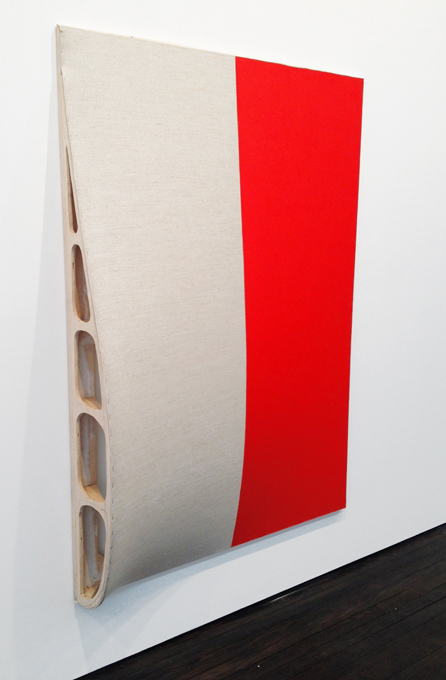
Born in Michigan, USA Born in 1970 Lives and works in Brooklyn, NY EDUCATION 1996 MFA, University of Delaware, Newark, DE 1993 BA, Hope College, Holland, He is represented by Nicelle Beauchene , New York
Jim Lee’s work is a meditation on the inherent properties of creation. It emphasizes basic formal convictions, such as Structure, color, and space, while simultaneously eradicating the boundaries and preciousness of those conventions at every turn. The pairing of these disparate parts, where sentimentality meets rhetoric, and playfulness confronts austerity, supplemented by a craftsman’s deftness, guides Lee in and out of painting’s legacy. He pulls apart and screws together his formative non-objective art influences as means of re-interpreting the world.
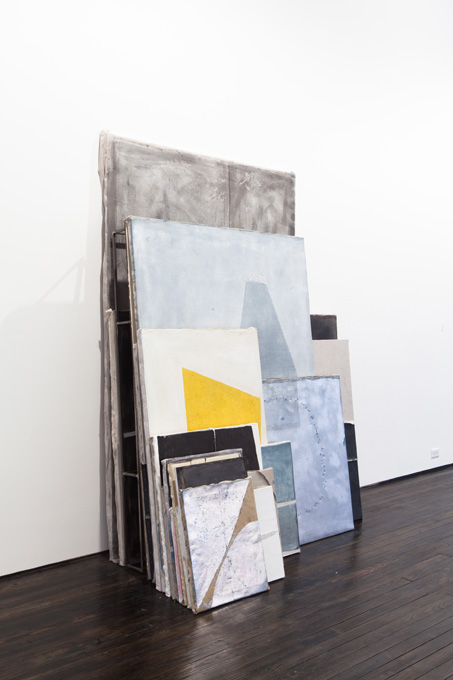
"I’d say my influences run all over the place, from Titian to the everyday basement craftsmen. I’m easily blown away by the lighting in a Goya painting yet also enamored with the gas cap of a ’64 Pontiac. In terms of significant artists, I mean there are too many to name. The brutal elegance of Marlene Dumas, John McCracken and his shiny slabs, Ellsworth Kelly, Newman’s Onement, Palermo—the list goes on, but when someone asks me who my favorite artist is...I always say Gordon Matta Clark. I know my work has nothing to do with his but I just love the generosity that I feel in his work and can only hope that my work could generate a response that powerful in someone else. "
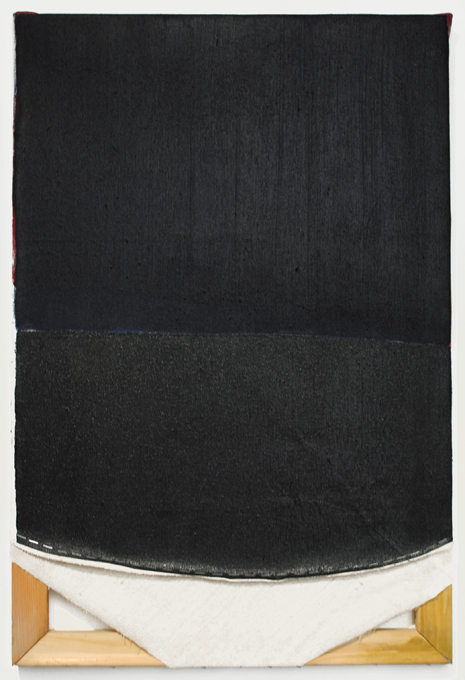
Jim Lee series of new sculpture/painting hybrids that reflect his quirky brand of humor and present themselves as abstract solutions that slip in and out of recognition. Glossy surfaces, exposed three-dimensional wood skeletons set behind canvas, a stretcher bar on loan as a sculptural component and calculated brushstrokes that emulate texture are all elements that emerge throughout the gallery space. Lee’s creations give faithful attention to the nuances of production, surface and effect but without the implied self-consciousness.
An obsessive collector of industrial and consumer detritus, Lee fashions from these materials sly and innocuous objects that demand close inspection. His love for potent visual flavor manifests within these uniquely assembled pieces. Foul and chance enter in as conditions of the work and operate as vehicles for signature or sentiment. Sharp titles, sports reference and punky gestures, all employed frequently by Lee, threaten to negate the work’s seeming aesthetic austerity. Art historical references are evident as the works take their cue from a long list or peripheral influences such as Blinky Palermo and Ree Morton.
Suggested
http://painters-table.com/link/painters-bread/jim-lee-interview
http://www.paintersbread.com/2012/11/jim-lee-interview.html
http://www.13waysoflookingatpainting.com/2013/04/jim-lee-at-nicelle-beauchene.html
http://www.freightandvolume.com/exhibitions/jim-lee-altamont
RIKKI BEADLE- BLAIR
Born and raised by his lesbian mother in South East London, Rikki learned to read at the age of three and wrote his first play aged seven, moving on to direction at the age of 11. He attended the experimental Bermondsey Lampost Free School, where he could study any subject he liked and focused on theatre and film making.
Named several years running on the Inependent on Sunday’s Pink List as one the 100 most influential gay people in Britain, Rikki has a life-long commitment to creating challenging, transformative entertainment in the mediums of film, theatre, music, television, radio, dance and design. He created the production company "Team Angelica" to pursue these goals and share opportunities with performers, artists and practitioners from the widest possible range of backgrounds.
Rikki wrote Stonewall for BBC Films. Directed by Nigel Finch, Stonewall went on to win the audience awards at the London Film Festival and the San Francisco Lesbian and Gay film Festival .
Born and raised by his lesbian mother in South East London, Rikki learned to read at the age of three and wrote his first play aged seven, moving on to direction at the age of 11. He attended the experimental Bermondsey Lampost Free School, where he could study any subject he liked and focused on theatre and film making.
Named several years running on the Independent on Sunday’s Pink List as one the 100 most influential gay people in Britain, Rikki has a life-long commitment to creating challenging, transformative entertainment in the mediums of film, theatre, music, television, radio, dance and design. He created the production company "Team Angelica" to pursue these goals and share opportunities with performers, artists and practitioners from the widest possible range of backgrounds.
Rikki wrote Stonewall for BBC Films. Directed by Nigel Finch, Stonewall went on to win the audience awards at the London Film Festival and the San Francisco Lesbian and Gay film Festival as well as an award for Rikki at Outfest LA for Outstanding Screenwriting.
Among other television projects, Rikki wrote, directed and featured in the internationally successful Channel 4 series "Metrosexuality", also composing the soundtrack.
His radio documentary, "The Roots of Homophobia" was awarded the Sony Award for Best Documentary Feature.
He was a writer and the executive story editor for the US tv series, "Noah's Arc", and was supervising director of debut films with first-time gay filmmakers as a director for the "Out in Africa" organization in South Africa.
Recently Rikki directed The short film "Souljah" by John Gordon, about a transgendered former child soldier, which won Best Film at the Rushes London Short Film Festival.
Rikki works extensively in theatre — creating 18 new plays in the last six years, including "Bashment", "Familyman", "TwothousandandSex" the stage version of "Stonewall" and most recently, "Shalom Baby" about a black man and Jewish girl who fall in love in Nazi Germany and are deported to a concentration camp.
In the last three years, Rikki has directed three successful feature films for his company Team Angelica: "Fit" about teenage sexuality and homophobic bullying which was distributed to every school in the UK and has become a phenomenon with screenings world-wide and "KickOf f a comedy about a football match between a gay and straight football team; along with several more short films, including "Gently", "7 Dials", "Thrive", "Alive", and "Butterfly" commissioned by the Royal Albert Hall.
Rikki is currently working on his next Feature film "Taken In". A thriller set in the world of homeless youth.
Suggested
http://www.imdb.com/name/nm0086333/
JOHN AKOMFRAH
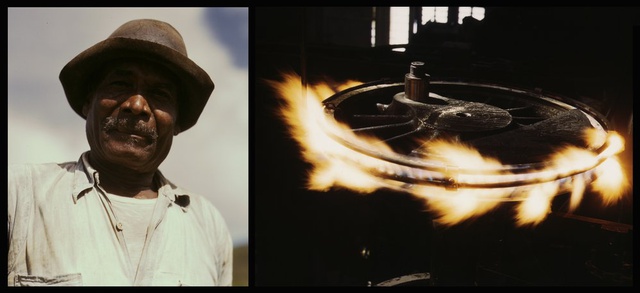
John Akomfrah, is widely recognised as one of Britain's most expansive and intellectually rewarding film-maker. For the last 30 years John Akomfrah has been committed to giving a voice and a presence to the legacy of the African Diaspora in Europe; to fill in the voids in history by digging into historical archives to create film essays and speculative fictional stories about past lives. His poetic and polyphonic films create sensual visual and audio experiences while developing a filmic language to understand the trauma and sense of alienation of displaced subjects; one that moves away from the rhetoric of resentment to propose new agents and perspectives.
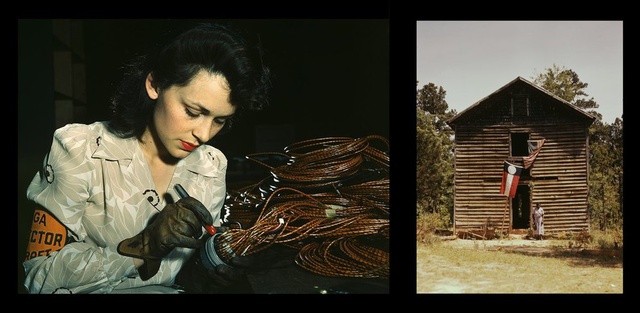
Born in 1957, John Akomfrah lives and works in London. An artist, lecturer, and writer, as well as a filmmaker, his work is among the most distinctive in the contemporary British art world. Akomfrah is well known for his work with the London-based media workshop Black Audio Film Collective, which he co-founded in 1982, together with Lina Gopaul, Avril Johnson, Reece Auguiste, Trevor Mathison, David Lawson and Edward George. Since 1998, Akomfrah has work primarily within the independent film and television production companies, Smoking Dogs Films, (London) and Creation Rebel Films (Accra).

An edited version of Nine Muses conceived for the gallery space. Mnemosyne is a contemporary version of Homer's Odyssey, with Telemachus setting off on an epic journey in search of his lost father. Divided into nine overlapping musical chapters, the film references authors from Sophocles to Emily Dickinson and James Joyce, retelling the history of mass migration to post-war Britain through the lens of the Homeric epic. A Smoking Dogs Film Production in association with BBC, and Arts Council England
Alongside Akomfrah's successful career in cinema and television, his work has been widely shown in museums and galleries including Documenta 11, Kassel; the De Balie, Amsterdam; Centre Pompidou, Paris; the Serpentine Gallery and Whitechapel Art Gallery, London; and the Museum of Modern Art, New York. A major retrospective of Akomfrah's gallery-based work with the Black Audio Film Collective premiered at FACT, Liverpool and Arnolfini, Bristol in 2007. His films have been included in international film festivals such as Cannes, Toronto and Sundance, among others. In 2008, he was appointed Officer of the Order of the British Empire (OBE). In March 2012, he was awarded the European Cultural Foundation's Princess Margriet Award.
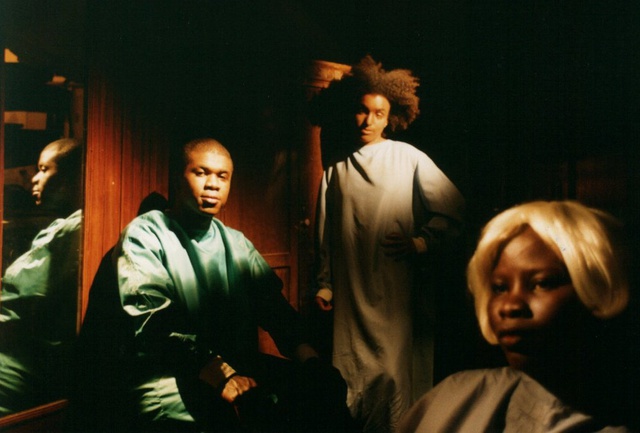
Memory Room 451 is a bitter fable of a world in which dreams become the media platform of the future century and time travel is shiftwork in the graveyards of tomorrow. In its silhouettes, shadow, depth of field and chromatic stylisation, Memory Room 451 is the most extreme example of the neo-Expressionist aesthetic the Collective pursued throughout the 1990s. Produced by Black Audio Film Collective in association with ZDF, ArteTV
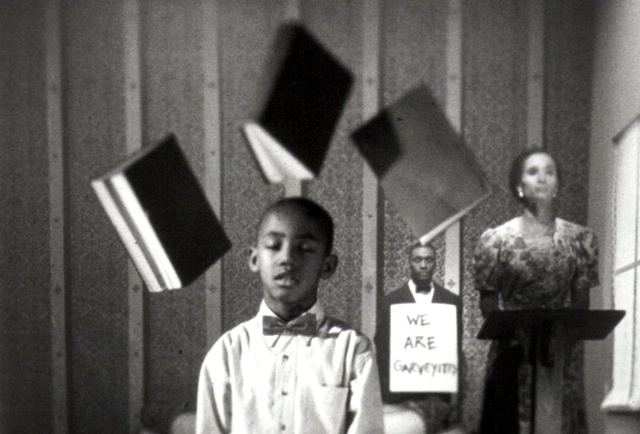
A detailed documentary film about the life of Malcolm X, the influential civil rights activist who was assassinated in 1965. Akomfrah’s seventh film envisioned the death and life of the African American revolutionary as a seven-part study in iconography. Narrated by novelist Toni Cade Bambara and actor Giancarlo Espesito. The stylized tableaux vivants that memorialise Malcolm’s life referenced the early 20th century funeral photography of James Van der Zee’s The Harlem Book of the Dead and the elemental static cinematography of Sergei Paradjanov’s The Colour of Pomegranates. Produced by Black Audio Film Collective in association with Channel Four TV
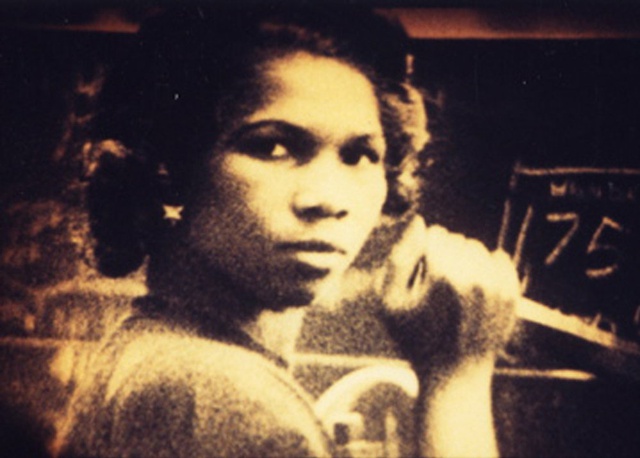
A film essay on race and civil disorder in 1980's Britain and the inner city riots of 1985. Handsworth Songs takes as its point of departure the civil disturbances of September and October 1985 in the Birmingham district of Handsworth and in the urban centres of London. Running throughout Handsworth Songs is the idea that the riots were the outcome of a protracted suppression by British society of black presence. The film portrays civil disorder as an opening onto a secret history of dissatisfaction that is connected to the national drama of industrial decline. The ‘Songs’ of the title do not reference musicality but instead invokes the idea of documentary as a poetic montage of associations familiar from the British documentary cinema of John Grierson and Humphrey Jennings. Produced by Black Audio Film Collective
The Stuart Hall Project (2012) is a film on the cultural theorist and sociologist Stuart Hall. Directed by John Akomfrah and produced by Lina Gopaul, the film debuted at the Sundance Film Festival in Jan. 2013. Through archival footage, television excerpts, family photographs and music, Akomfrah’s portrayal of Hall's life, work and cultural impact explores issues of identity, cultural acceptance, immigration and assimilation. In this lecture, the filmmakers reflected on the film’s cultural and technological context.
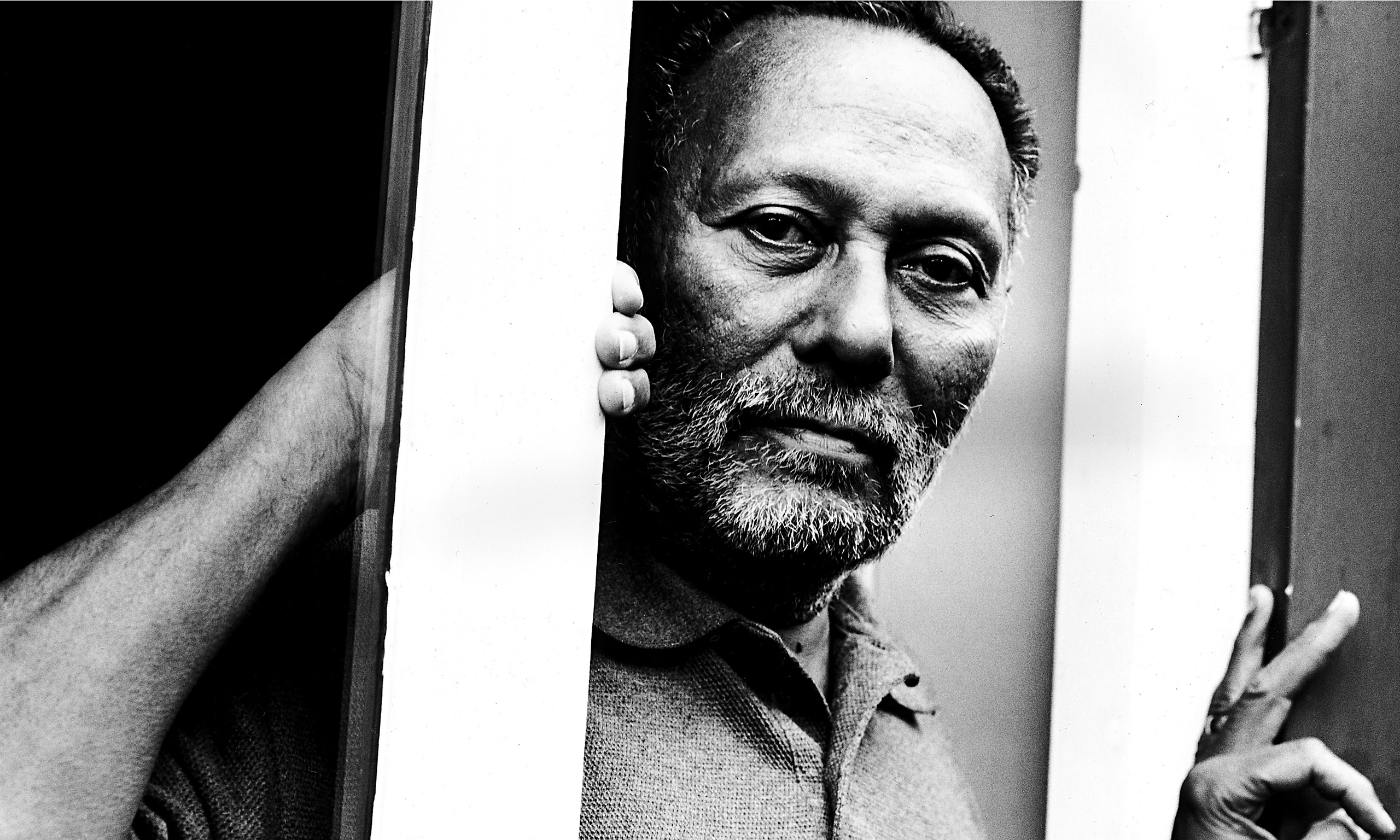
Akomfrah is skilled at identifying and dismissing things that don't interest him or that he feels don't belong in his films. It seems that many artists who plunder the archive for material can end up somewhat disheartened by the dormant nature of the material, as if weighed down by the sheer volume and breadth of the recordings at hand. But for Akomfrah the use of the archive is not only about following the endless journey of its index, but also the endless process of its indexing, where the artist must question and reinterpret the previous realities made from its materials: “We spent a couple of years being doom and gloom, but I actually think that this is a really interesting moment, a really good moment, there's sort of a return to radical contingency. Suddenly everyone's stopped worrying about being Stephen Frears or Ken Loach. And I think that commitment to radical contingency, or indeterminacy is one of the defining features of the moment. Increasingly the reality for a whole number of people [is] that you can move between the gallery, the museum, the art world, new cinema, alternative .
Suggested
http://www.carrollfletcher.com/artists/40-John-Akomfrah/biography/
http://www.carrollfletcher.com/artists/40/works/1719/
http://www.theguardian.com/film/2012/jan/20/john-akomfrah-migration-memory
http://arts.mit.edu/va/files/John-Akomfrah-Bio.pdf
BERYL KOROT
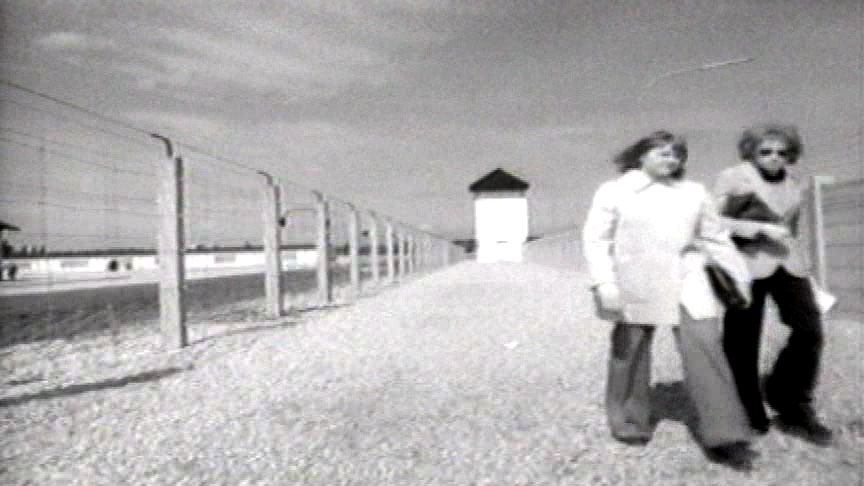
Beryl Korot’s video installation Dachau 1974 explores themes of history and memory through the interweaving of images across multiple screens.
Beryl Korot was born in 1945 in New York, where she lives and works.
Korot is one of the pioneers of video art. In the early 1970s, she was the editor of the journal Radical Software, which explored the technical and artistic possibilities of the new medium, and in 1976 published the first anthology of writing on the subject. While many of her colleagues used video’s function of simultaneous recording and playback to explore ideas of immediacy, Korot’s own work connected video to weaving, looking at the scanned lines of information on the screen.
In 1974, Korot recorded footage around the concentration camp at Dachau, outside Munich. She edited these poignant images into short repeating clips of different durations, which she arranged in two pairs playing out of sync across four monitors. The footage on the first screen reappears on the third, and the footage on the second screen reappears on the fourth. This compositional process relates to the impersonal permutational structures of minimalist art and musical techniques such as phasing, developed by the musician Steve Reich.
Dachau 1974 was one of the first video works about a historical site. Korot used her weaving structure to avoid sentimentality while at the same time creating an allegory of the workings of memory, as images disappear and reappear, as fragile as they are insistent.
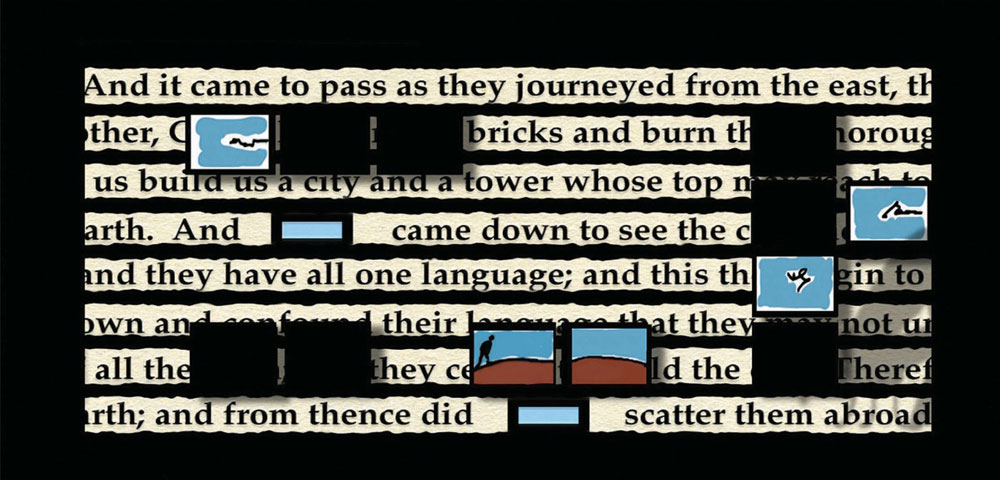
Text/Weave/Line," 2011
Korot explores the physical mark of human history and programmatic structures of data. The rhythmic impulse in her compositions embraces text, weaving, and video.
Korot was co-editor of Radical Software, the first publication to discuss the possibilities of video in 1970, as well as Video Art, authored with Ira Schneider in 1976. Her study of the technology of the loom, in 1974, marks a critical shift in her own investigations and played a significant role as a thinking tool in her subsequent video work.
Her first multiple-channel works, “Text and Commentary” and “Dachau 74”, are groundbreaking efforts that moved the video medium beyond the television’s frame and into a vocabulary of installation. By 1980, these and earlier works were featured at Dokumenta 6, The Kitchen, Leo Castelli Gallery, The Everson Museum, The Whitney Museum of American Art, among others and was featured in Video Viewpoints at the Museum of Modern Art. Later interested in painting and language development, Korot exhibited text based hand-woven canvases at the John Weber Gallery in 1986, and at the Carnegie Museum in 1990. Most recently, the Aldrich Museum of Contemporary Art presented a retrospective, “Beryl Korot: Text/Weave/Line – Video, 1977-2010”.
Bringing video art into a theatrical context, Korot began a collaborative period with composer Steve Reich in 1989. The Cave (1993) and Three Tales (2002) were first presented in major performance festivals throughout the world including London, Amsterdam, Paris, Vienna, Torino, Berlin, Hong Kong, Perth and New York and continue to be performed. In addition to performance venues The Cave was also a video installation at The Whitney Museum, the Carnegie Museum, The Musee d’Ascq, Lille, France, the Dusseldorf Kunstverein, the Reina Sofia, Madrid and the ICC Gallery in Japan.
Through her use of weaving as a medium, Korot links information processing and communications systems both past and future. She recognized how the Jacquard loom, which made modern weaving possible through the use of punch cards to guide the hooks and harness for the weave’s design, was a kind of proto-computer. Focusing on the importance of line as the organizer of information across time, Korot has observed how “we read line by line, weavers create their patterns line by line, (and) electronic cameras read an image at 30 frames per second”. This can be extended to computers, which use lines of data to perform their operations. Korot stimulates us to see how an object—the weaving—can both encode the history of a culture and reflect the personal mark of the artist, something she herself accomplishes even in technologically based works.
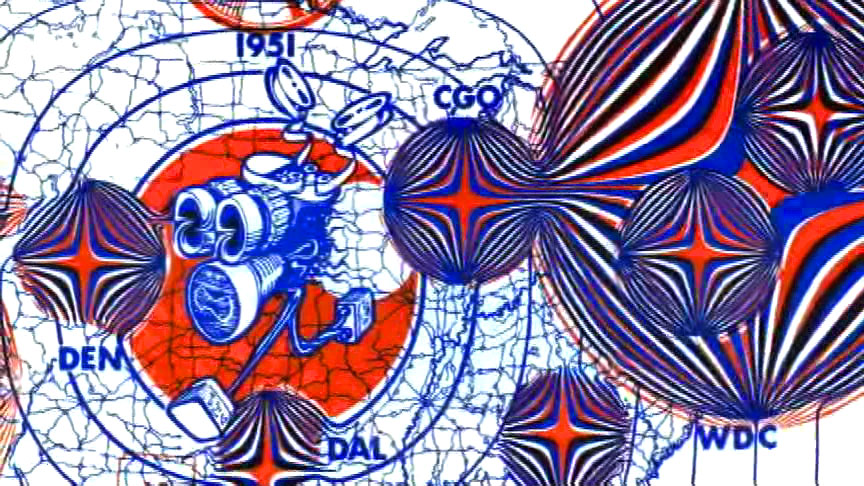
Radical Software ( still)
Suggested
http://www.aldrichart.org/exhibitions/past/korot.php
http://www.artcritical.com/2012/05/02/beryl-korot/
http://rhizome.org/discuss/46468/
LAURA BUCKLEY
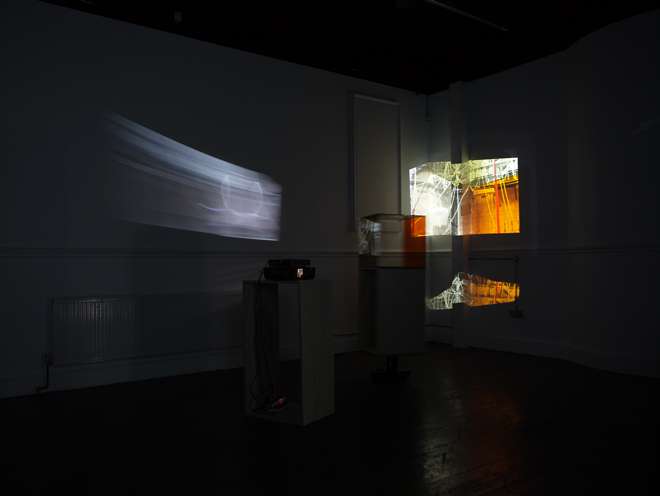
Laura Buckley, Mechanical Poem (2007)
LAURA BUCKLEY was born in Galway, Ireland, in 1977. She currently lives and works in London, UK.
Buckley is renowned for her all encompassing, sound, light and video projected installations. Buckley’s work has been exhibited widely in the UK and abroad. Recent solo shows include Fata Morgana, Cell Project Space, London, 2012; The Mean Reds, Supplement, London, 2011; and Waterlilies, mothers tankstation, Dublin, 2010. Group shows include S.A.G.S, The Woodmill, London, 2011; The Dissolution of Time and Space, Kunstverein Ludwigsburg, 2011; Converse/Dazed Emerging Artist Prize, Stephen Freidman Gallery, London, 2010; Lightbox, Volta 6, Basel, 2010; It’s A Sin: The Derek Jarman Film Programme, The Serpentine Gallery, London, 2008; Material Presence, Zabludowicz Collection, London, 2008; and Future Map, The Arts Gallery, London, 2007.
In Mechanical Poem, Laura Buckley draws on the painterly techniques she developed during her early career, transferring them to sculpture and moving image work to create a physical and visual presence from light rather than paint. In Cubic 1, rotating reflective surfaces throw a projection around the space, casting distorted versions of the original digital video onto the walls and other sculptures. In Cubic 2, Buckley incorporates the projector into the sculpture, revealing the materials and processes that make up the work.
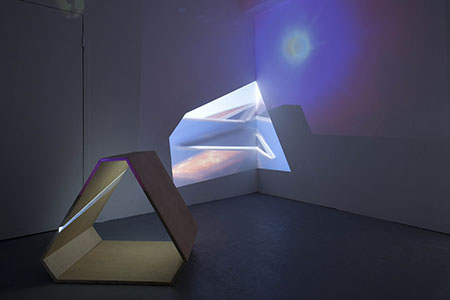
Originally trained as a painter Buckley now builds upon her experimentation with image making via techniques of scanning. Her recent investigations into the abilities of a flatbed scanner to record objects in motion are entitled Moving Image Series and are included alongside the more overtly sculptural work. By moving readymade and assembled sculptures over the bed of the machine she allows the mobile lens of the scanner to capture their foreshortened surfaces and movement. For Fata Morgana, Buckley has used the most basic form of animation – filming a still image by scrolling it in-front of the cameras lens - in much the same way the objects themselves were moved before the lens of the scanner. Thereby transferring them between sculpture and moving image work to create a physical and visual presence from light rather than paint.
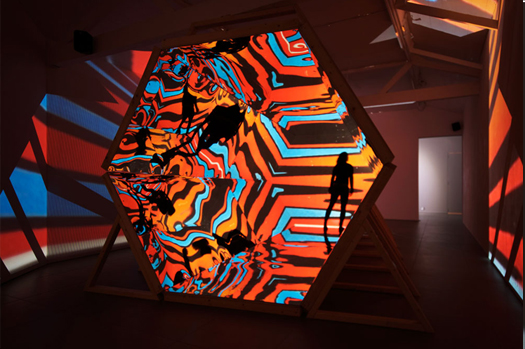
I rarely have very rigid plans when installing, so I improvise a lot over a few days with various videos on various projectors and moving the structures around. Also I edit the films up to the last minute, normally finishing them just before a show opens. I like to see how they work in the space before I finish them or decide on the final combination of videos. So it’s always quite a last minute affair. Once the work is installed and I see the reactions on the viewer’s face that’s the best feeling. It’s wonderful to ignite such joyful and openly happy facial expressions, regardless of age. My children are often with me when I’m making my work and I love how children can engage with and play in my work.-LB
Suggested
http://www.laurabuckley.com/open.html
http://www.frieze.com/issue/review/laura-buckley/
http://cellprojects.org/content/laura-buckley-0
http://bmoreart.com/2014/02/bart-oreilly-interviews-laura-buckley.html